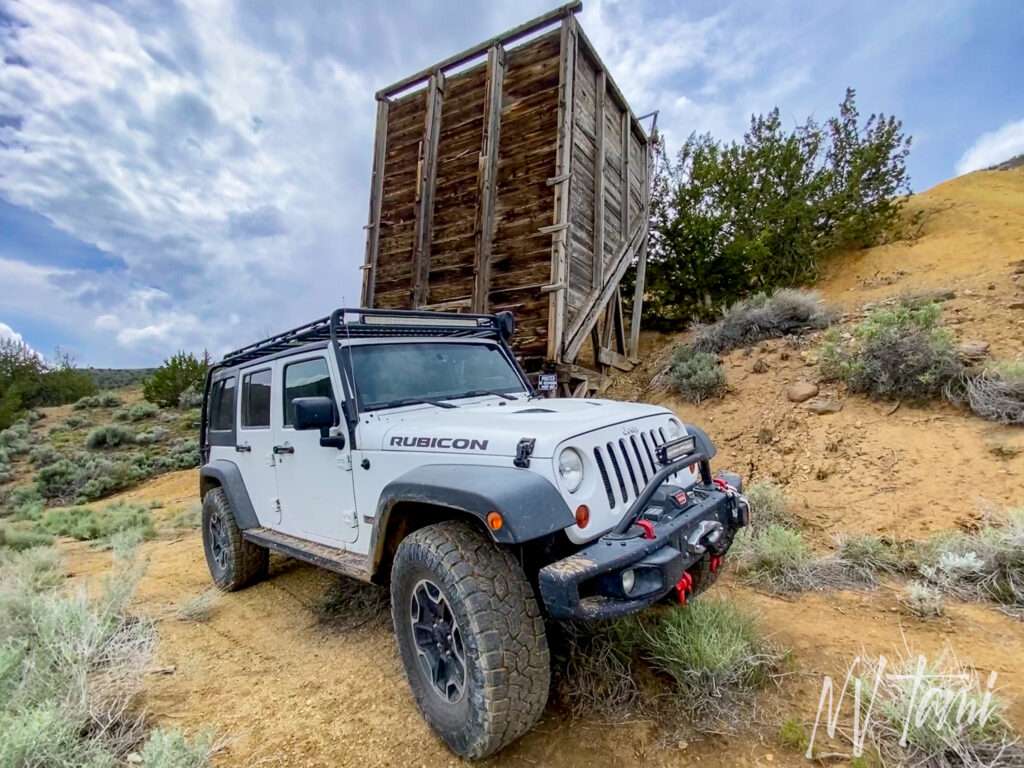
Honey Badger had her first big outing of the year and the first trip since her new engine exploring the Humboldt and East Ranges based in Winnemucca, known for mercury mines.
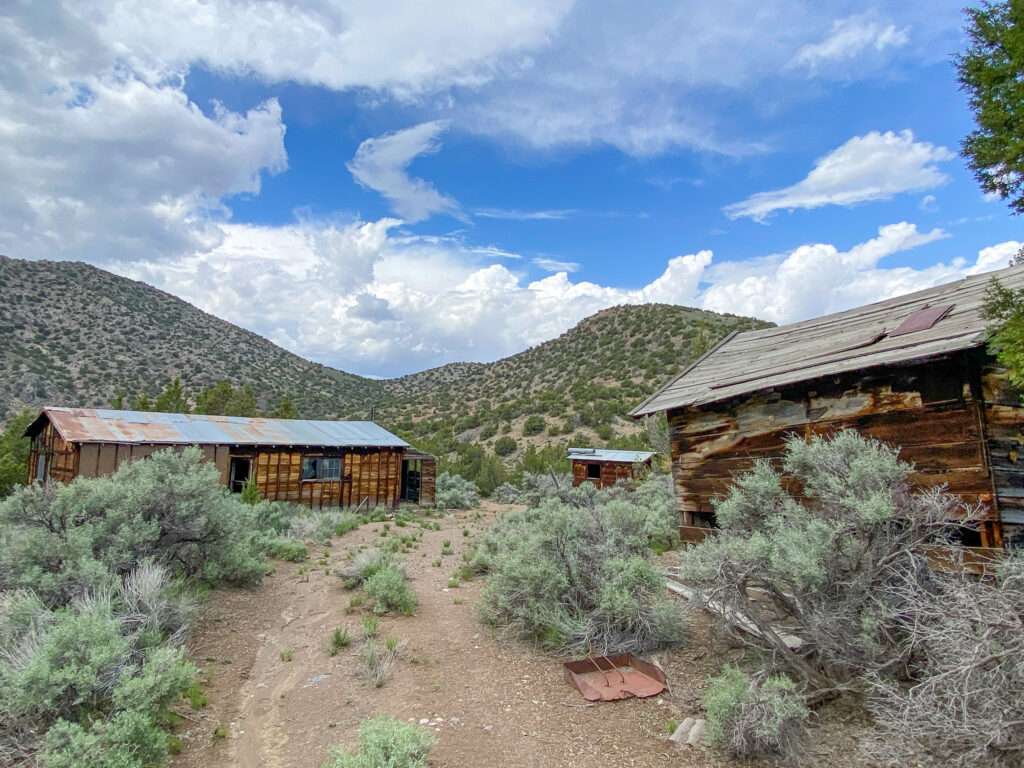
This trip was my second Memorial Day trip to Winnemucca; I explored Humboldt and Pershing Counties ghost towns last year. The kid had an appointment Friday morning, so I left after he finished.

Humboldt City
This 1860s ghost town is one of my favorites. Humboldt City was a great place to start the trip.
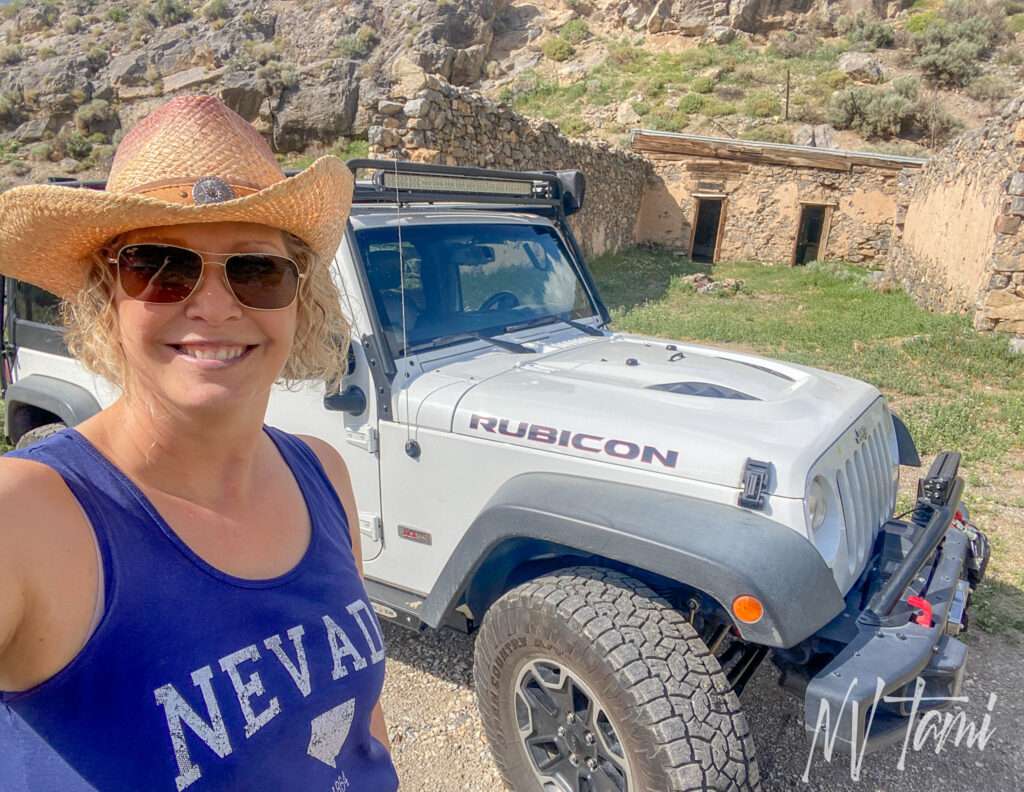
French Trader, Louis Barbeau, discovered silver in Humboldt Canyon in the spring of 1860. The Humboldt Mining District, the first in the area, was established the same year. Flush from Comstock Fever, a prospecting party, made haste to the new strike. Due to hostilities with the Paiute Tribe and the high cost of living, many left the area in early 1861.

The signing of the first peace treaty in the region in mid-1861 created a rush of miners and further exploration. Over one thousand silver deposits were discovered in the town site’s canyon. Initial surveys estimated the ore valued at $400 – $2700 per ton. Humboldt City was quickly platted in and by August, two hundred people were living in the new town. The population was large enough a post office was awarded on April 18, 1862. I have a full article, where you can read about Humboldt City.
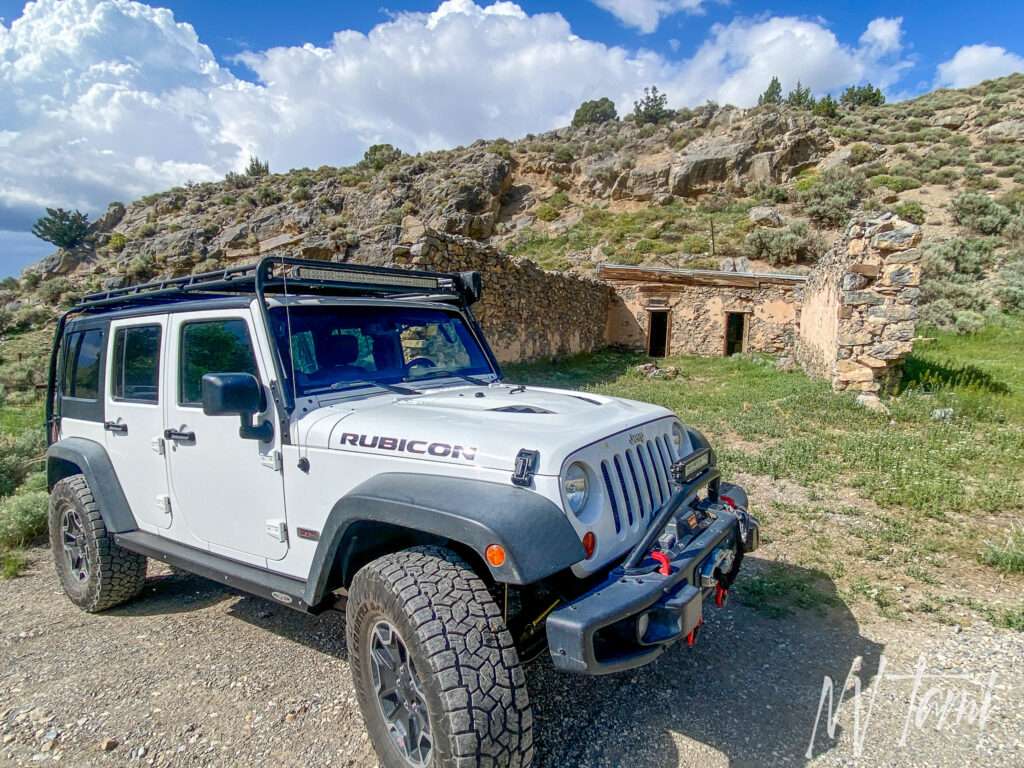
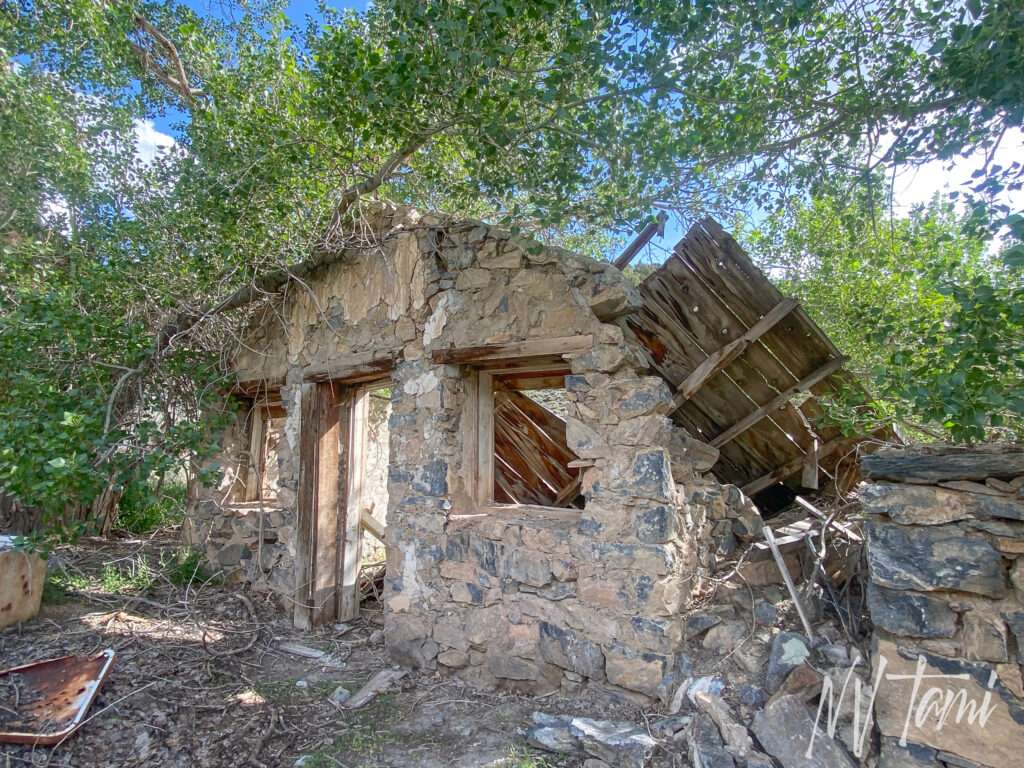

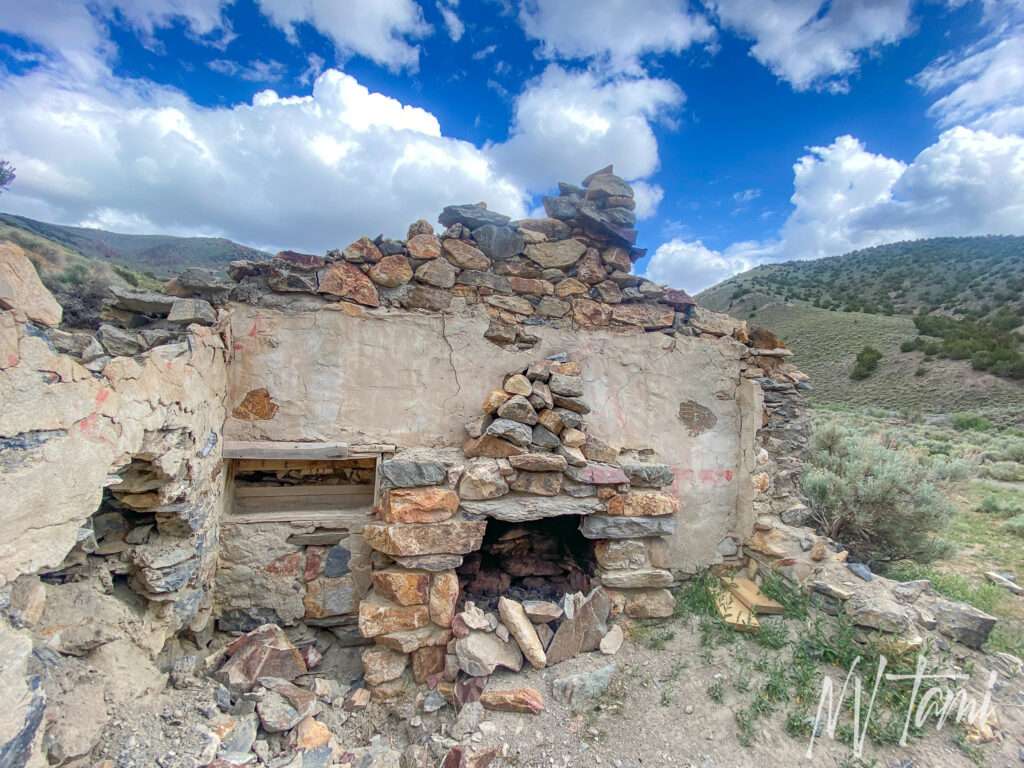
I have no idea what this plant is, but I love it! It was growing up the entire canyon.

Antelope Spring mercury mining district
We started our first day in the Antelope Spring Mining District, where silver ore was discovered in 1864. Silver mining was active to the early 1900s. Cinnabar was discovered at the Red Bird Mine in 1907 and a number of claims were staked and worked into the 1970s.

(Photo credit: Ebay)
Cinnabar was processed in retorts which heat and vaporize the mercury (quicksilver) to separate it from the ore. The process is similar to that of a liquor distillery. Many of the mines had a retort, from basic to elaborate. Unlike gold and silver, measured by weight, mercury is measured by the flask. Each flask is varied is shape but they all held exactly 76 pounds of liquid mercury.
Pershing Mine
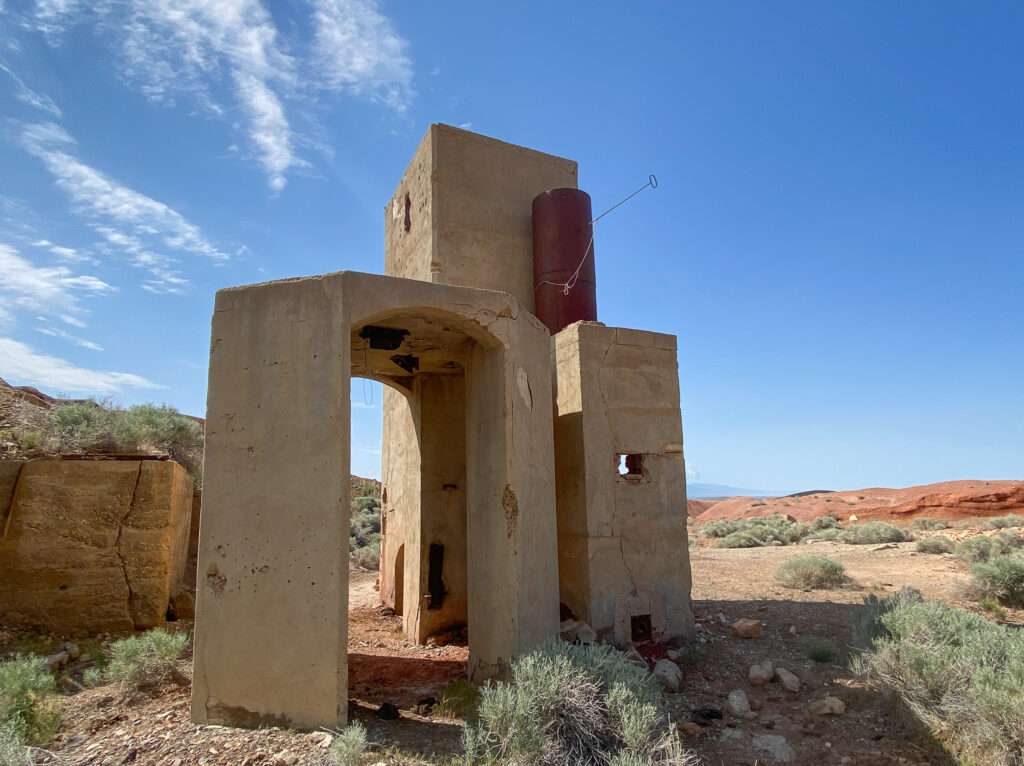
Cris Matevich discovered the Persing Mine in 1912 and built the first retort in the district in 1914. It operated until 1919. The Pershing Quicksilver Company purchased the claim and installed a 60′ Gould rotary furnace in 1928. Production increased in 1929 but when the price of mercury dipped, production stopped in 1931. The mine operated sporadically in the 1940s, closing in 1946. Pershing was the largest producing mine in the district with 2,396 flasks of mercury.
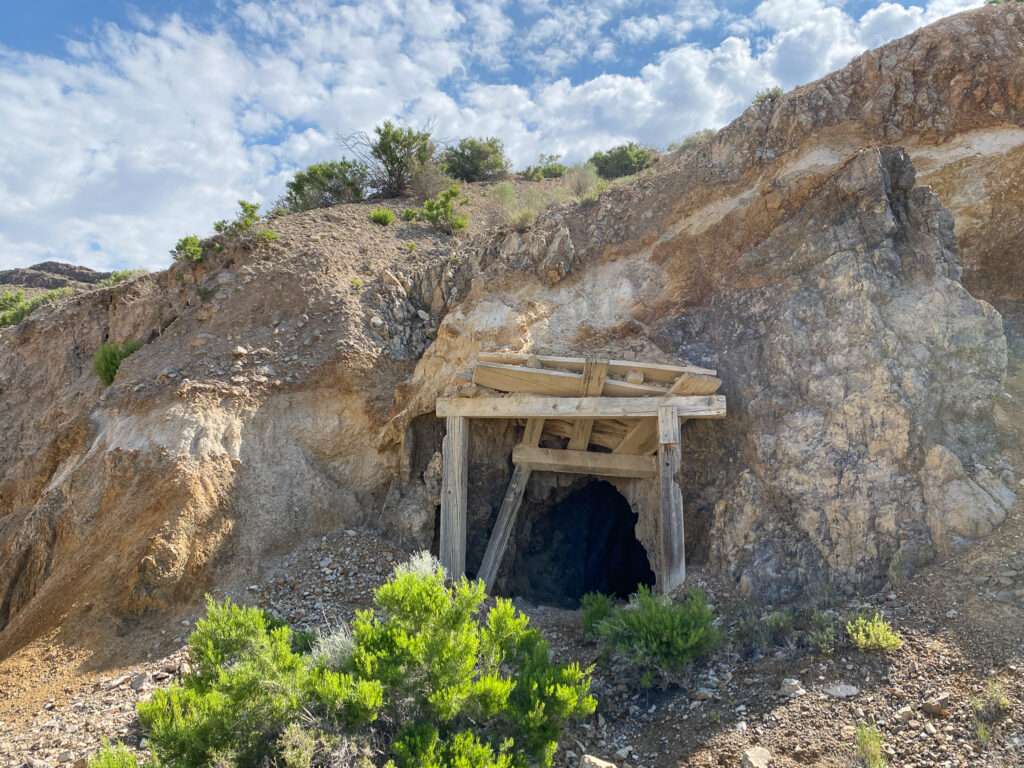
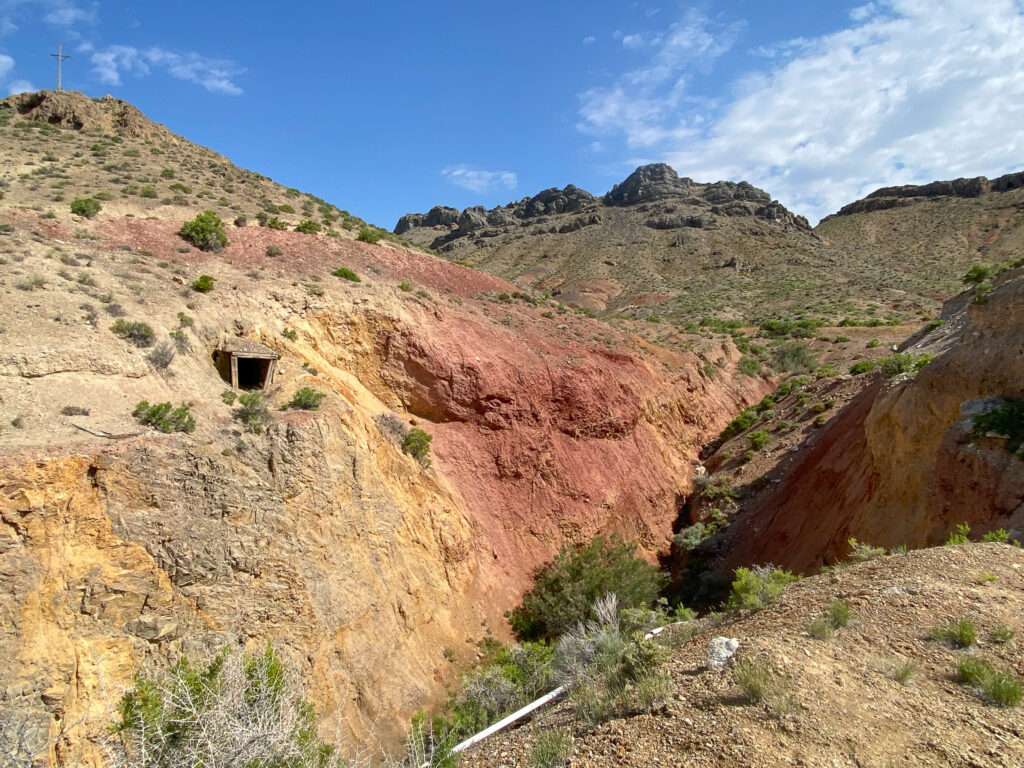
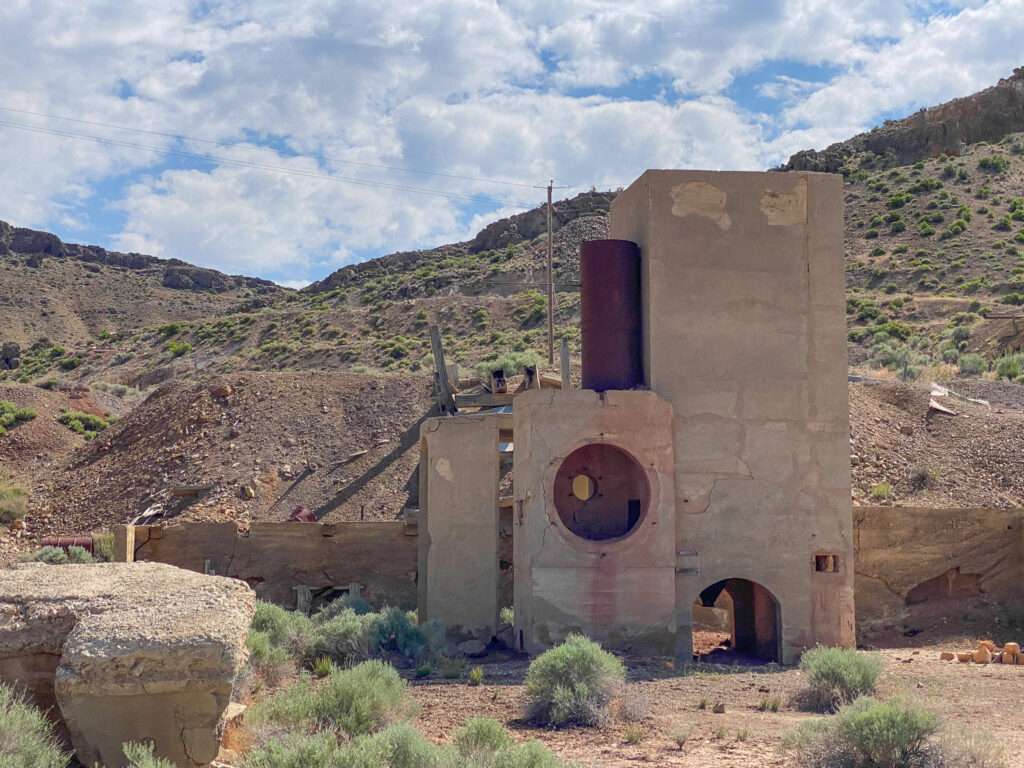
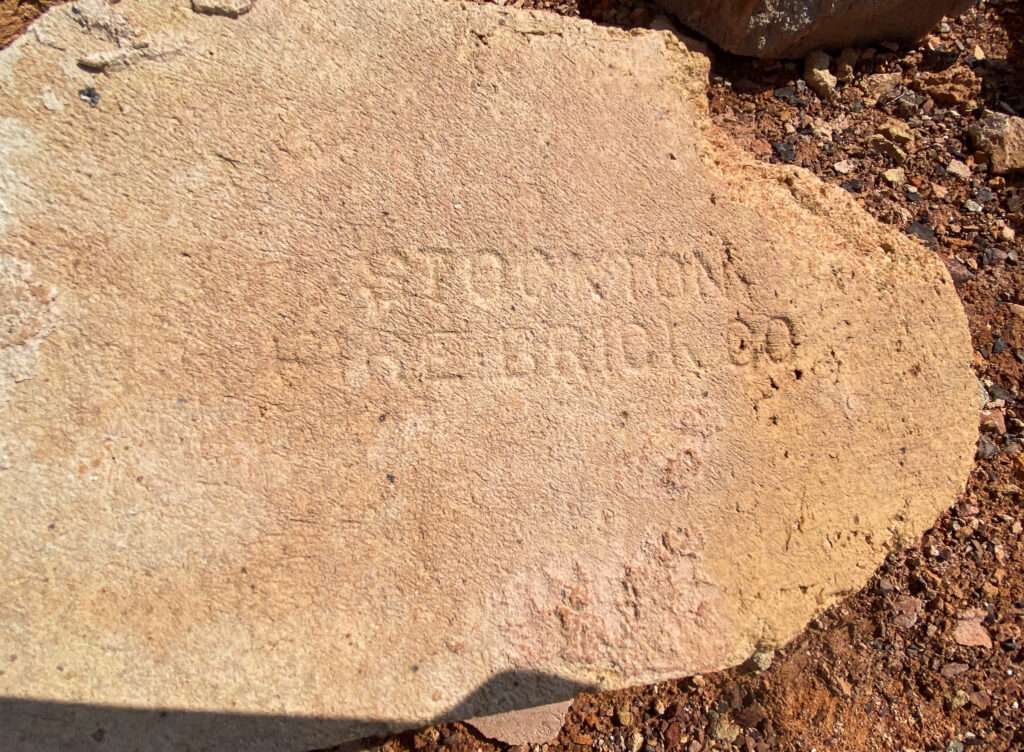
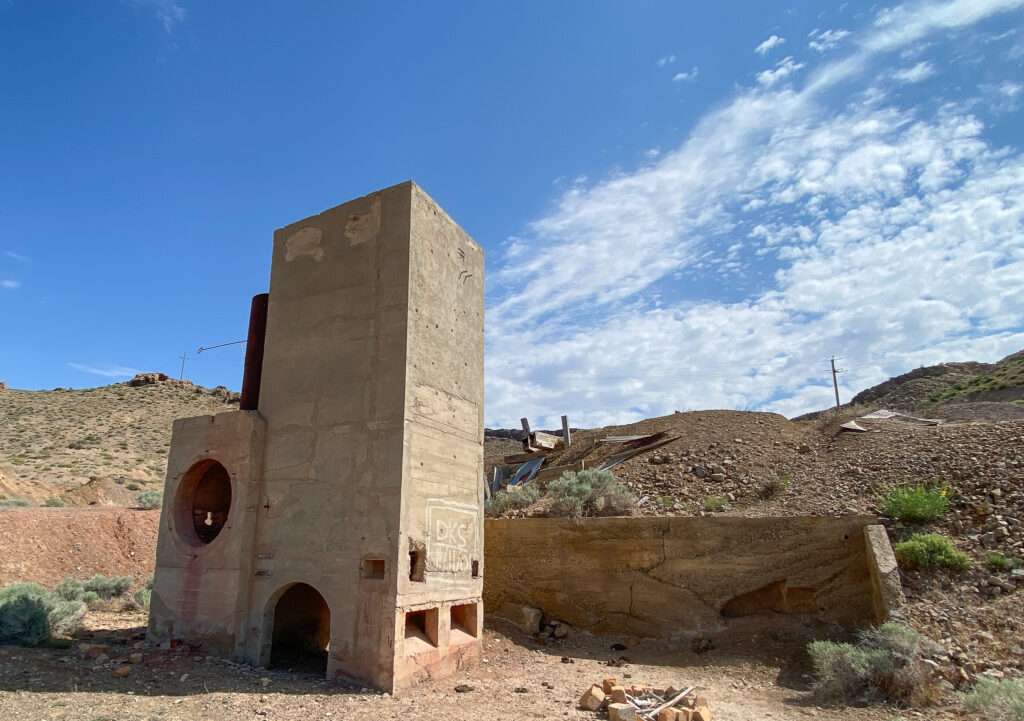
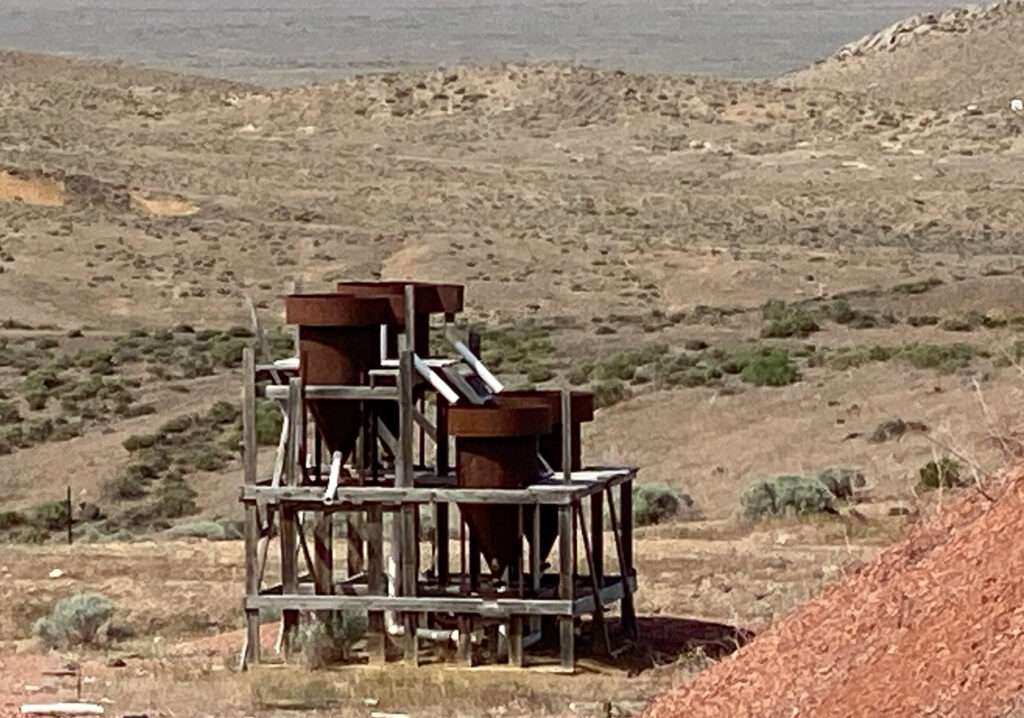
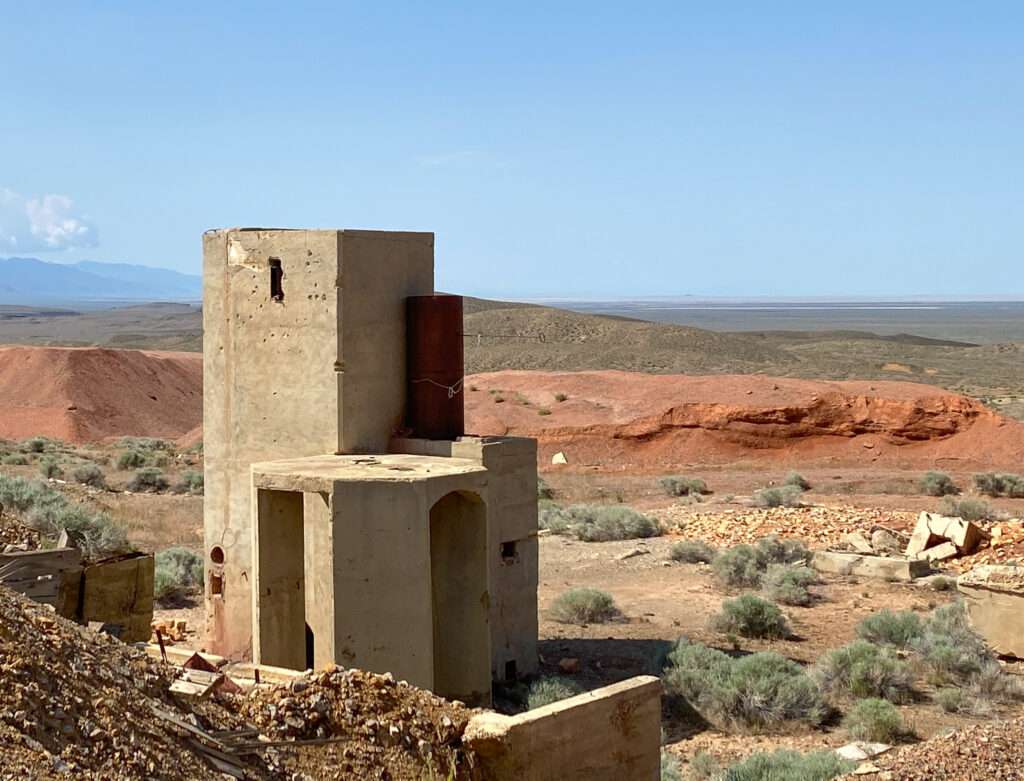
The Pershing Mine is known chiefly for the writing on the door “Open this door and get the surprise of your DEATH.” It looks like someone tempted fate; the door was open.
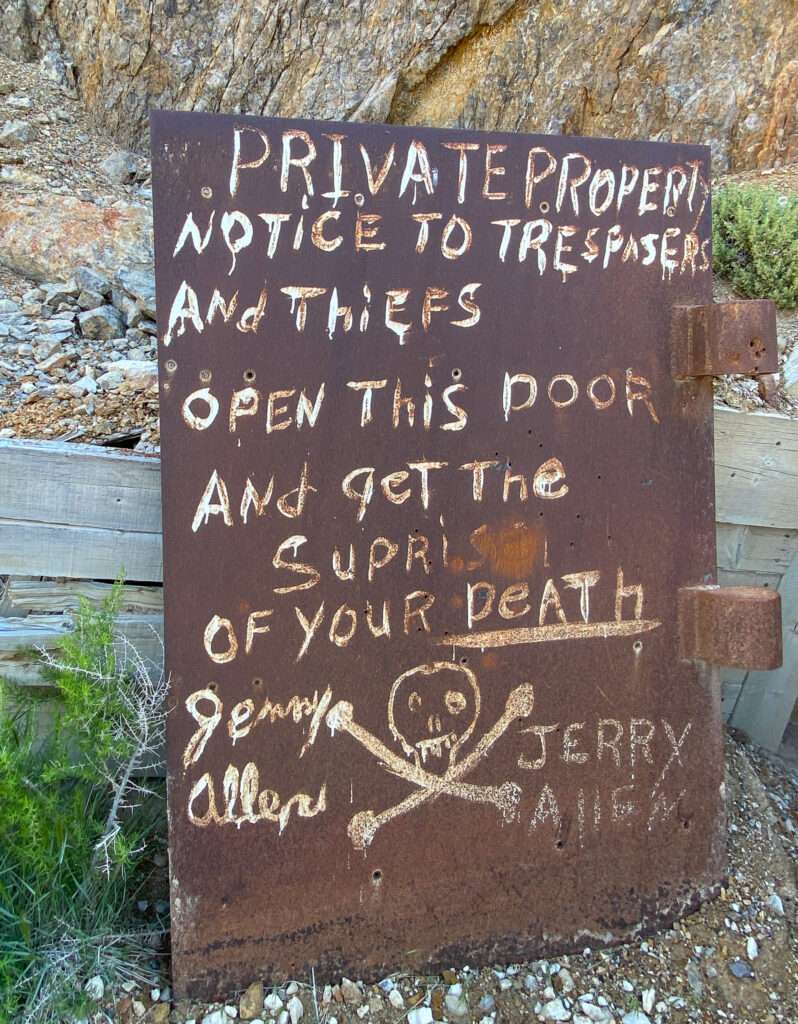
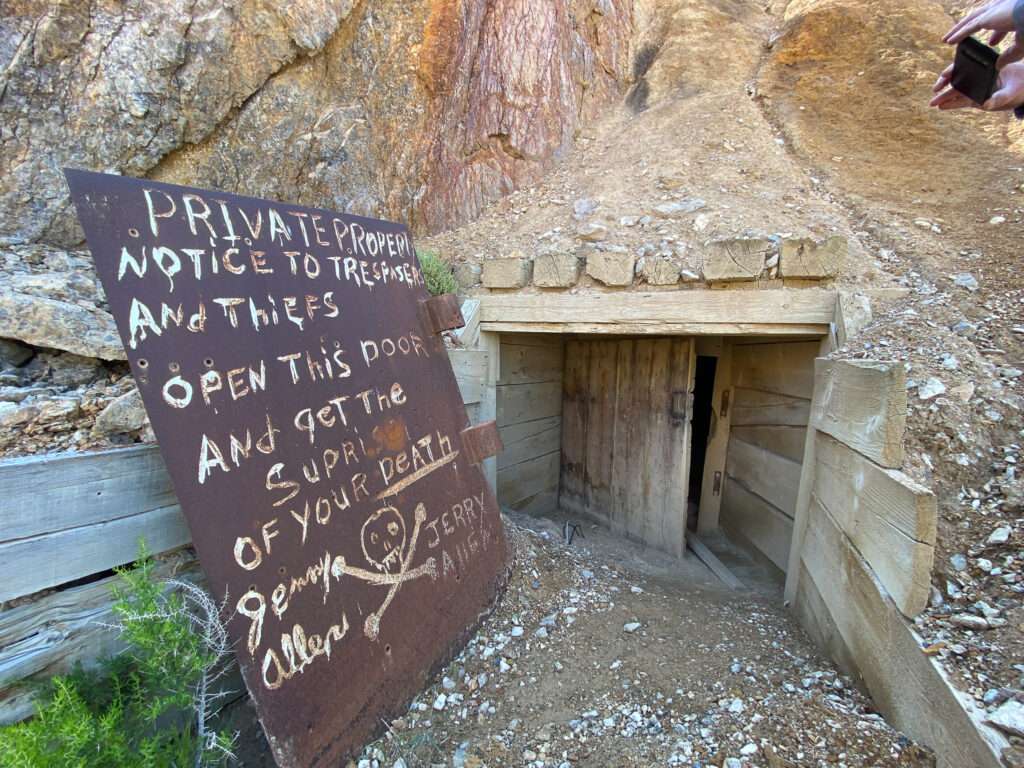
Eastern Star Mine
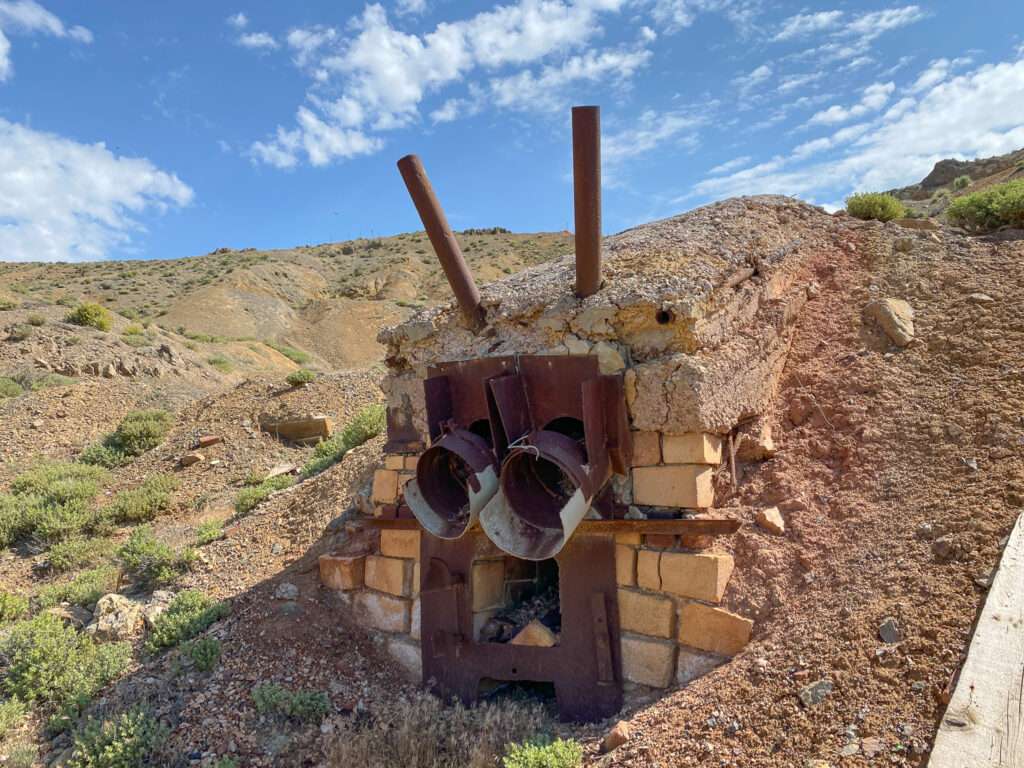
The Eastern Star Mine was discovered in 1912. The main periods of operation were 1928-1930 and 1941-1943.
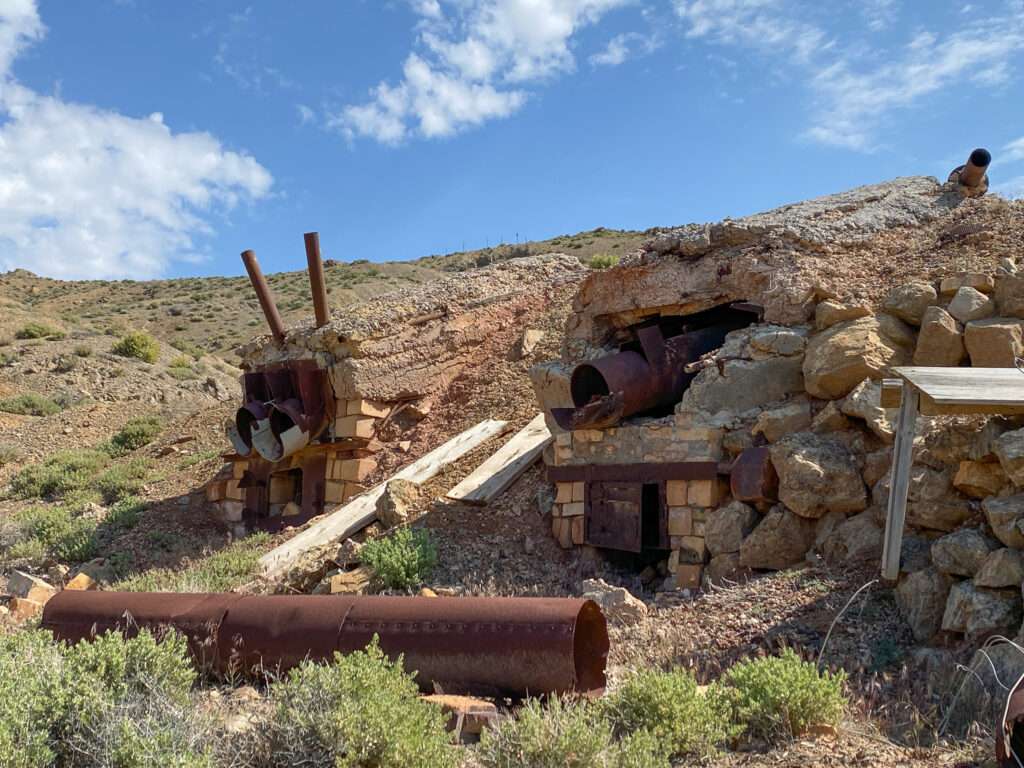

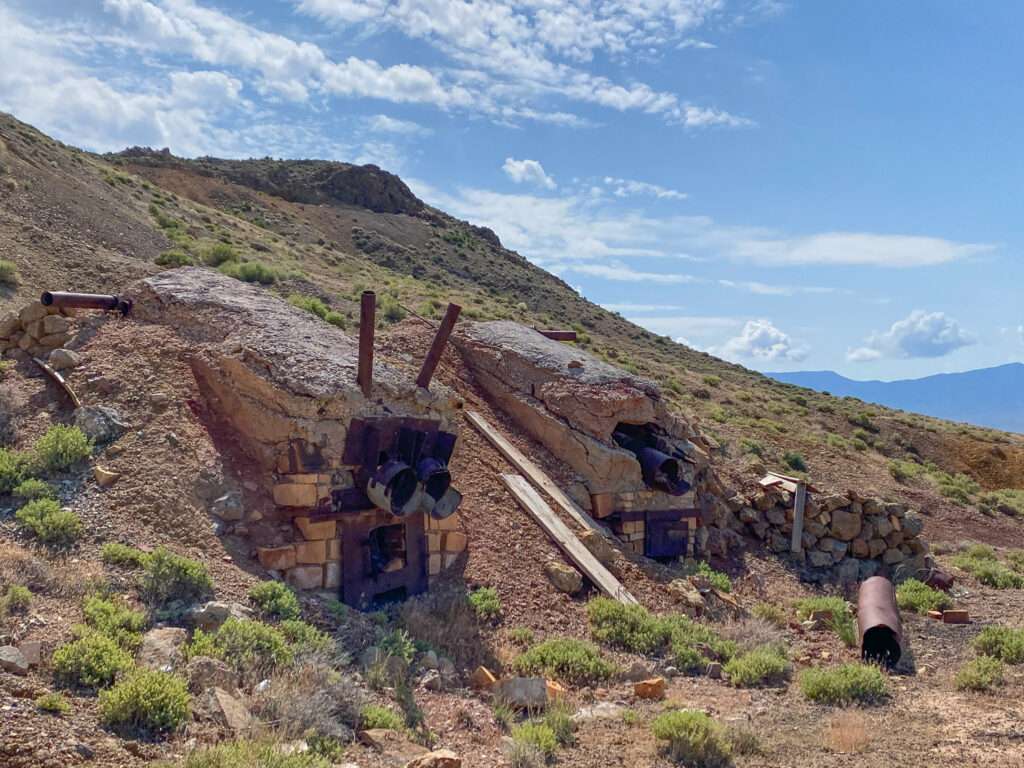
Montgomery Mine
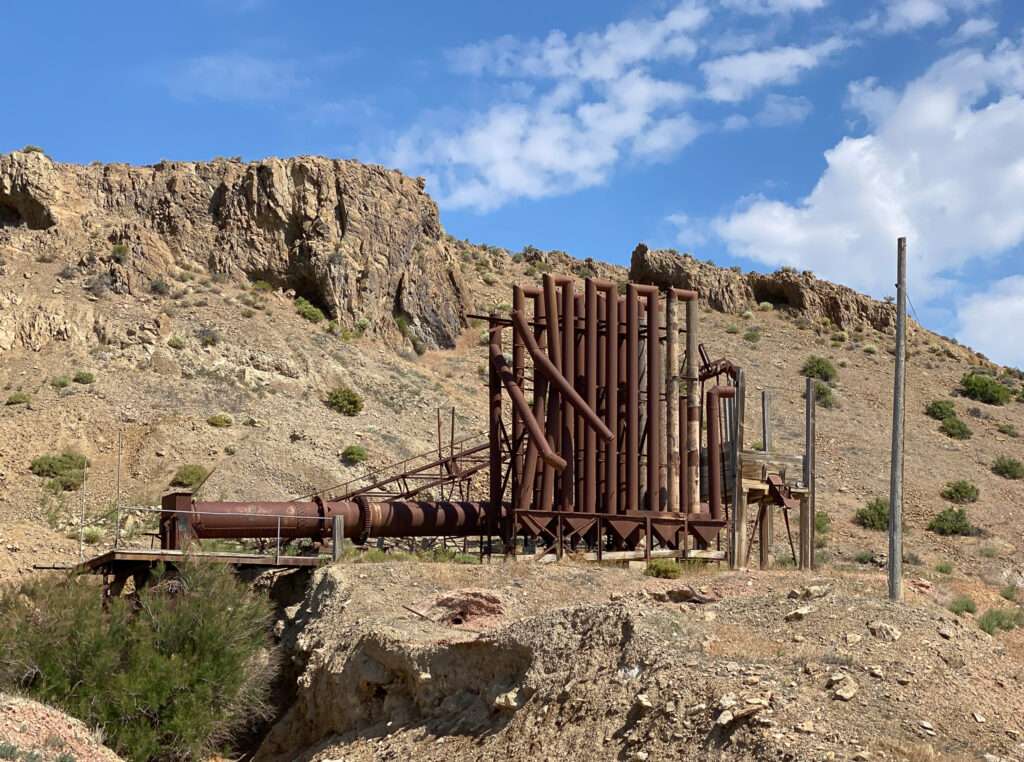
W.A. Montgomery discovered his mine in 1924 and then sold it to the Nevada Quicksilver Company in 1929 but they closed operations two years later. Lessors worked the claim several times in the 1930s and built a 6-pipe retort. Montgomery Mine was worked sporadically until the mid-1940s. Utex Exploration Company explored Montgomery in the 1960s.
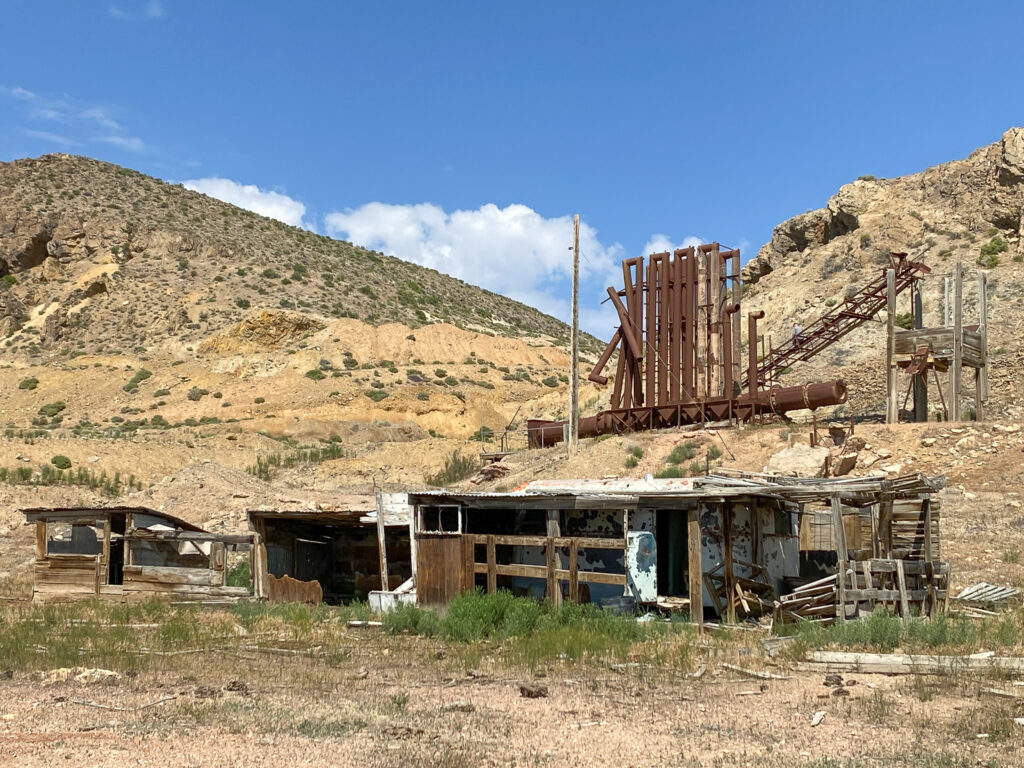
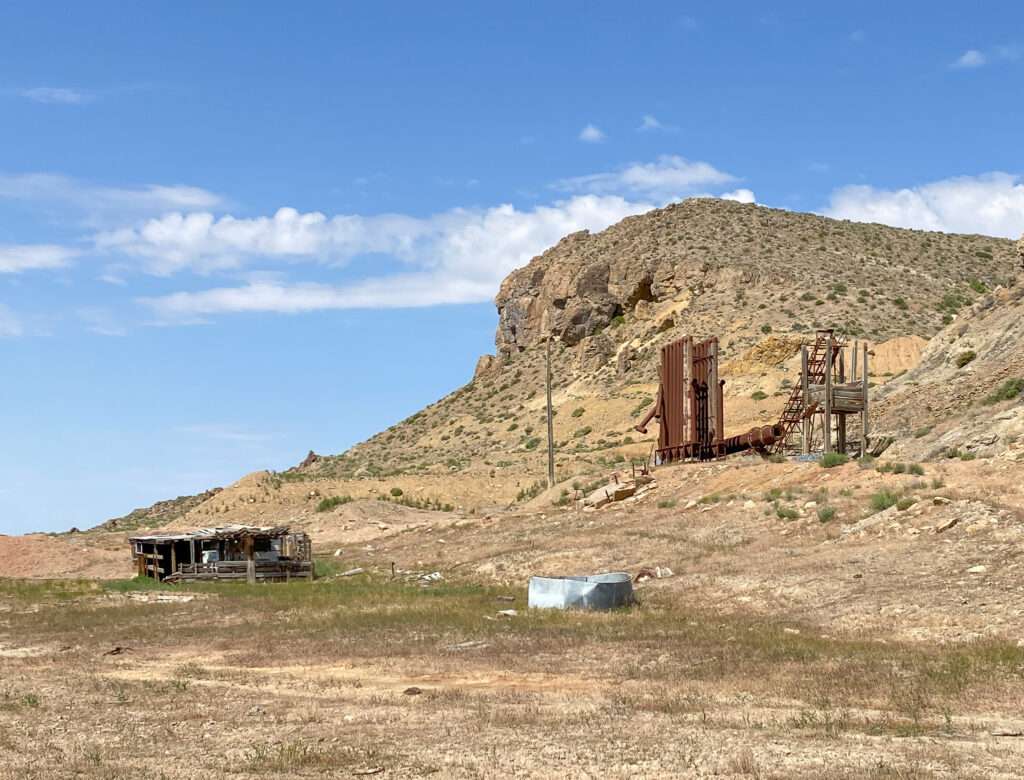
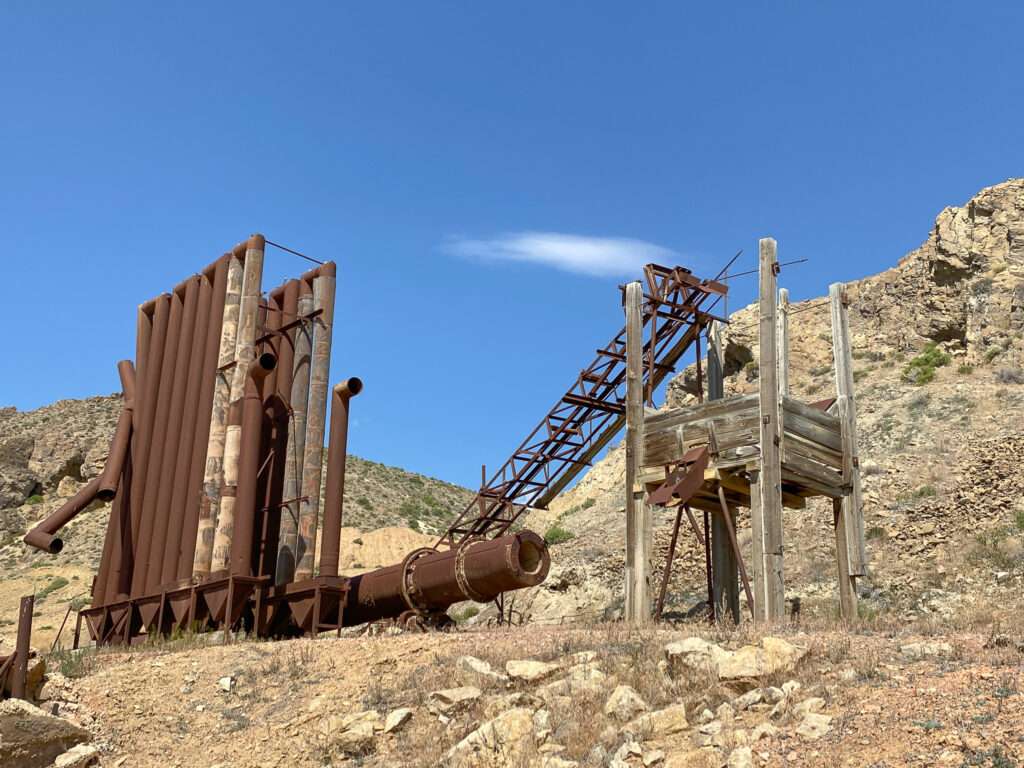
Below the mine is a homestead. The house is a trailer under the same roof as several outbuildings, including a chicken coop and corral.
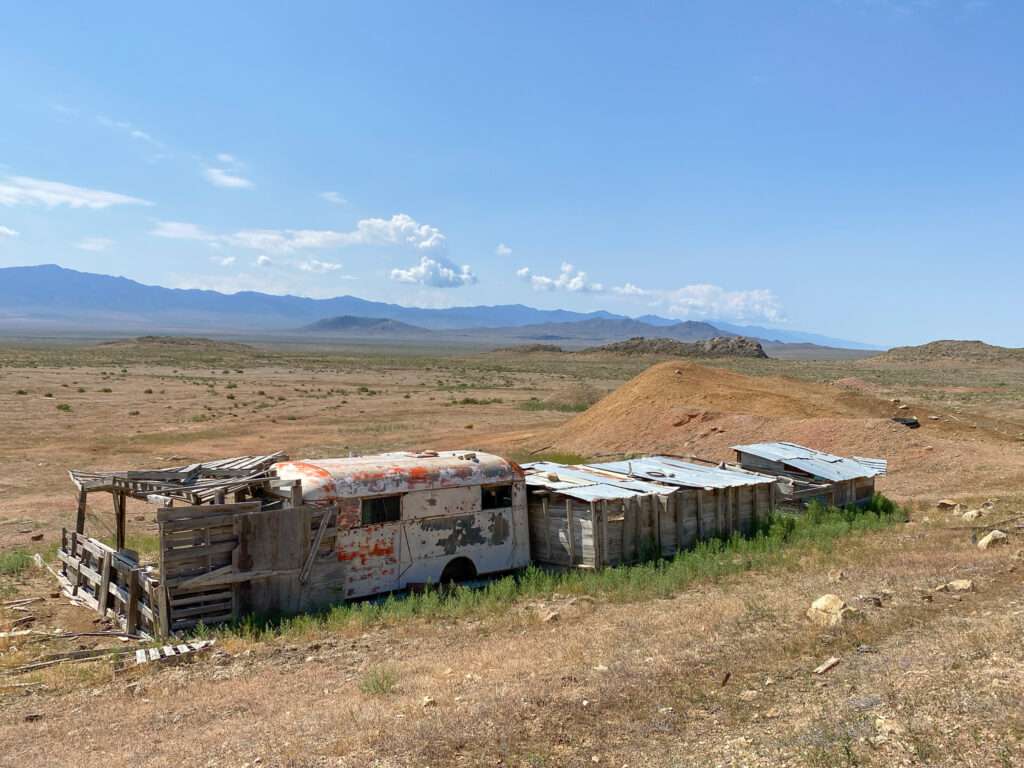
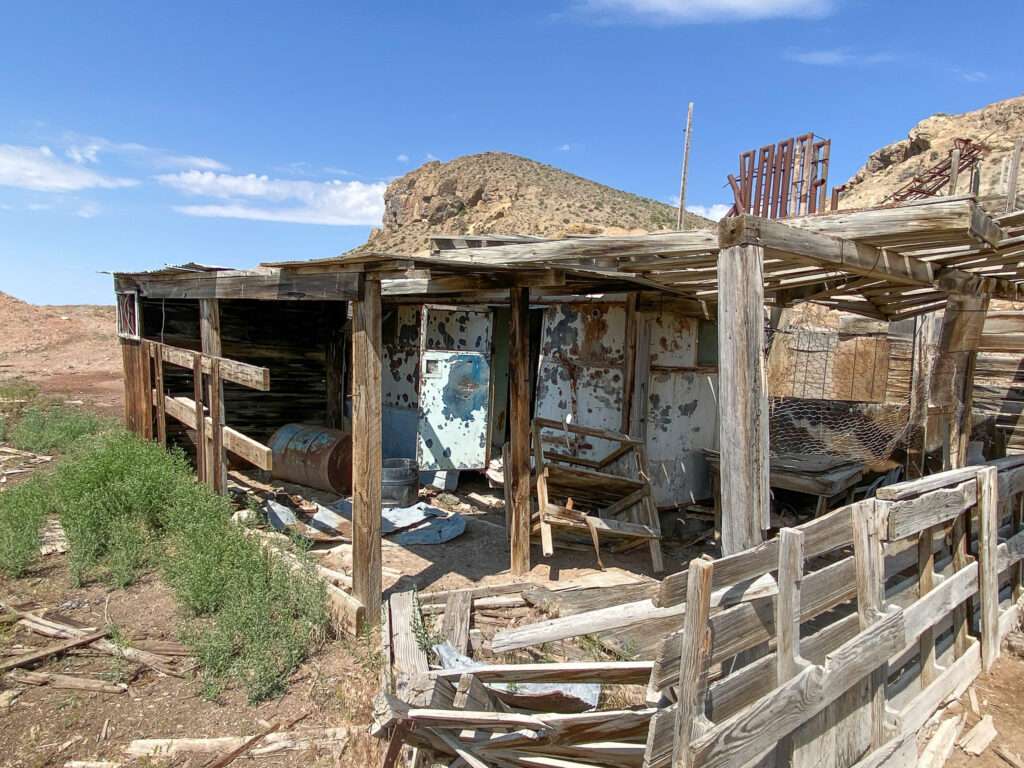
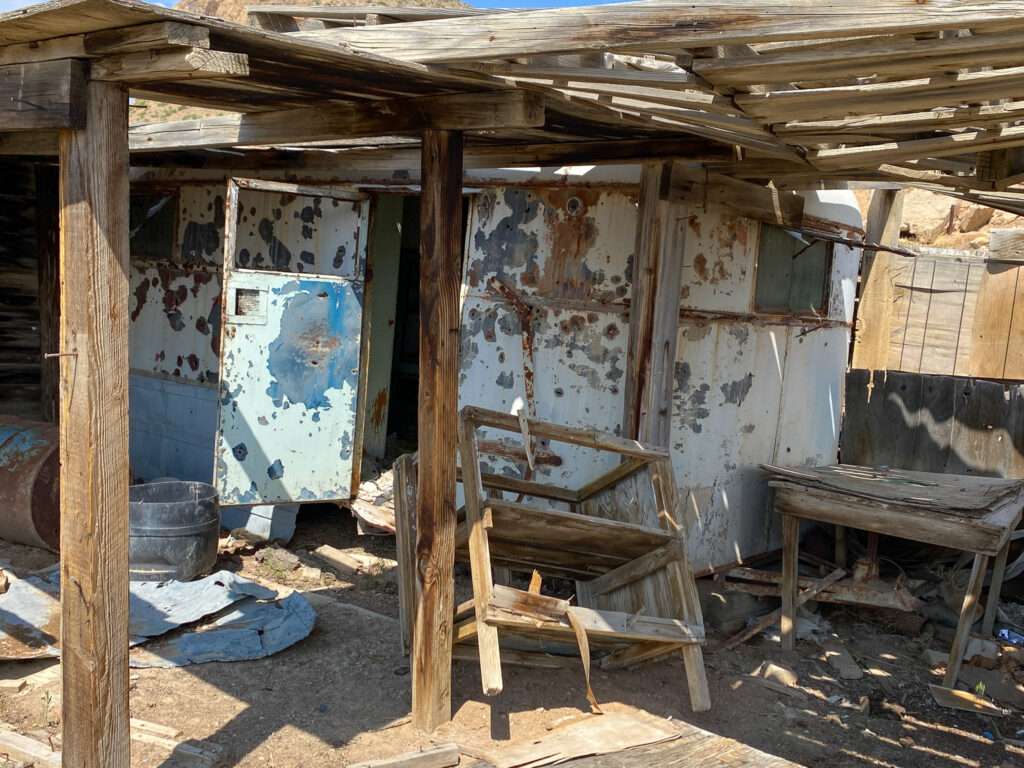
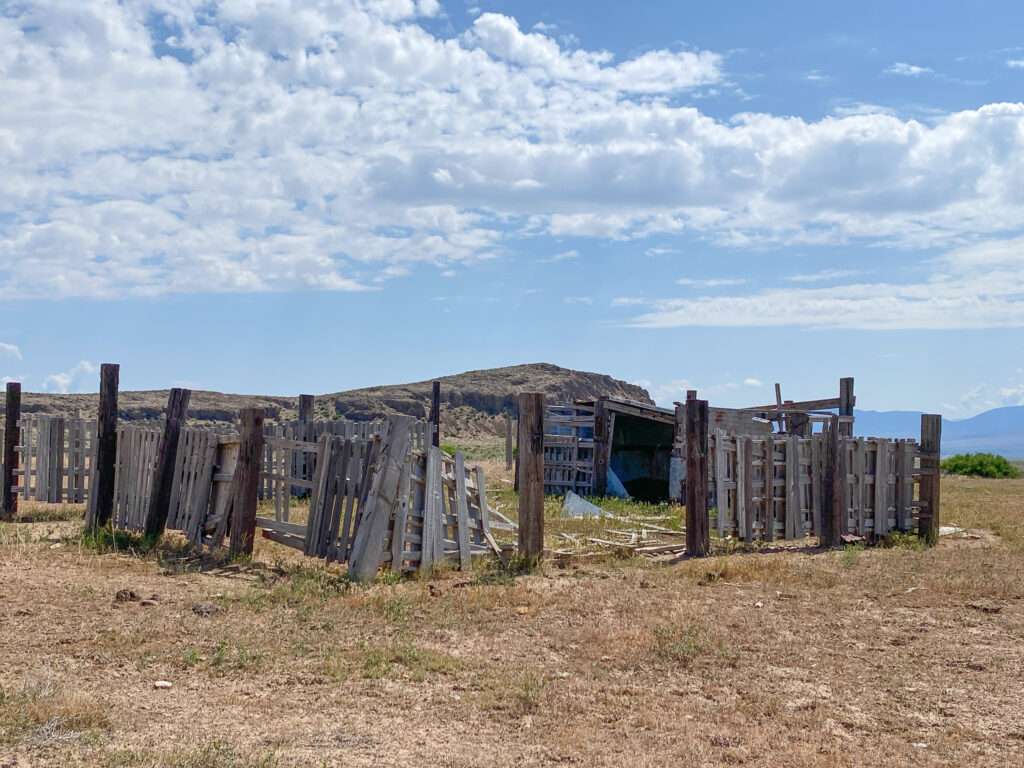
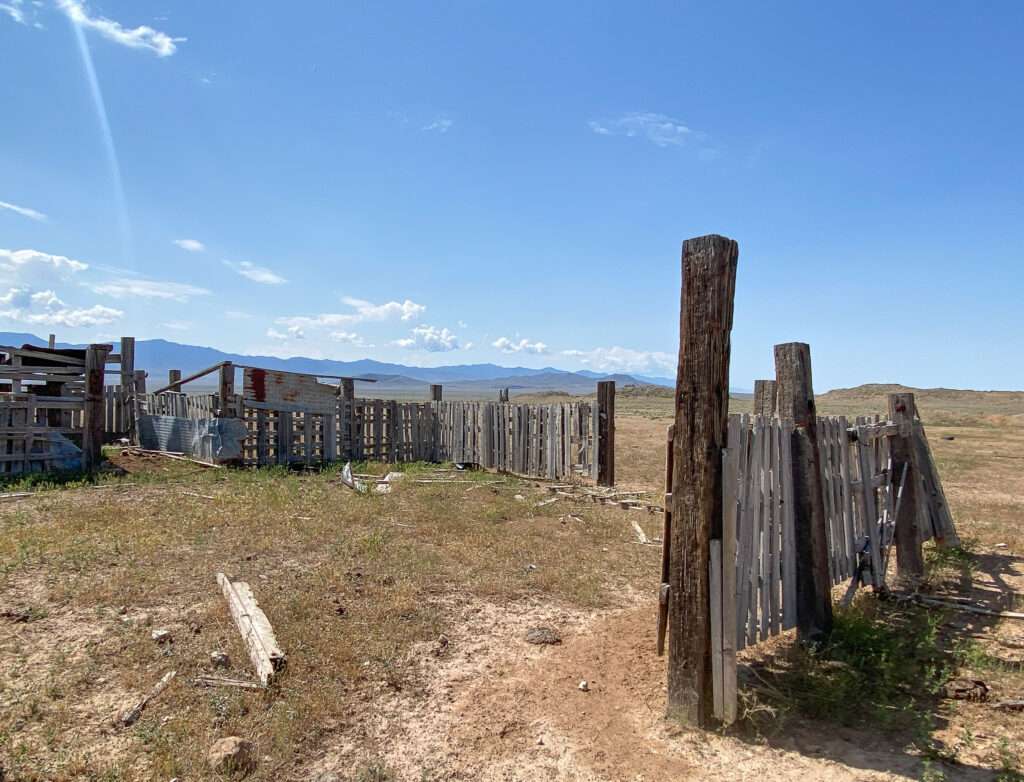
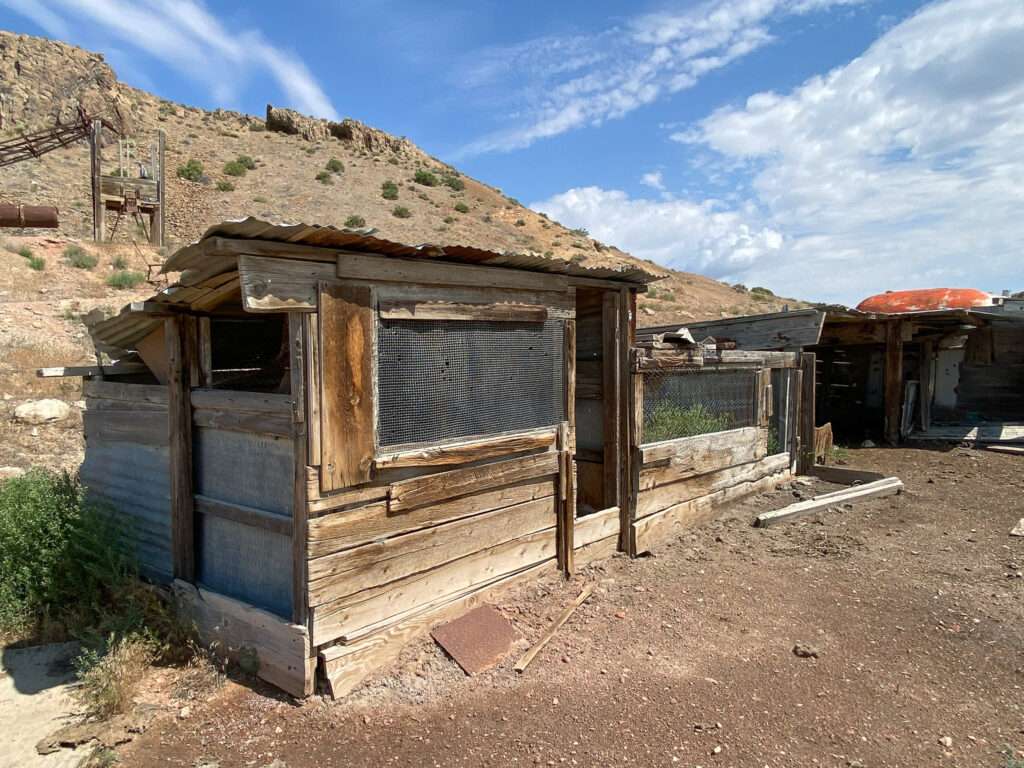
Freckles Mine
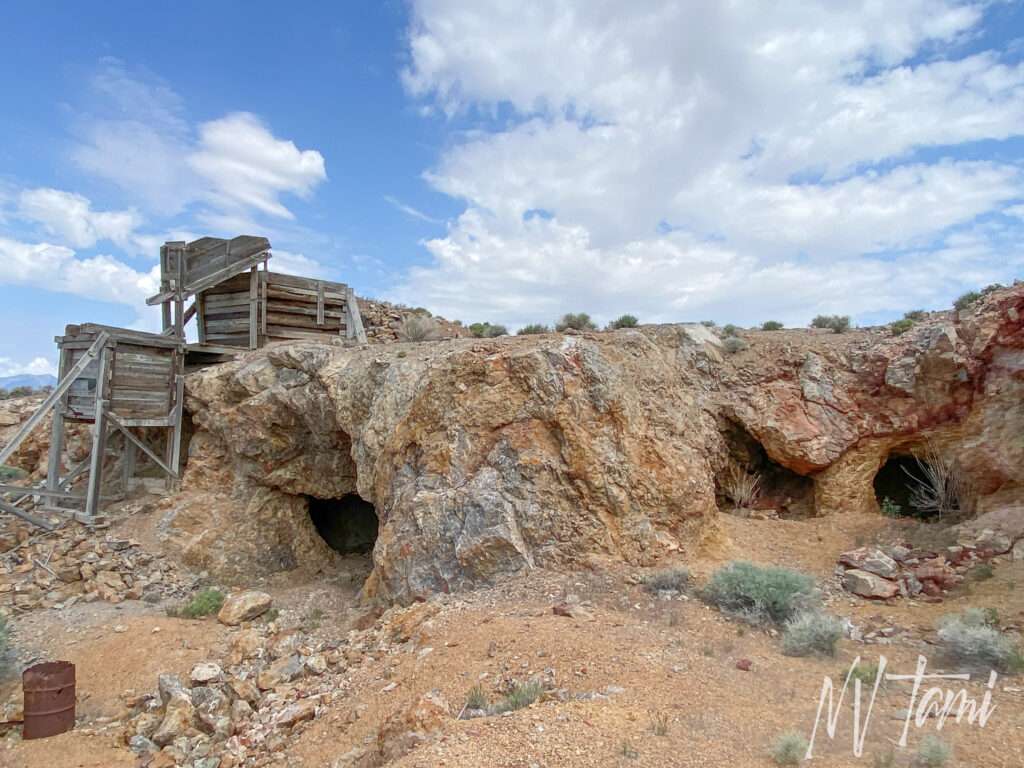
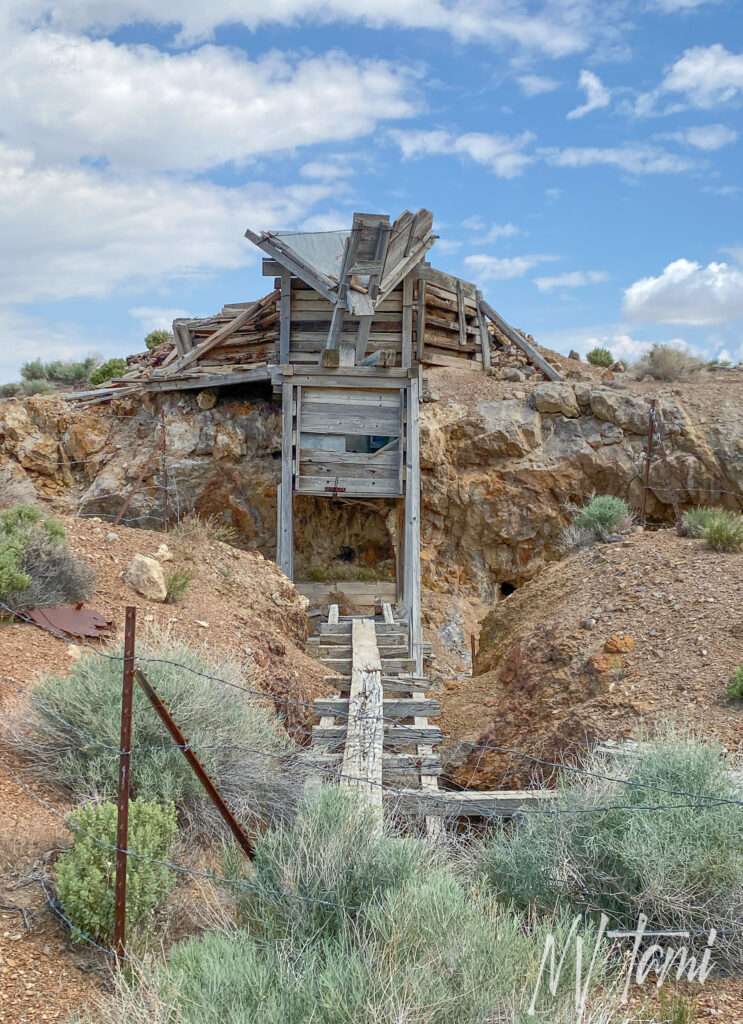
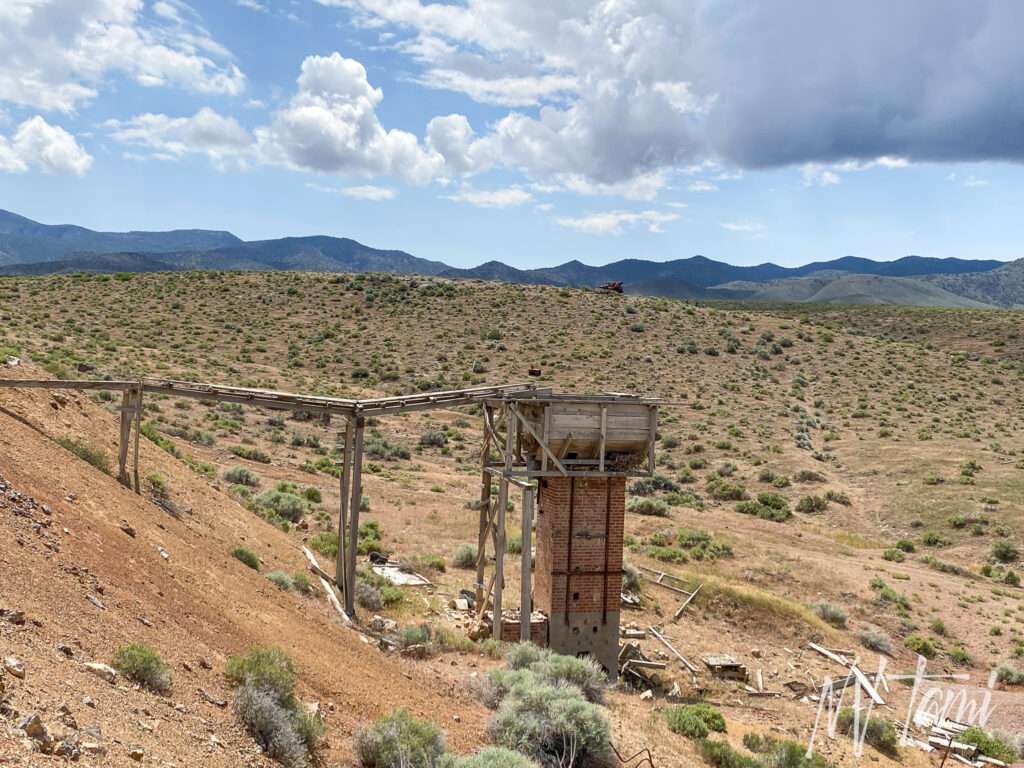
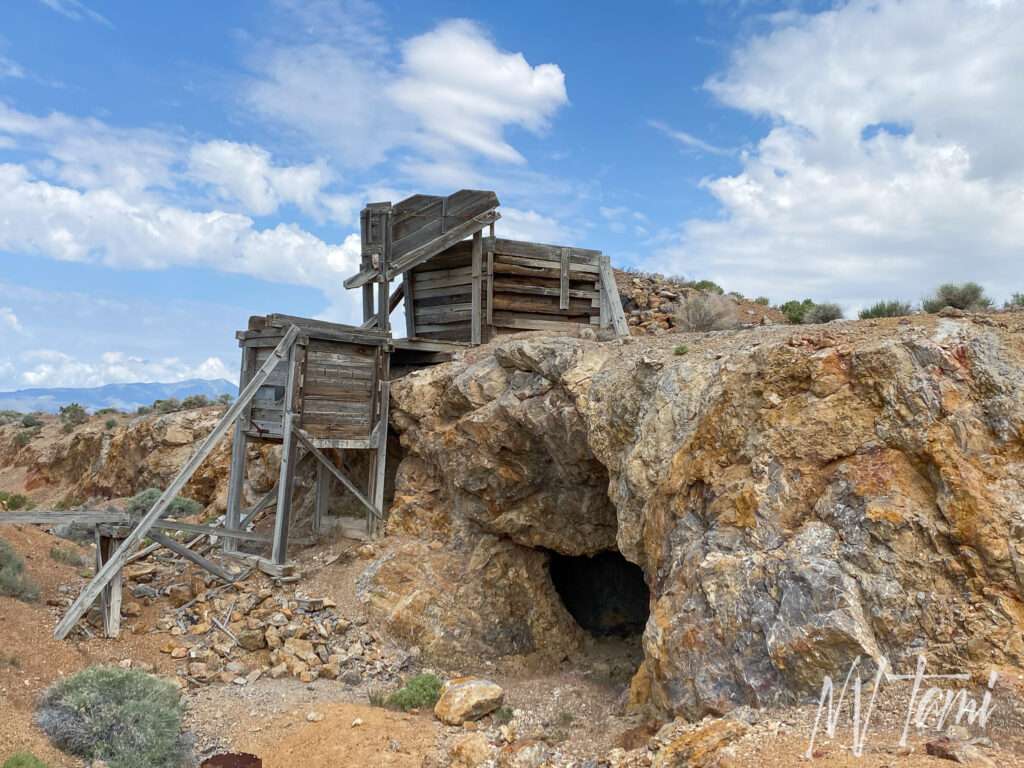
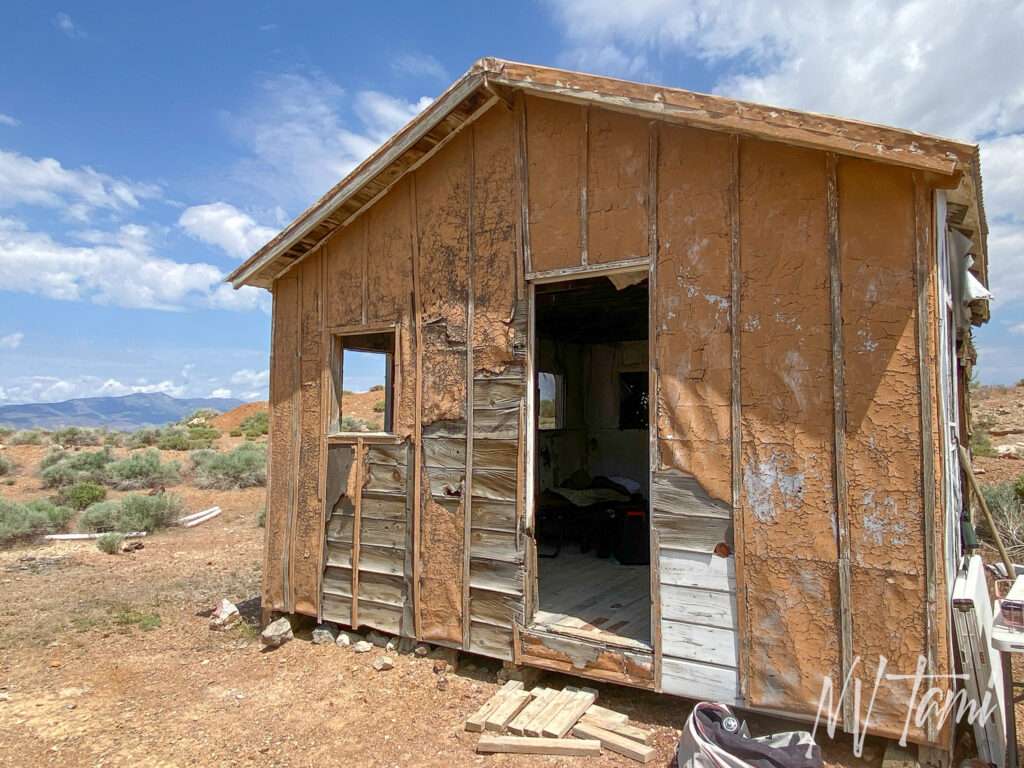
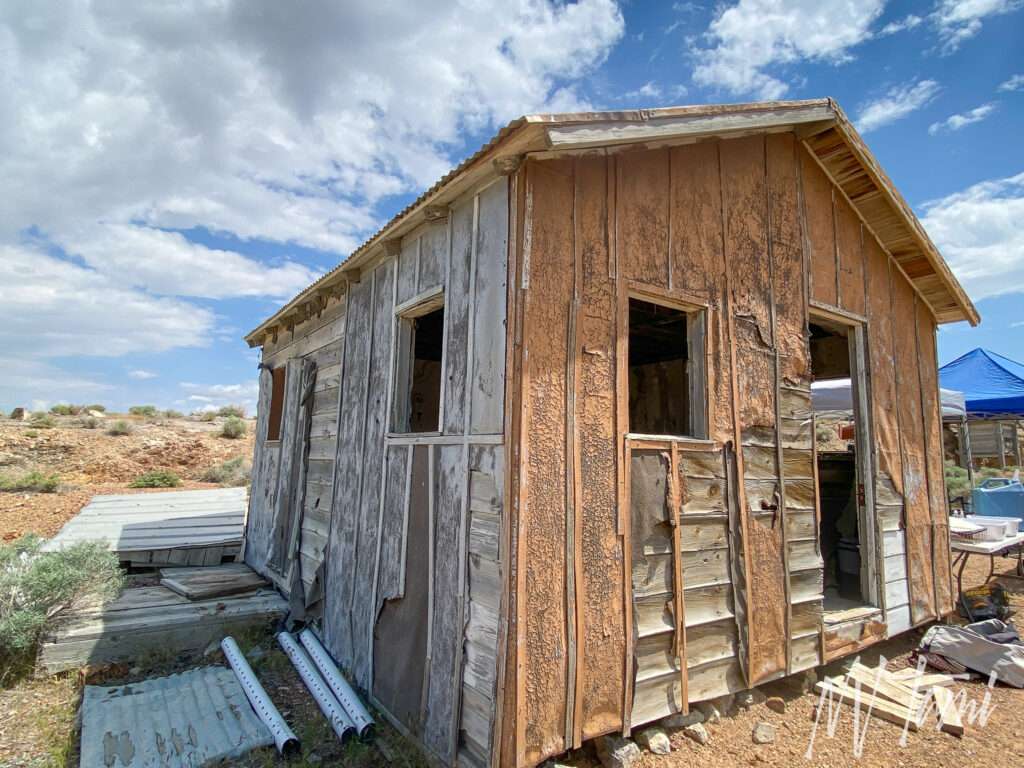
The Freckle Mine is in the Table Mountain Mining District and was discovered by Joe Chambagna in 1940. The claim name was changed to Roman in 1942 and a two-pipe retort was built, processing 162 flasks of mercury in a year. The price of mercury declined post-WWII, and mining halted in 1949. As the mercury price rose the following year, the mine was leased and 552 flasks were produced. In the 1960s, an additional 450 flasks were processed.
There was a group of guys camping at Freckles and exploring the area. They had a nice camp with trailers, ATV’s and tents. Why don’t women do this? Maybe I need to plan a trip.
Golconda Canyon Mercury retort
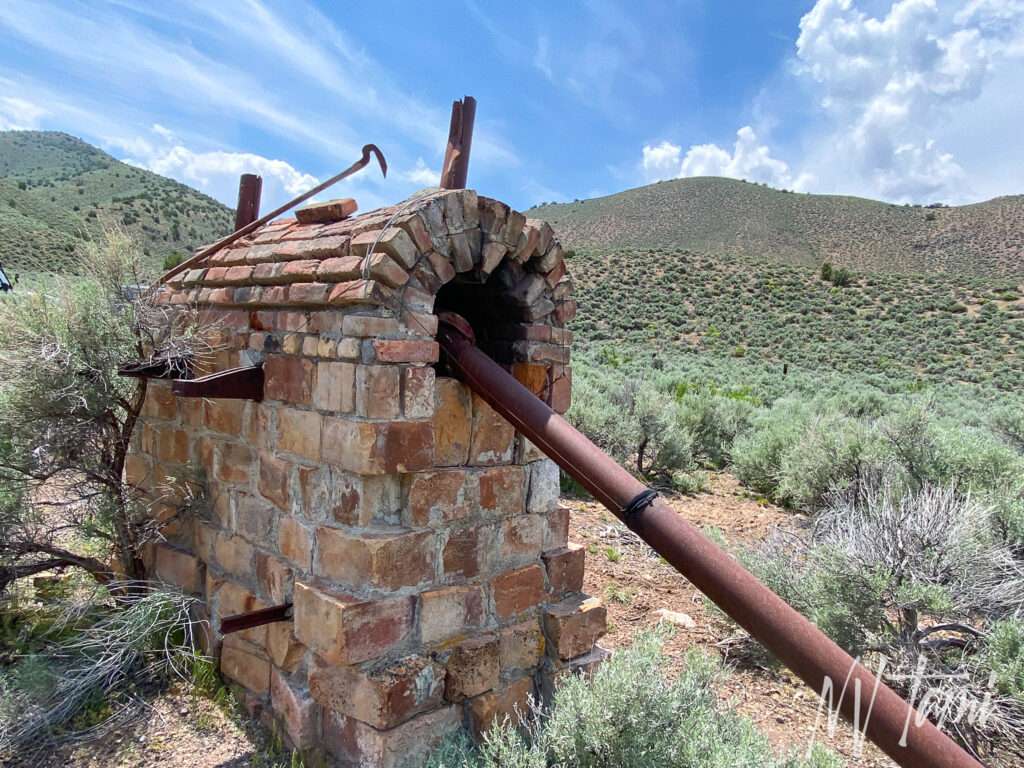
Seemingly in the middle of nowhere is this small mercury retort.


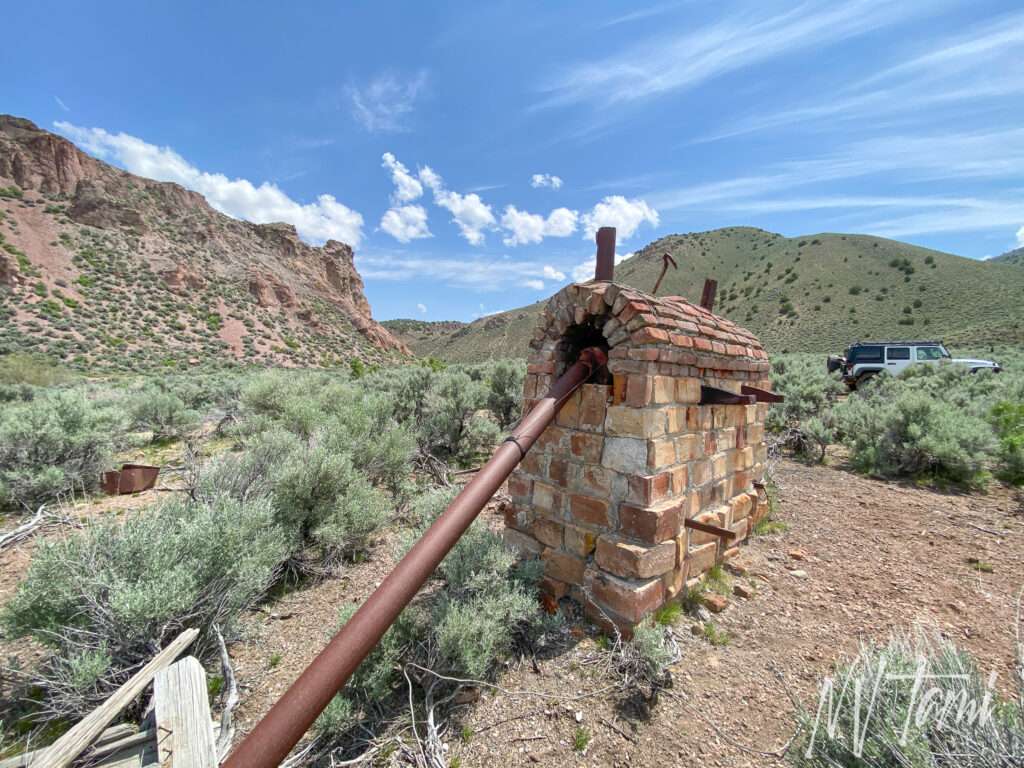
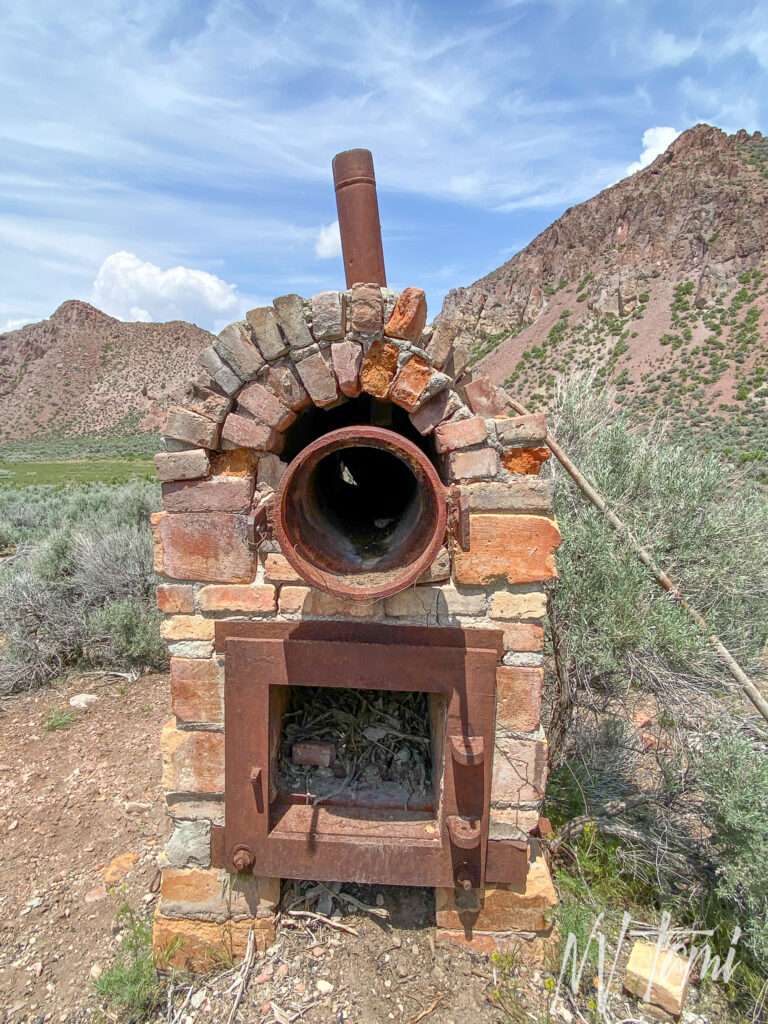
“Discovery” mercury mine

OF#1 knocked it out of the park with this find! I haven’t seen the mining camp anywhere on the internet; I found a little information about the mine but nothing else. I changed the name to Discovery Mine to protect this site, as it was such a big discovery.
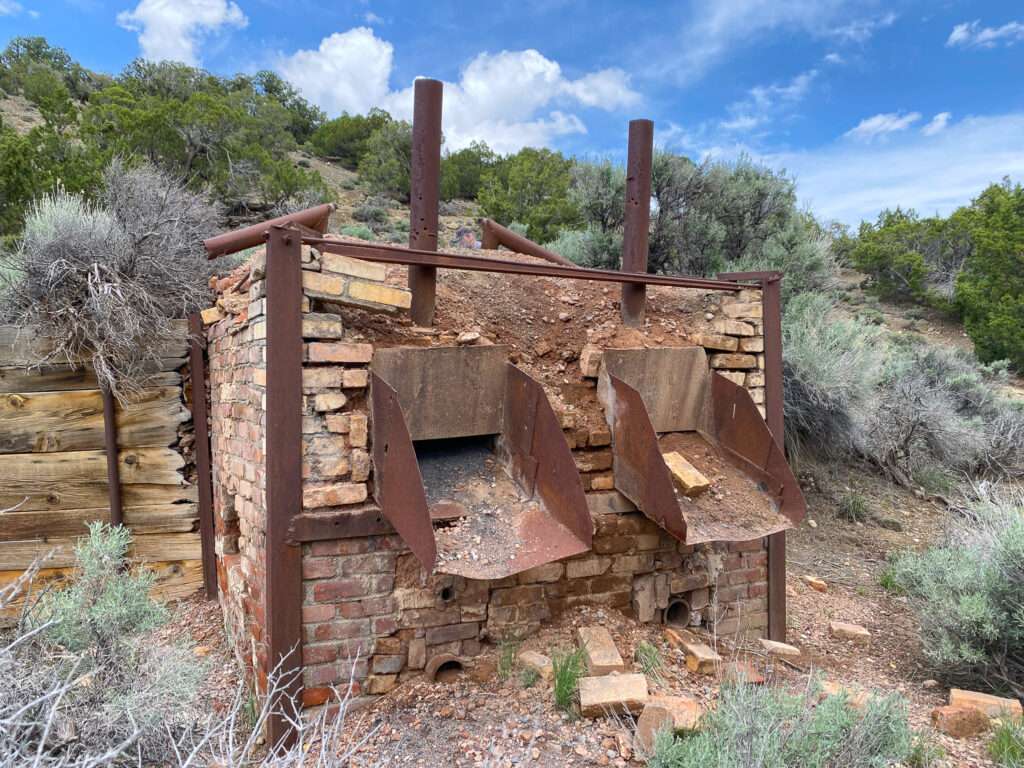
Fred Miller discovered the mine in 1955. He worked the claim for three years, then again between 1968-70. One Hundred flasks of mercury were produced the first year but production decreased in the following years. A total of 250 flasks were extracted using the retort. Harry Brown then leased the discovery mine, so recover an unknown amount of mercury. A second mine, likely part of the same vein, produced three flaks in 1959.
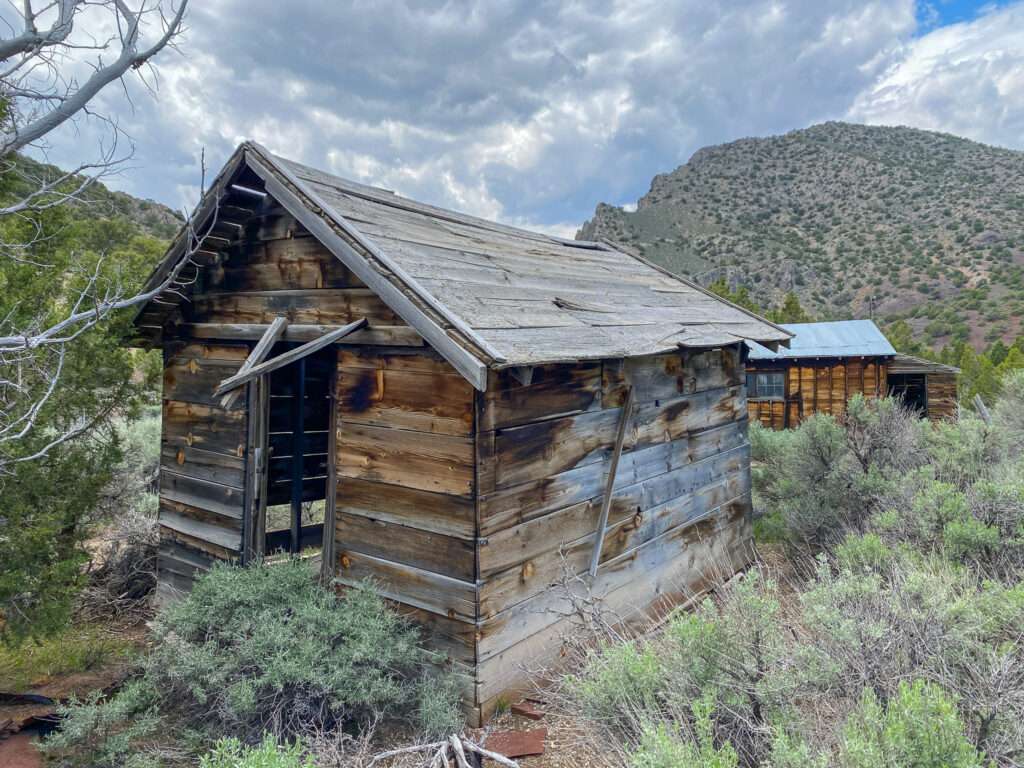
A 2 d-type chamber oil-fired retort processed the mercury. It is possible the mine was worked before the retort, as in 1980 an older pan-type retort was discovered and it is believed that the mine may have used the Golcando Canyon retort.
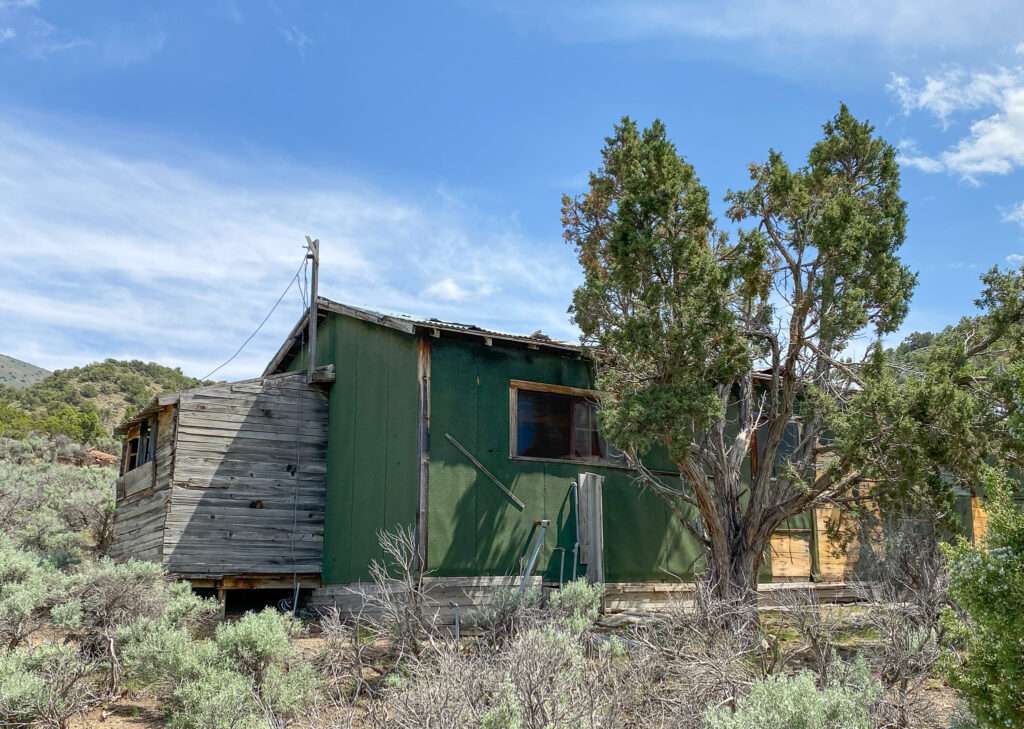
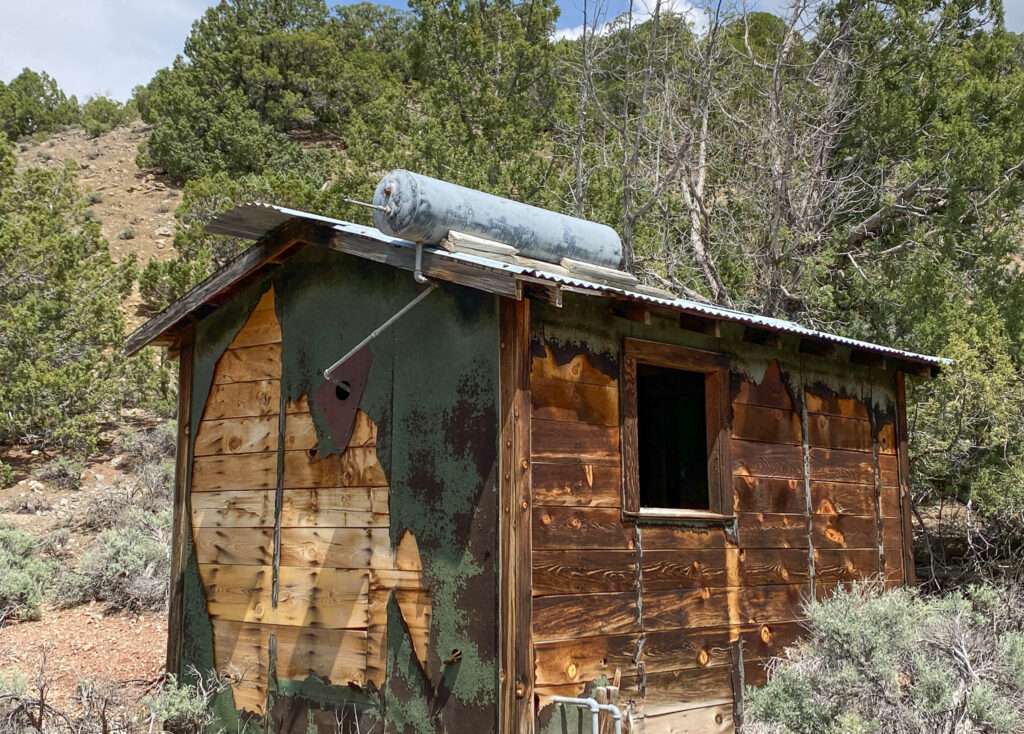
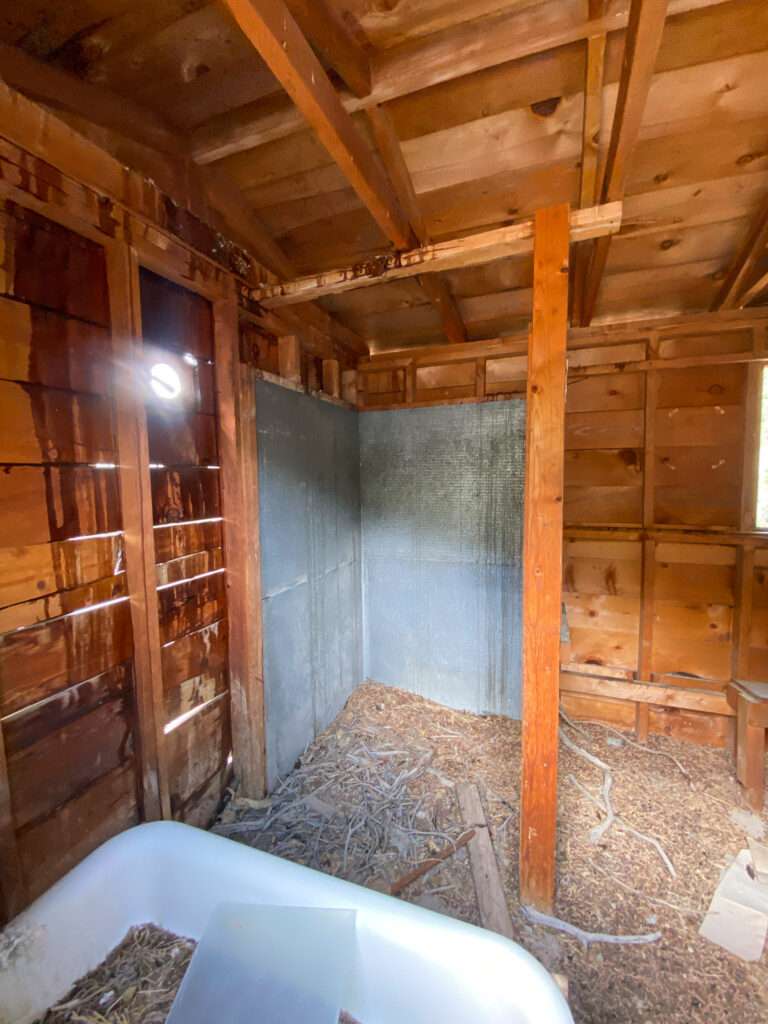
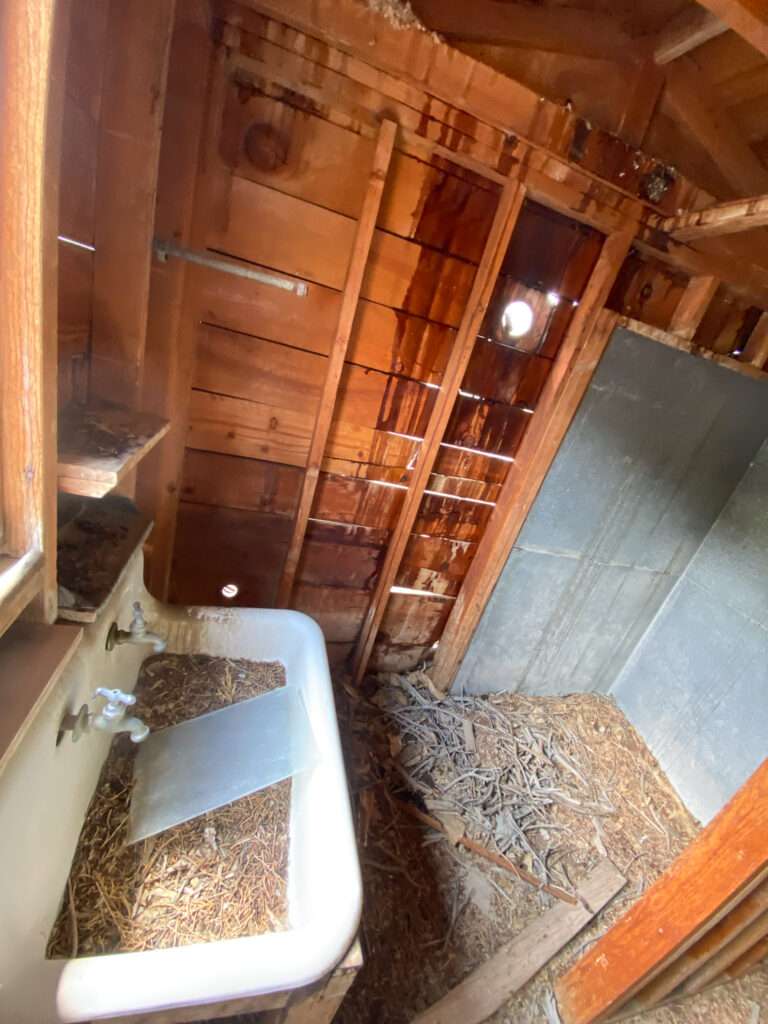
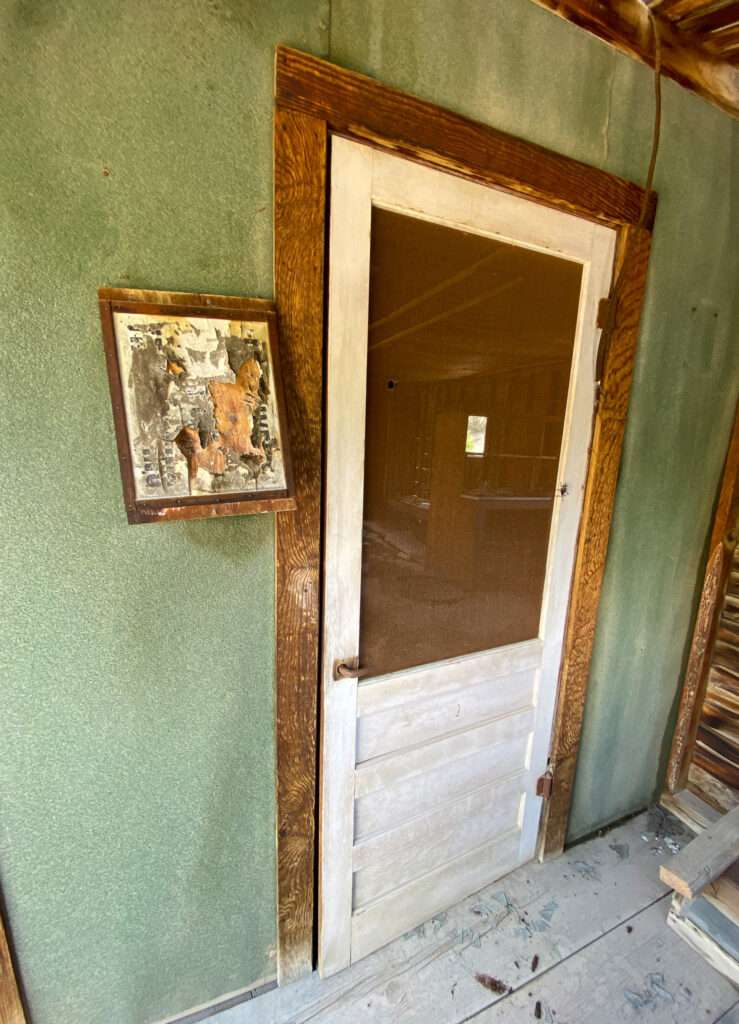
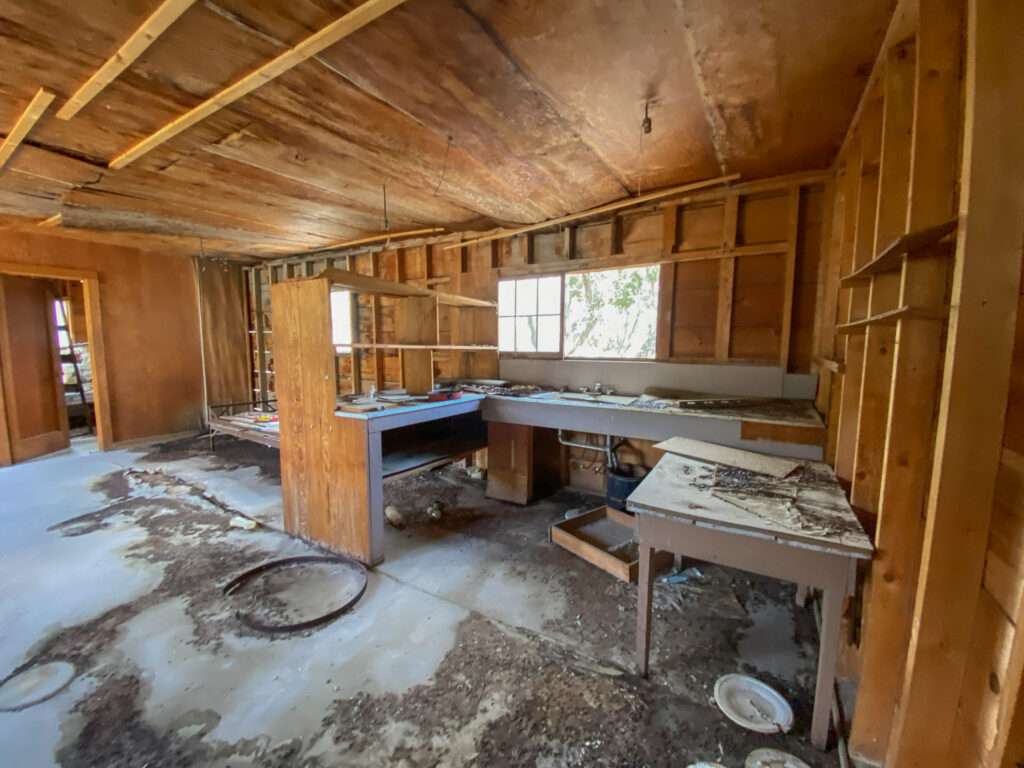
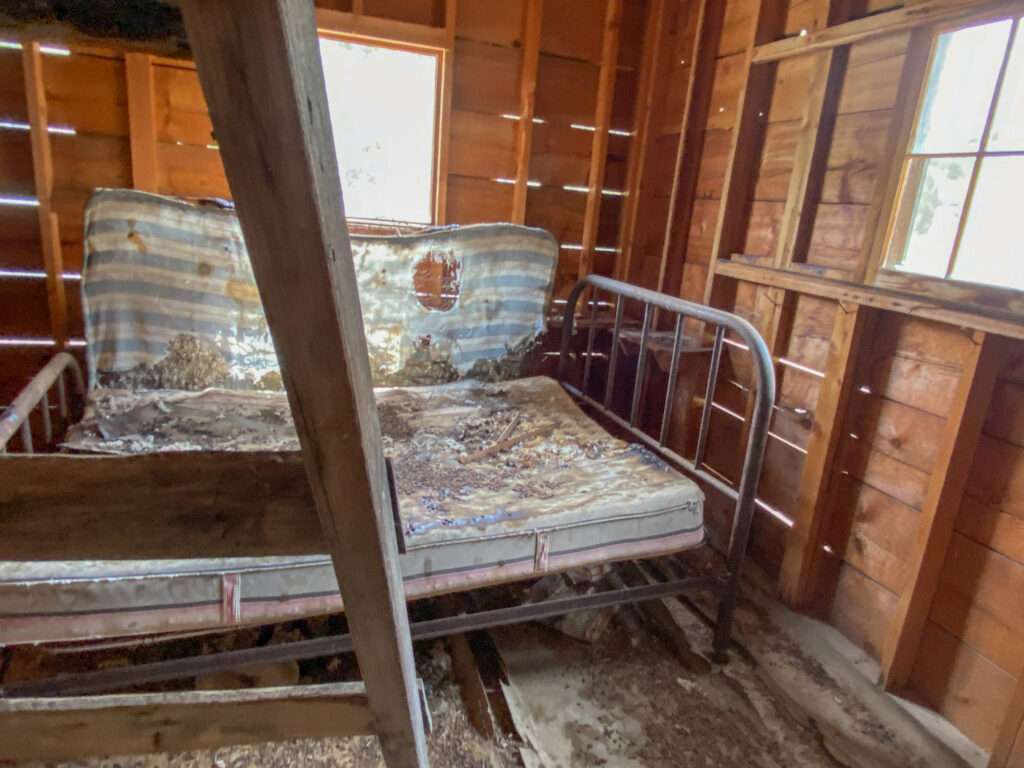
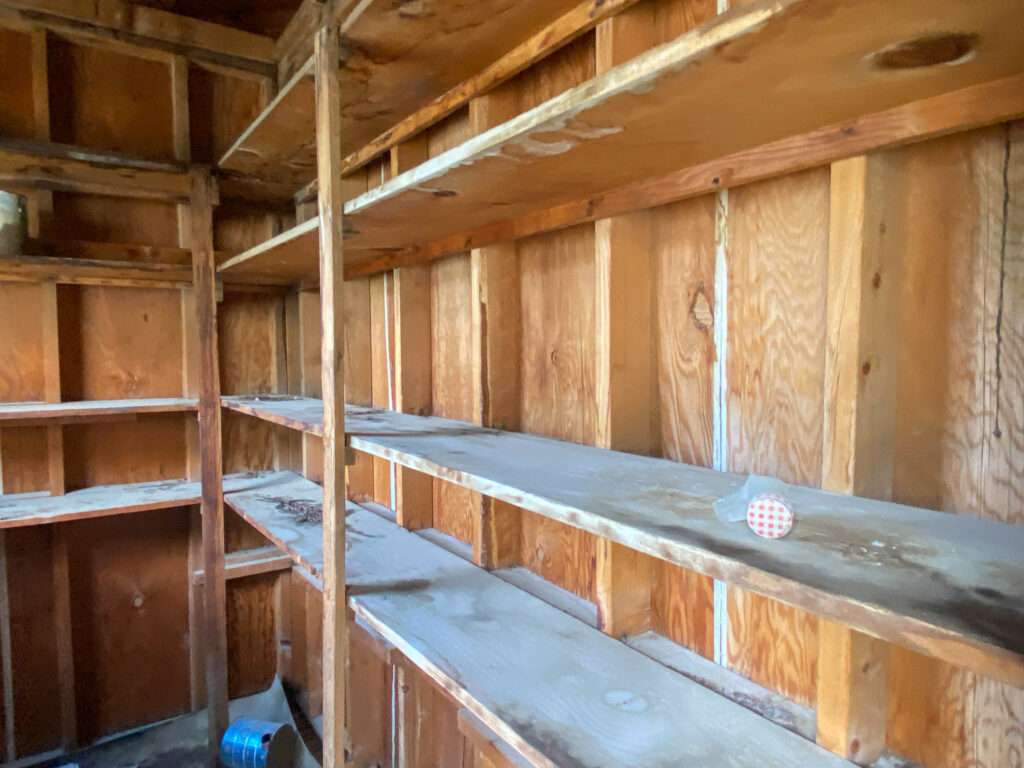

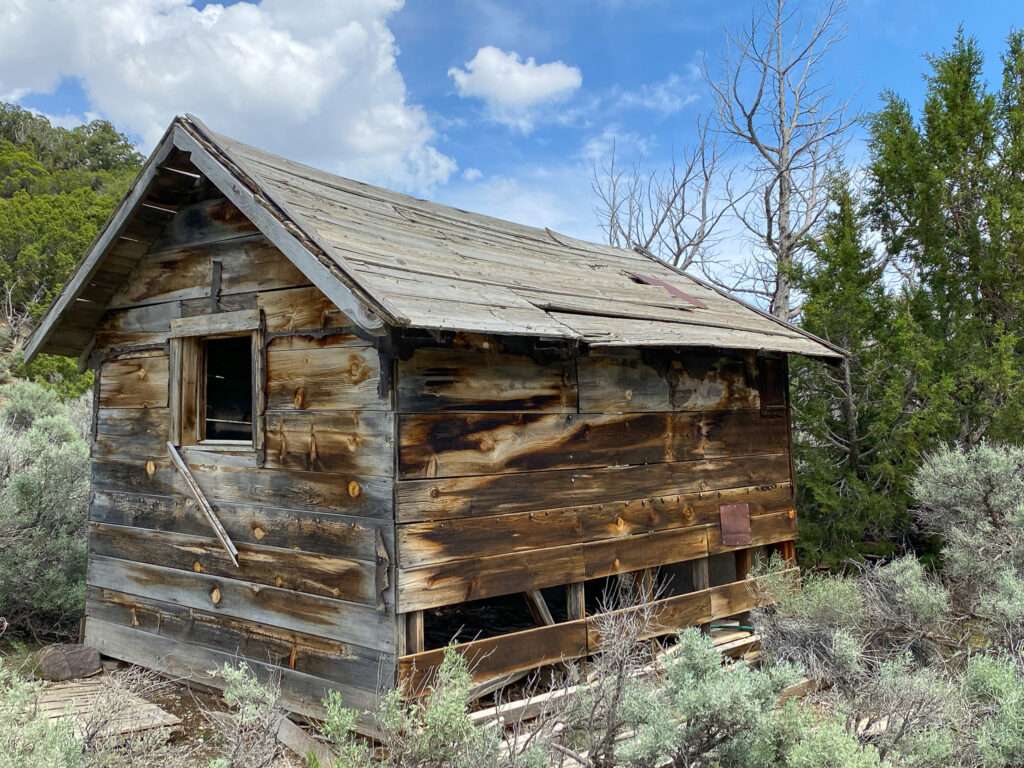
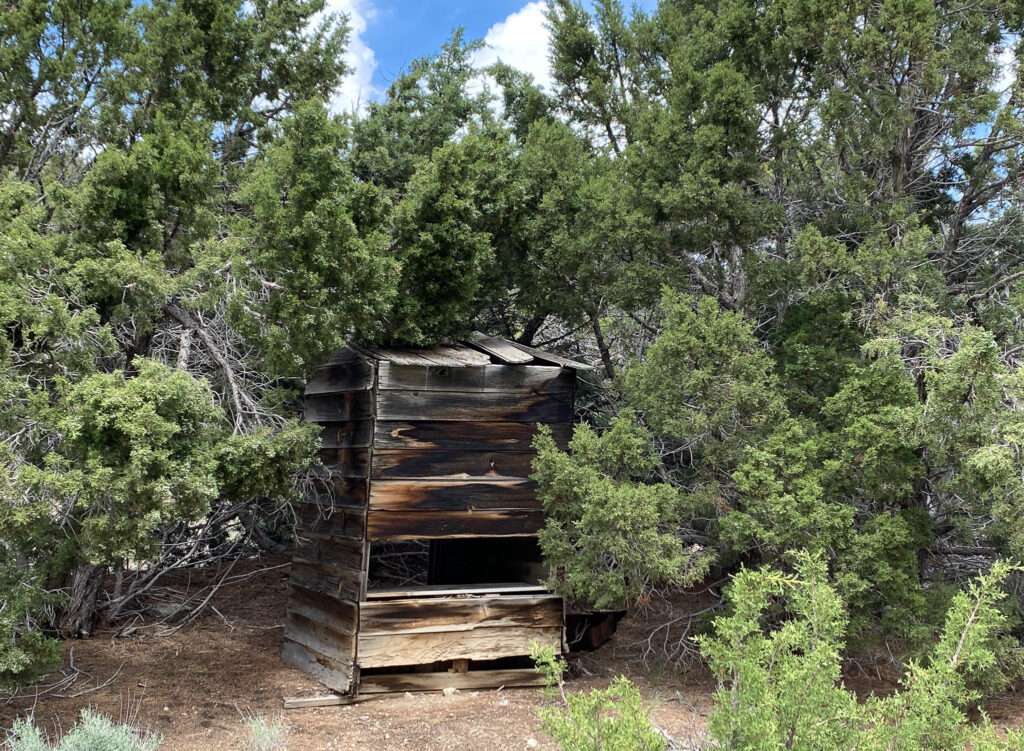
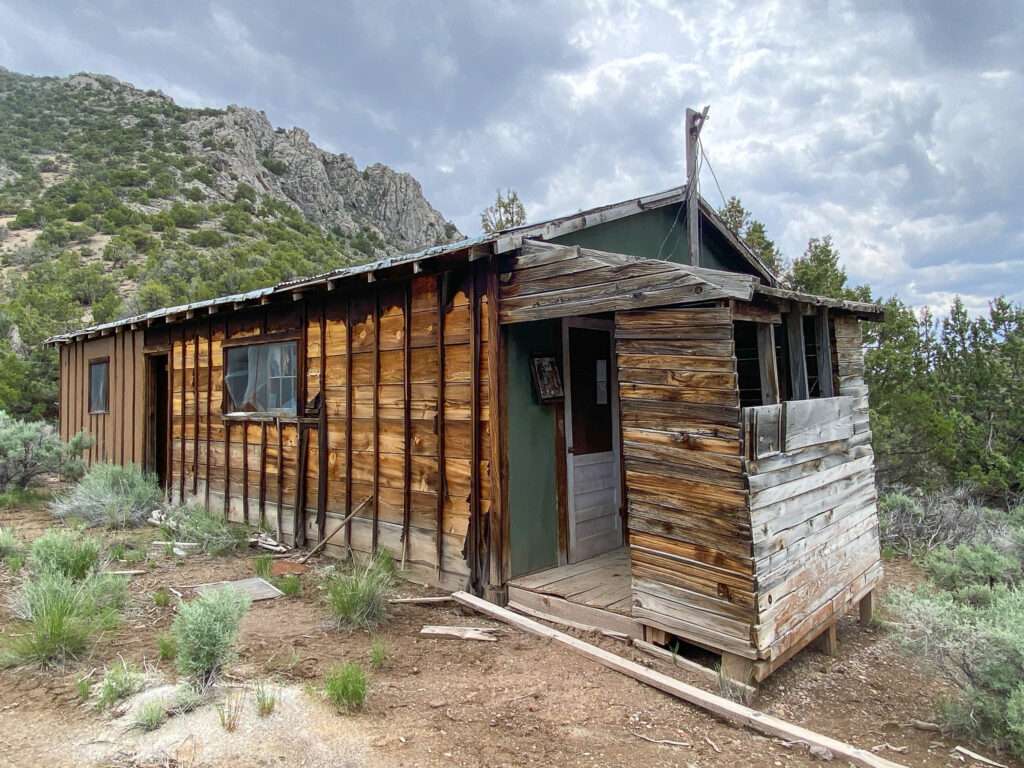

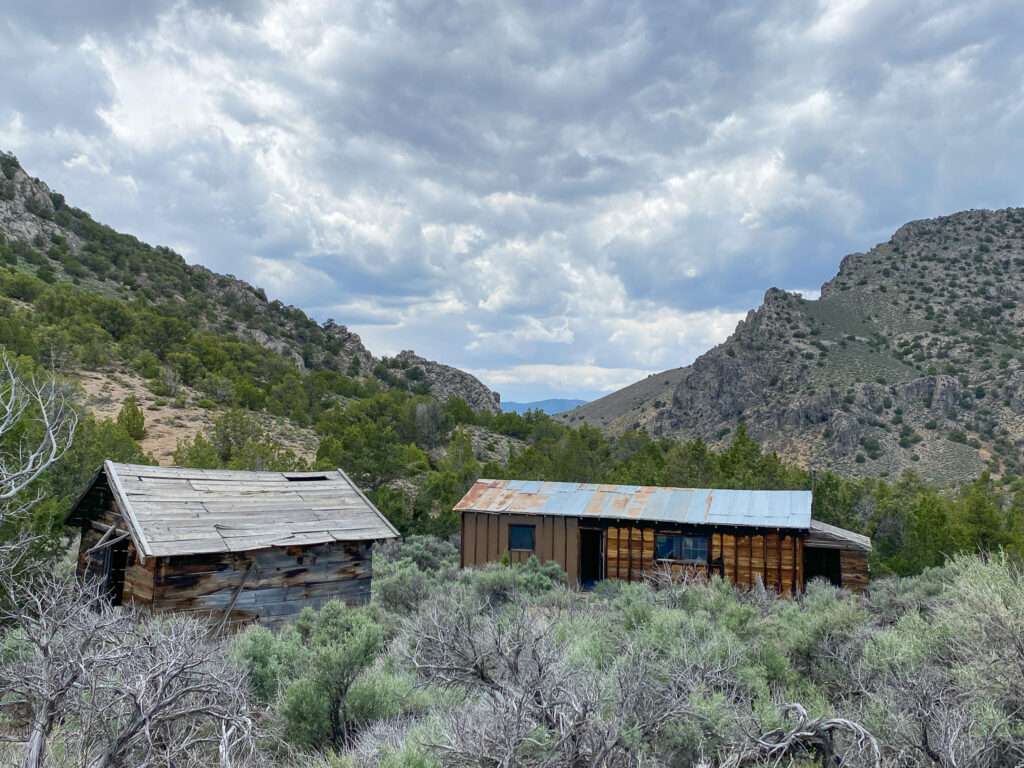
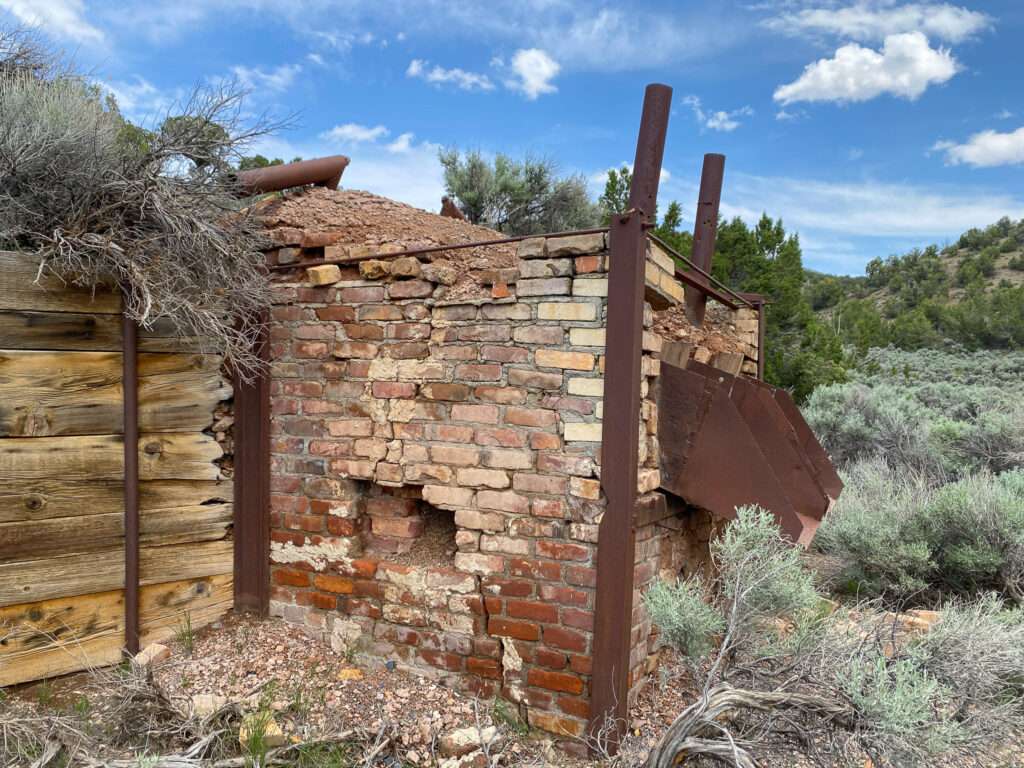
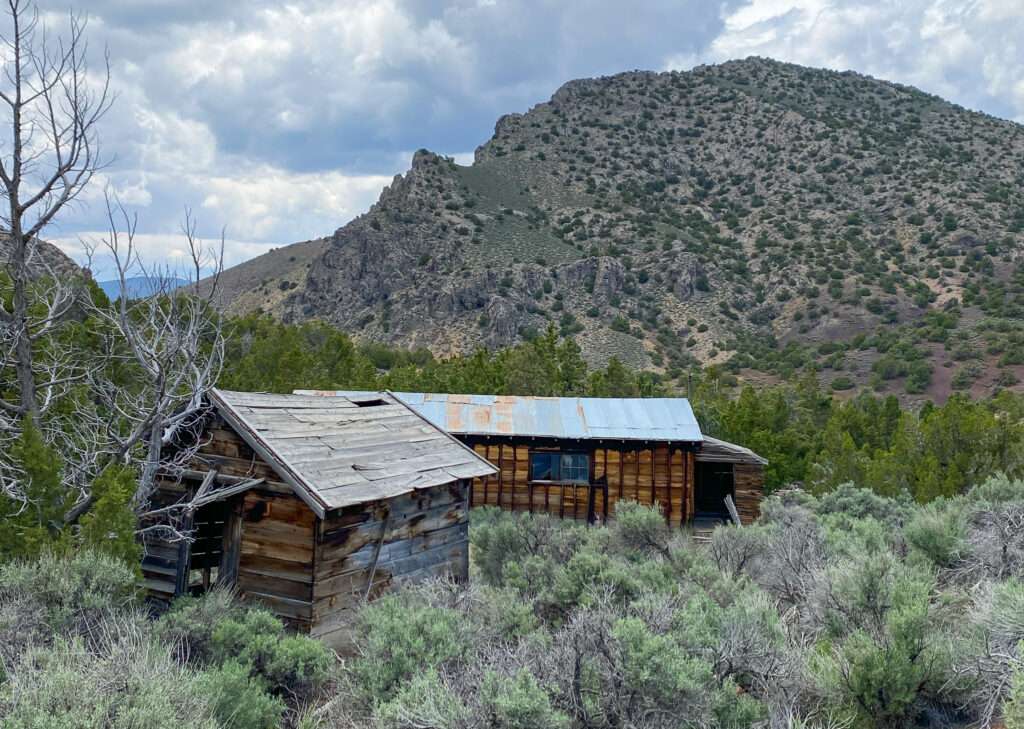
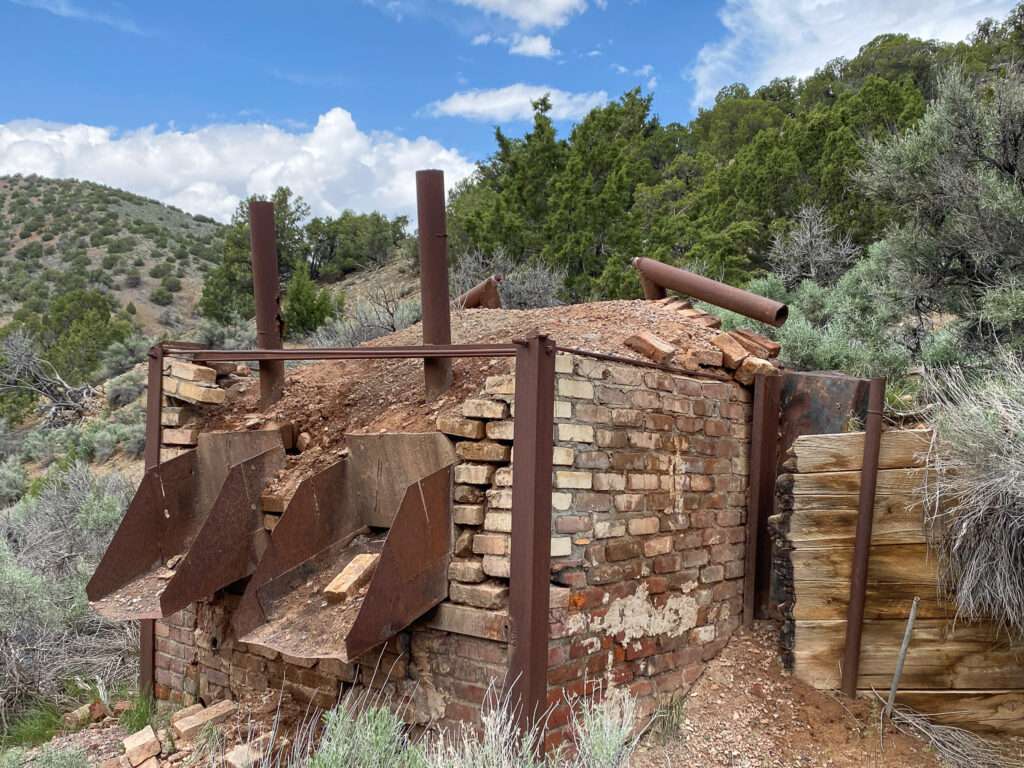
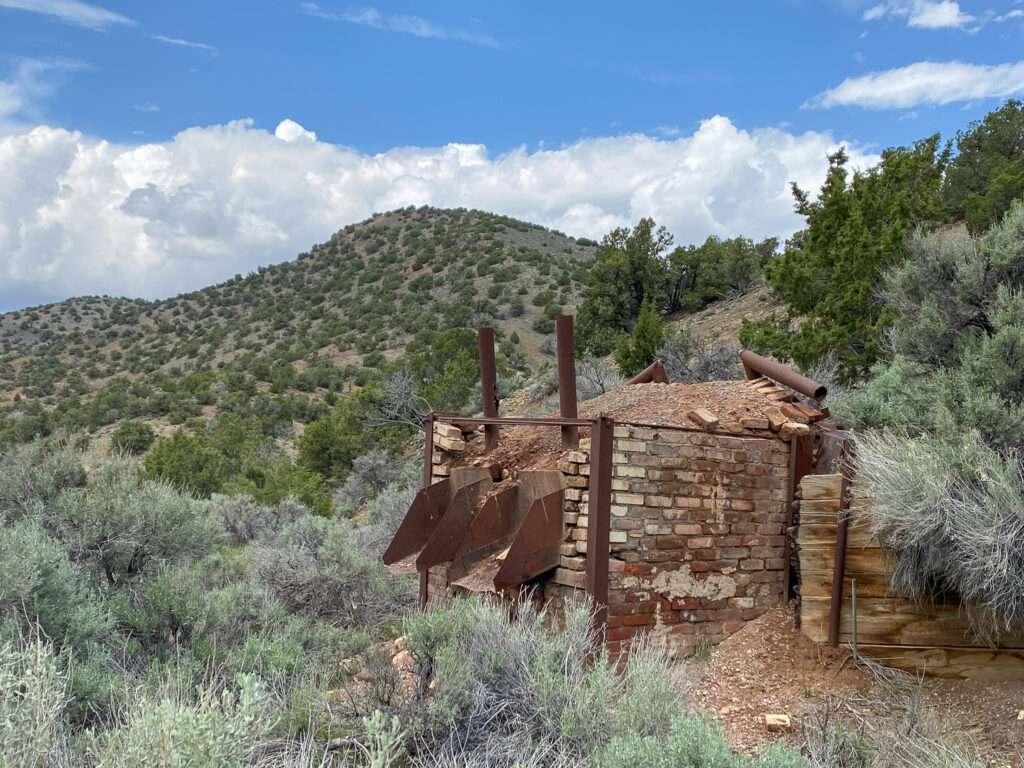
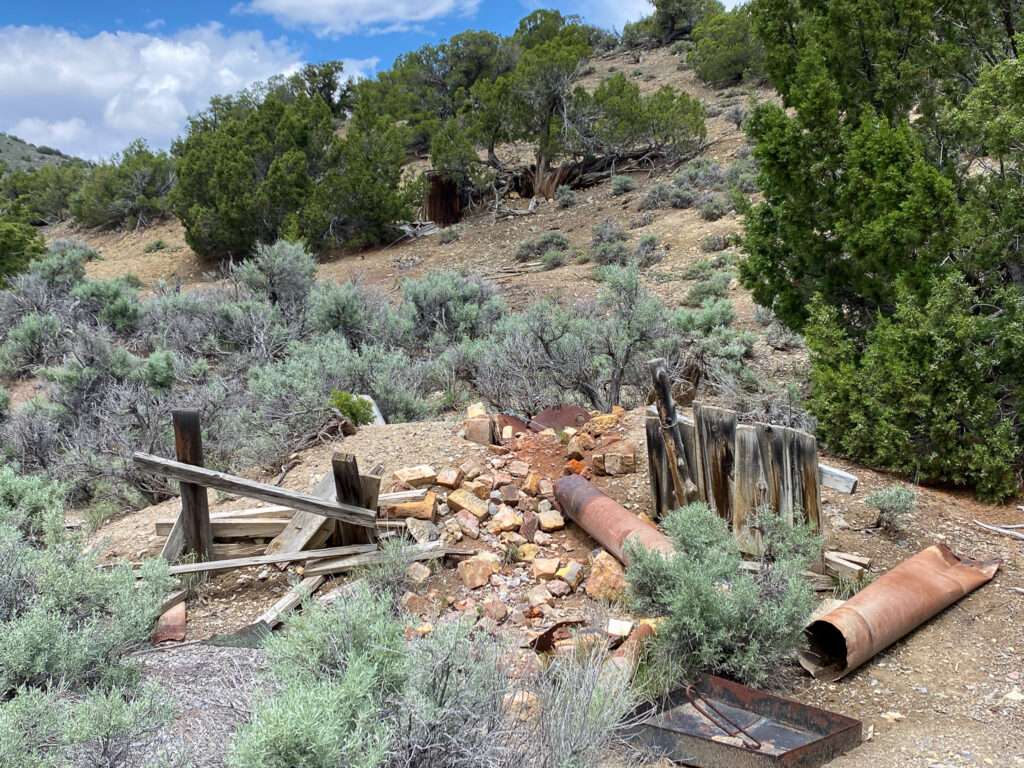
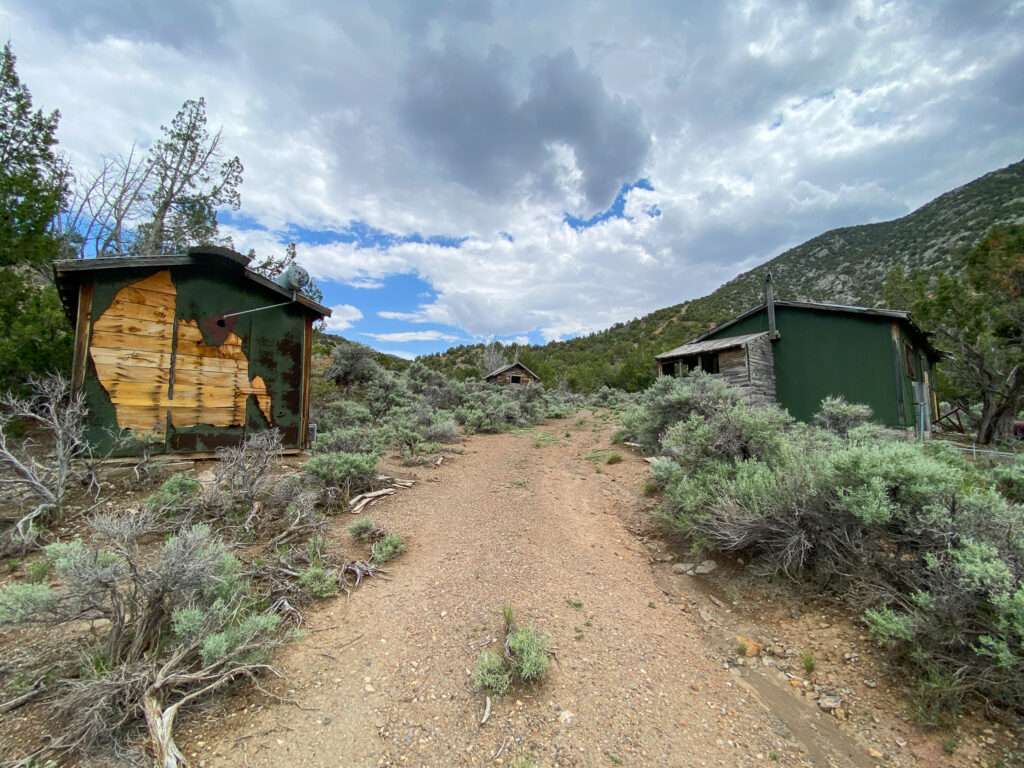
The Sanitorium of Nevada 1891
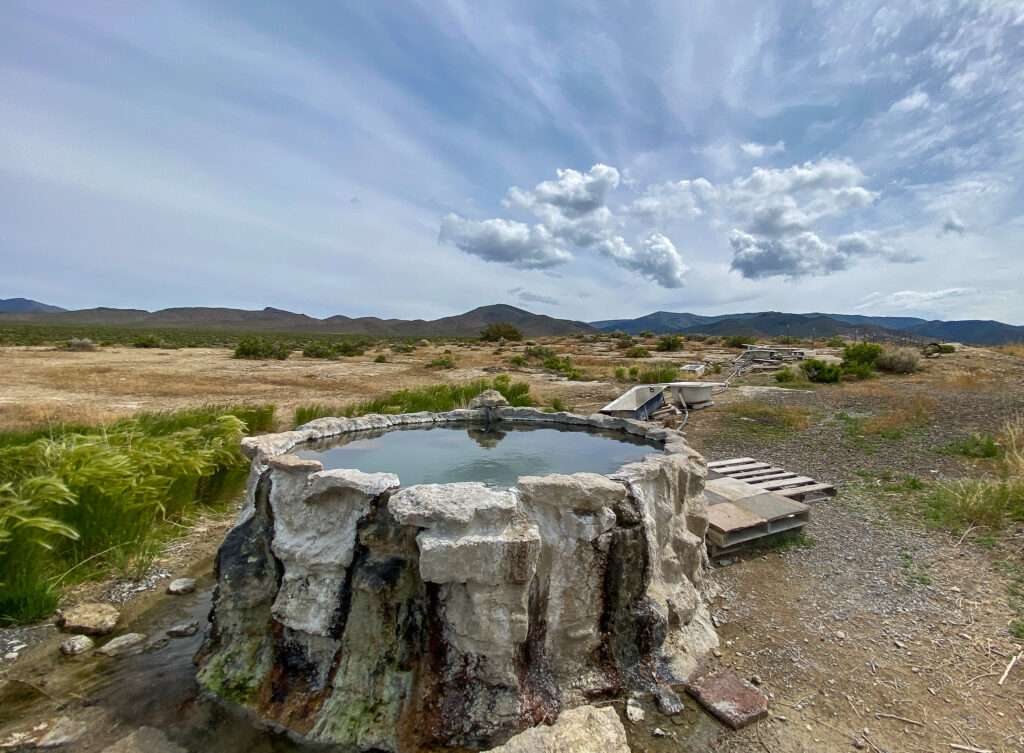
Our first stop on day two was at a well-known hot spring. I am leaving the name out as hot springers are even more protective of sites than ghost towners, which is understandable.
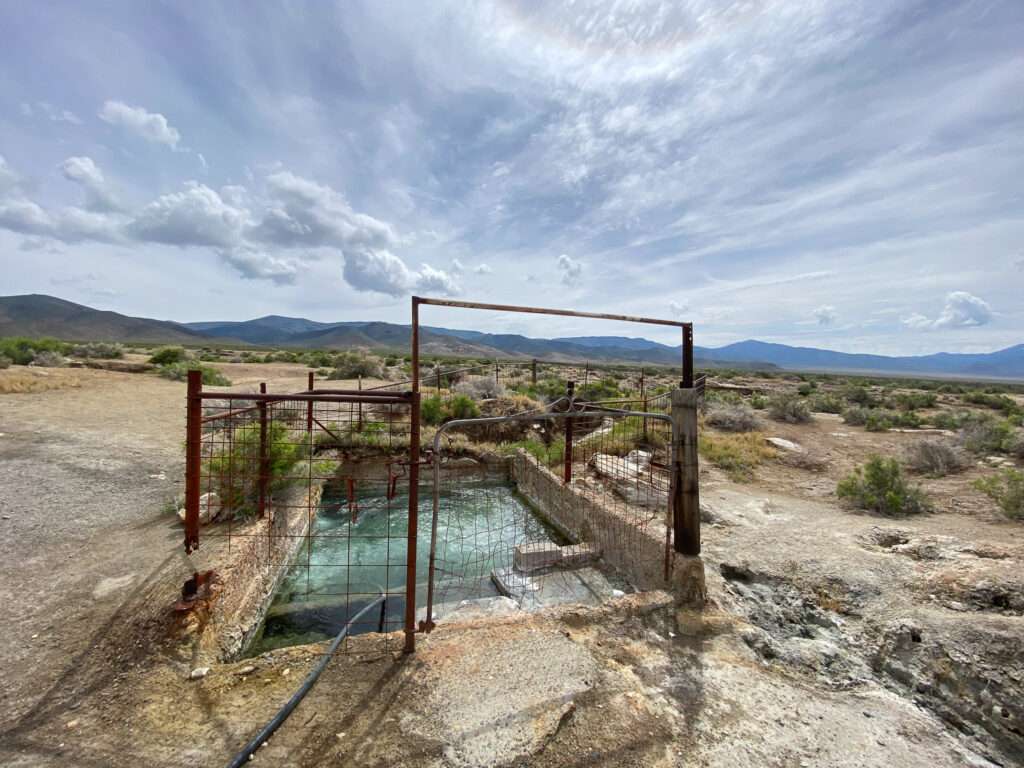
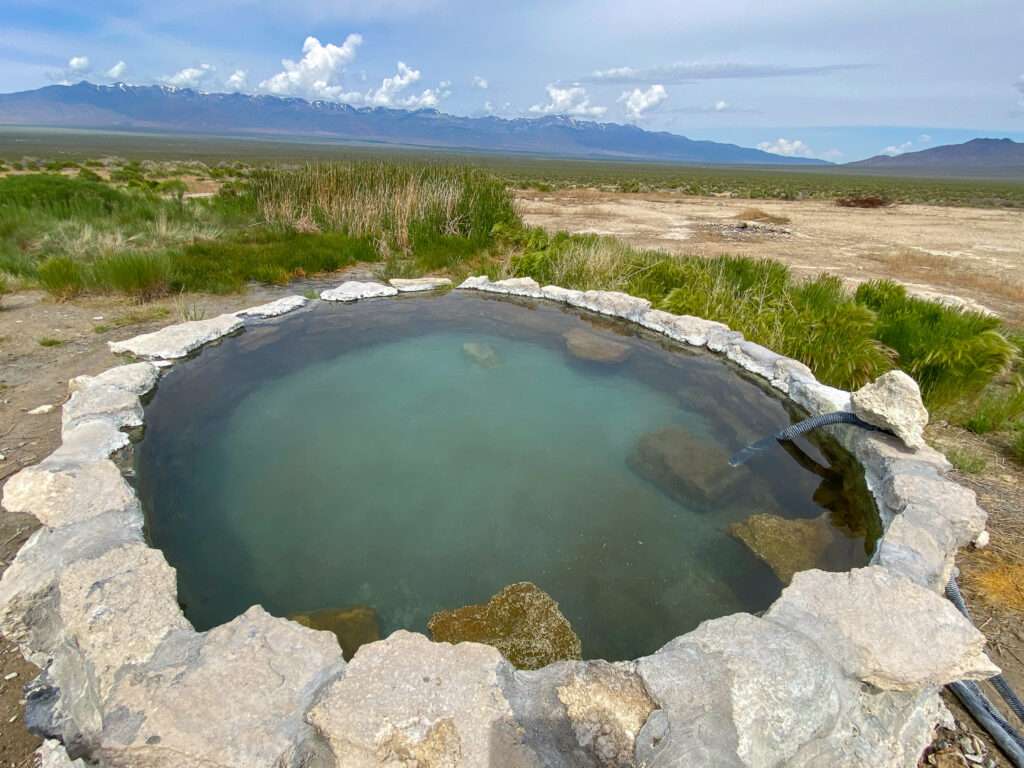
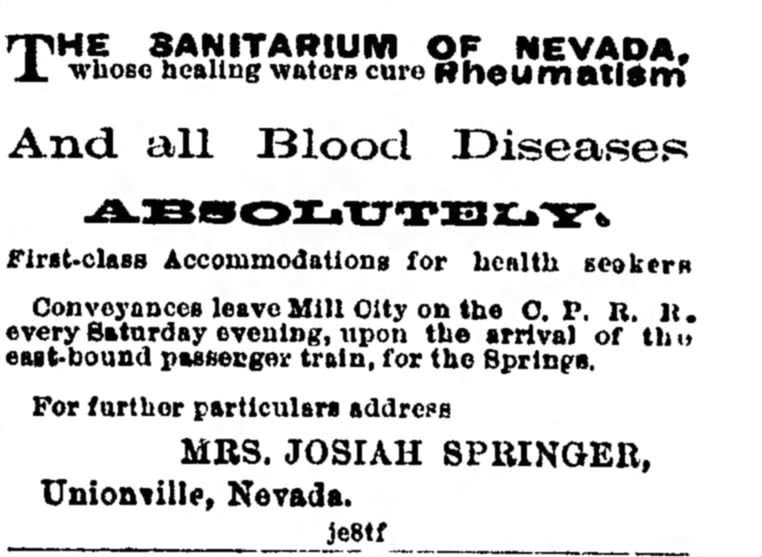
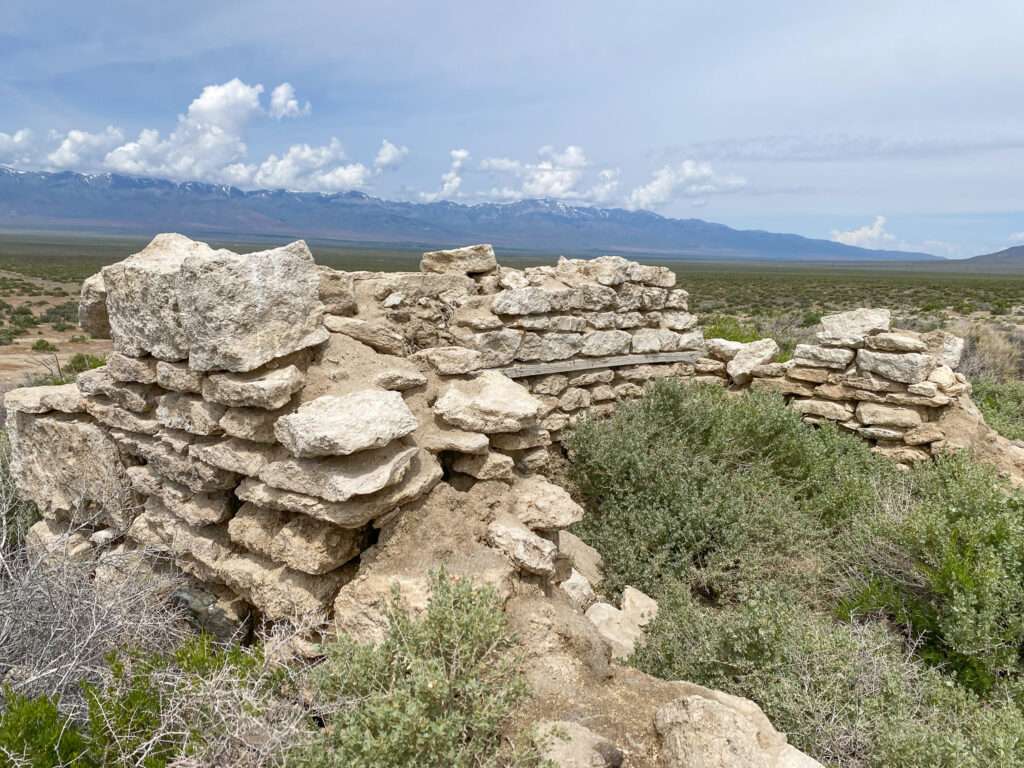
What held my attention was an abandoned rock building. In the late 1800s, the waters were reported to have “curative” properties. As early as 1875, newspapers were filled with accounts of people headed to the hot springs to spend up to several months at the hot springs for vacation, restoration or rusticating.
John Goldie and James Woods are back from …. Hot Springs looking as young as they used to be.
The Silver State, June 22, 1889
Mr. and Mrs. Reid are rusticating at…hot springs.
The Wadswroth Dispatch, October 9, 1895
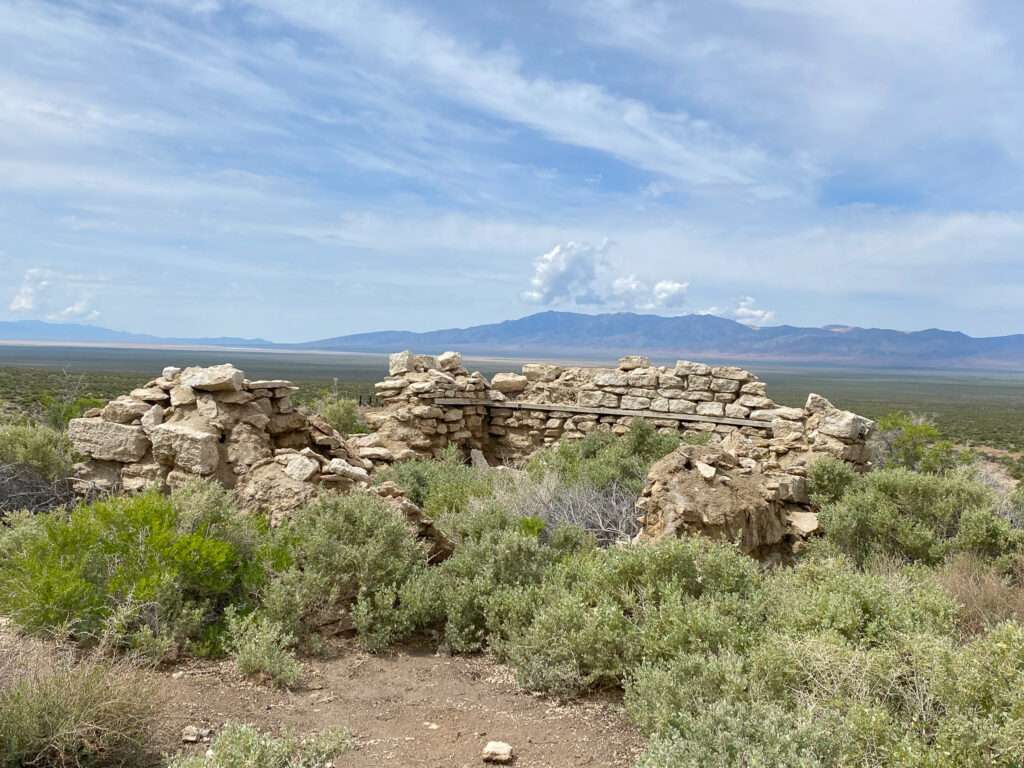
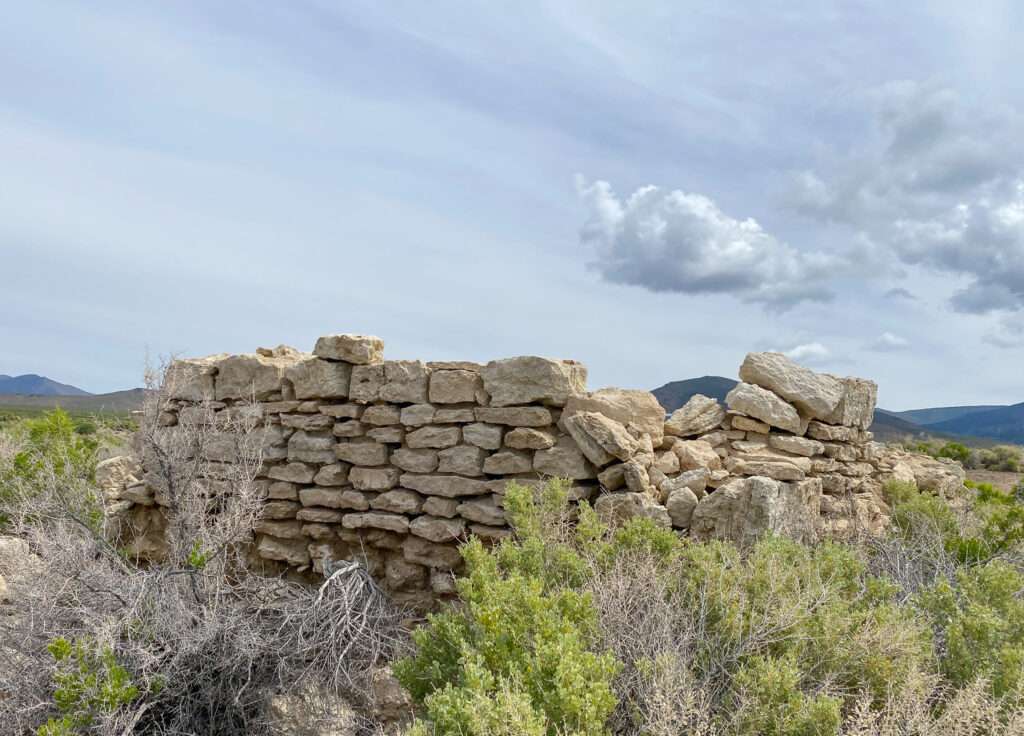
This isn’t the weirdest thing I have found in the Nevada desert, but it is close.
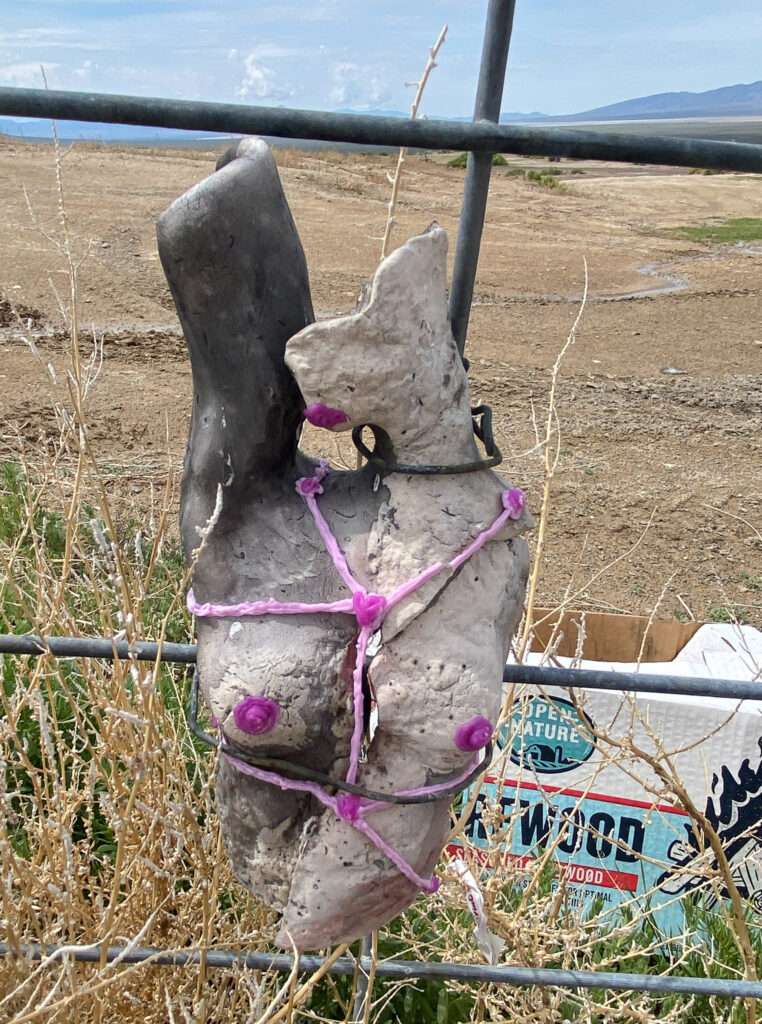
Henrietta
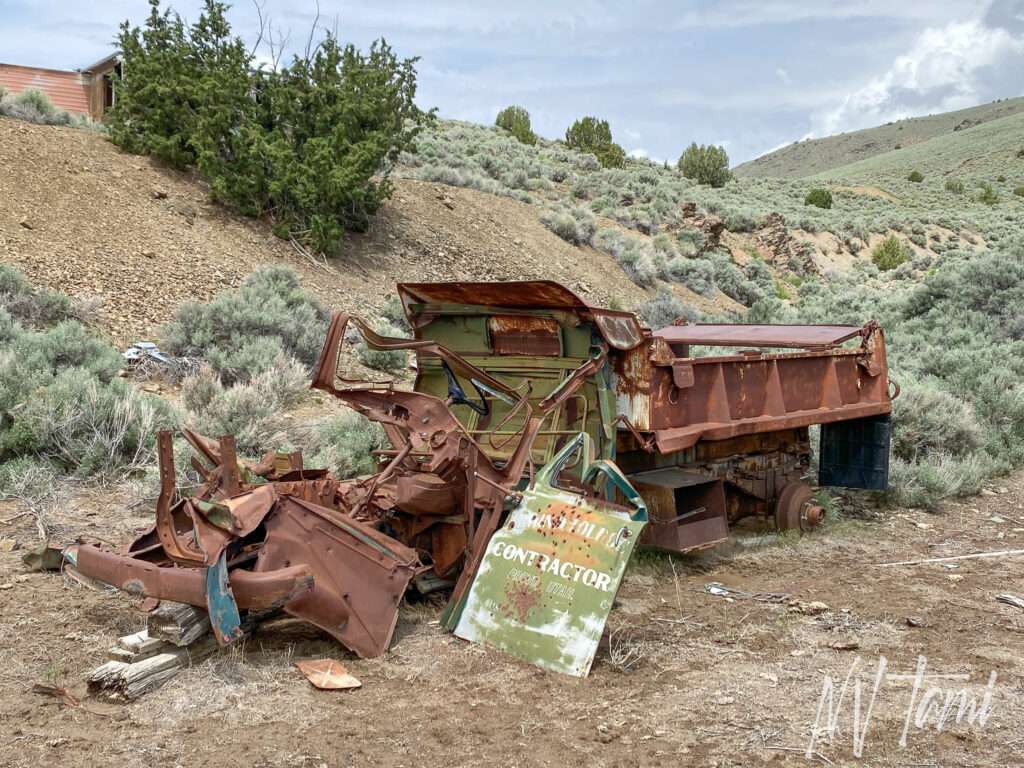
Prospectors discovered silver and gold at the Henrietta mine in 1875. The lower section of Henrietta has a mid-century trailer. Miners worked the claims intermittently until 1950.


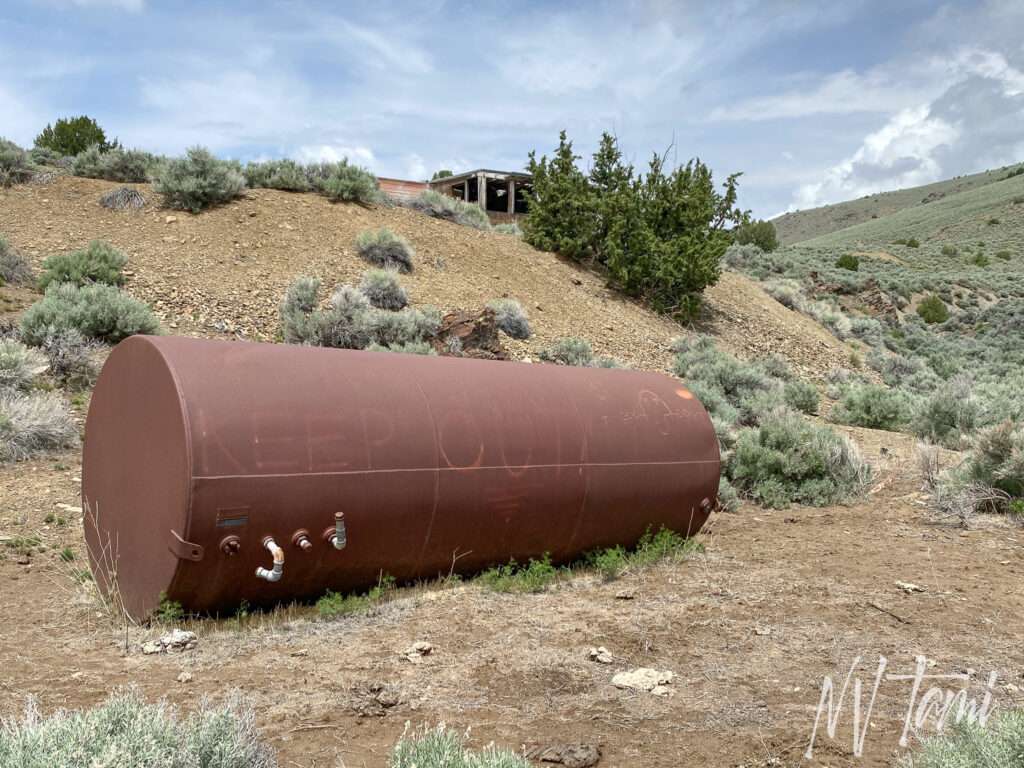
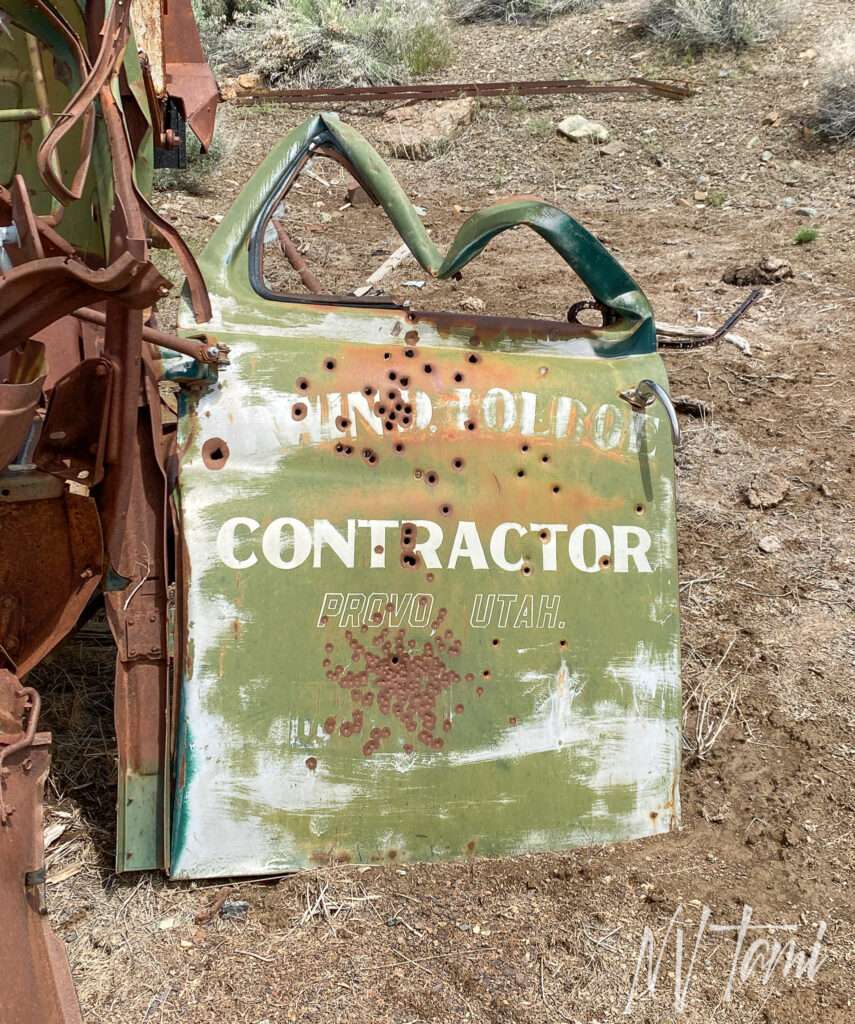
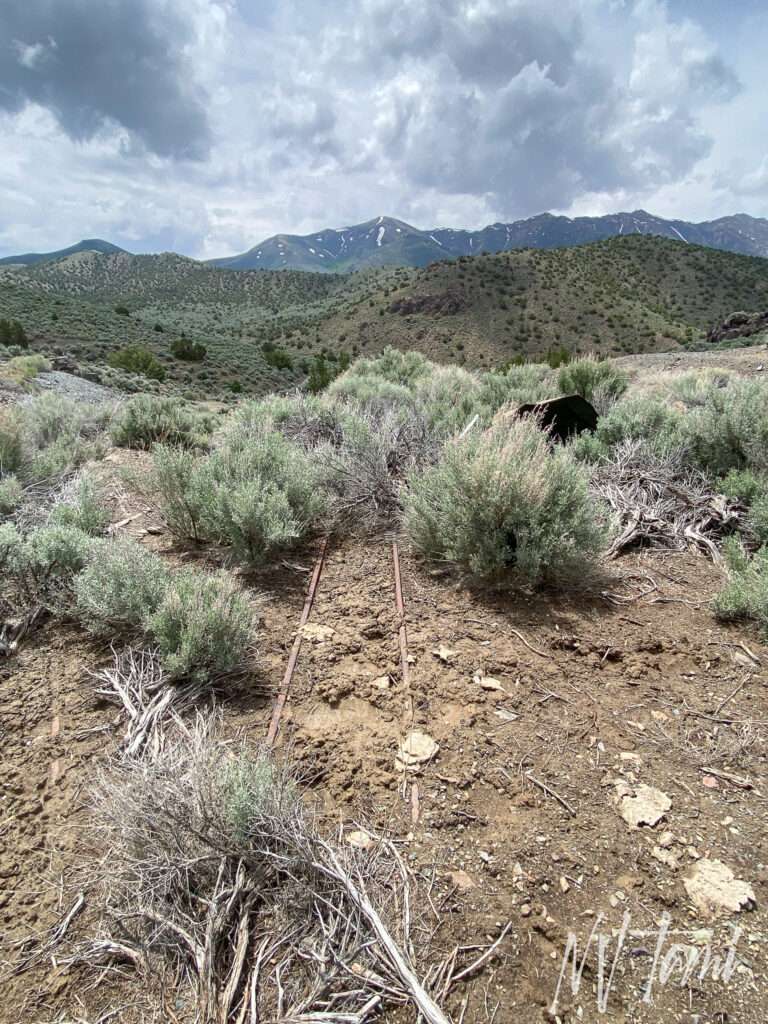

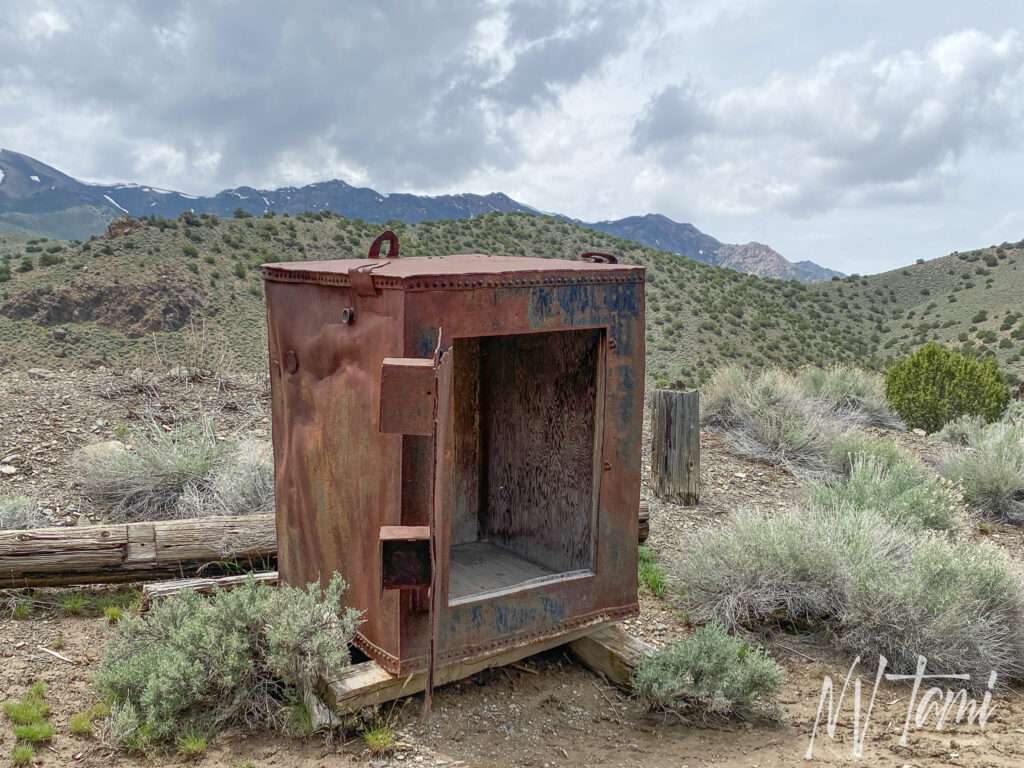
Gold Note Canyon Foundation
Along the banks of Gold Note Canyon are the remains of a stone foundation. Gold Note Canyon is part of the Kenney Mining District. It first prospected in early 1890 for gold and silver. The foundation might have been a prospector’s residence; he certainly picked a beautiful location.

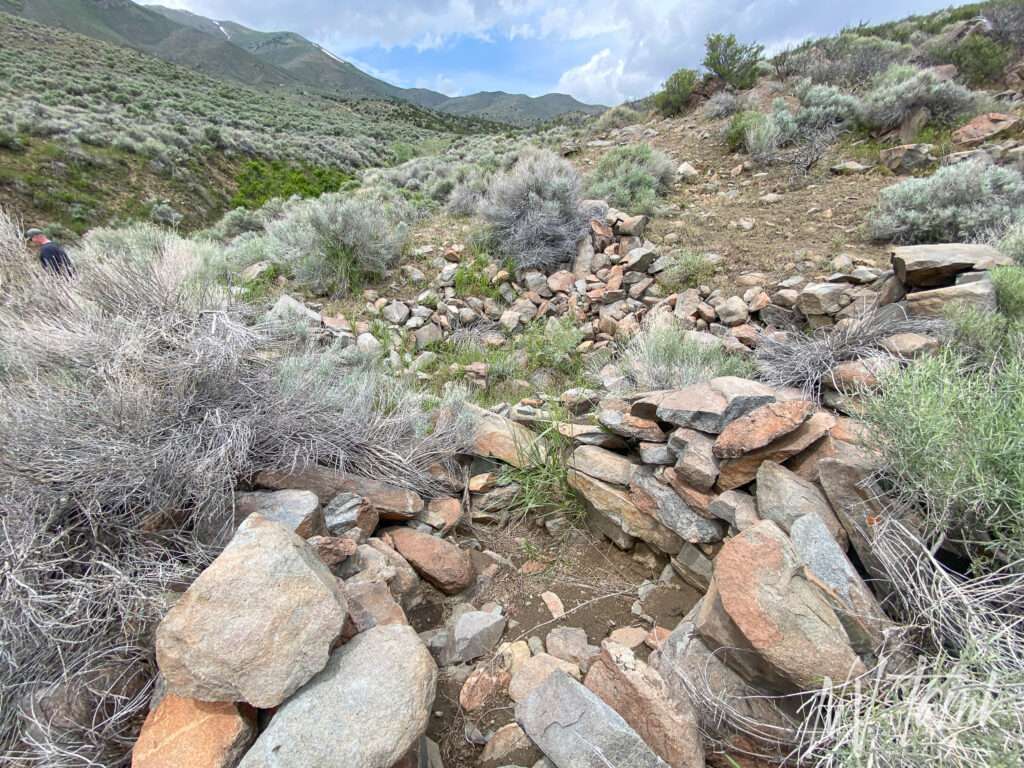
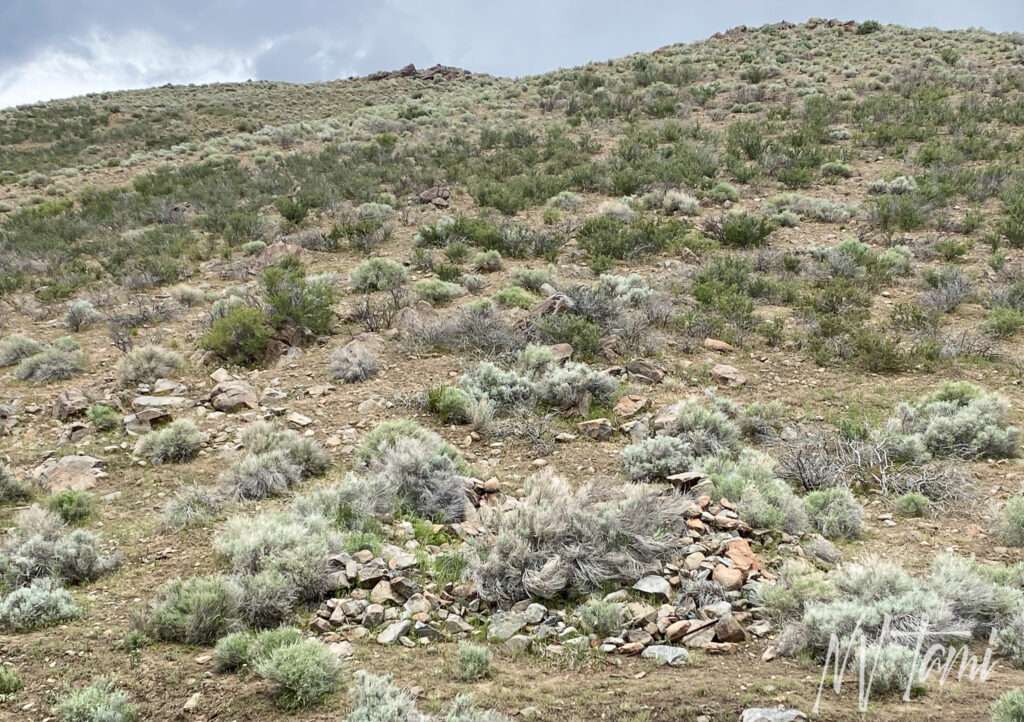
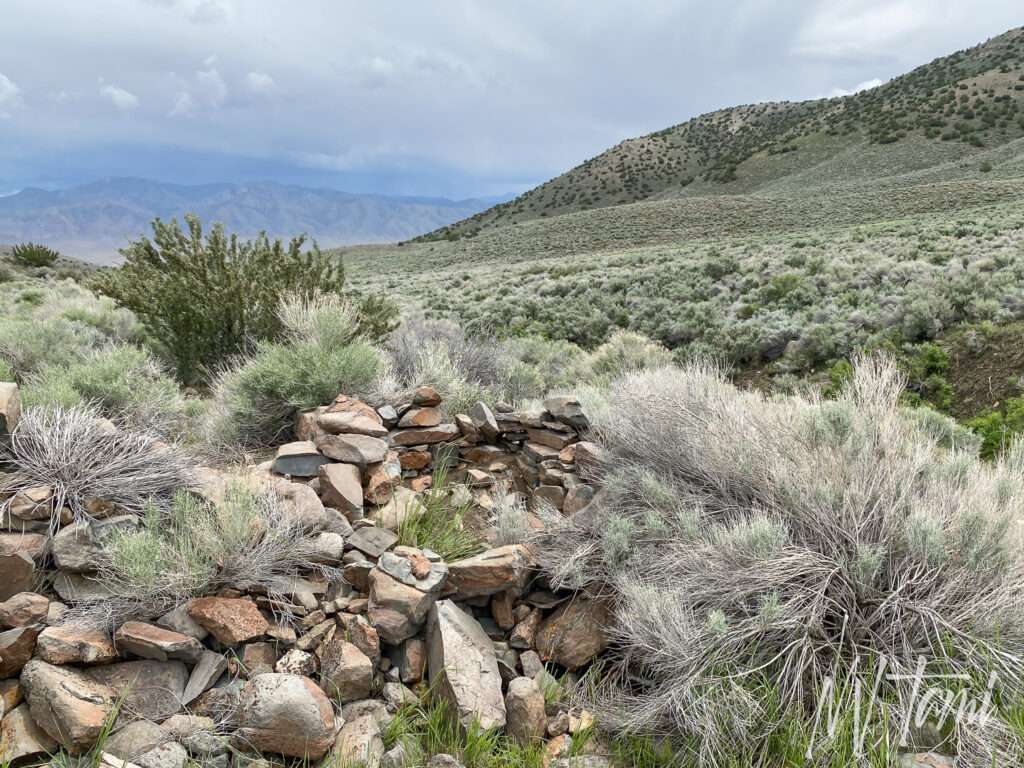
Kennedy
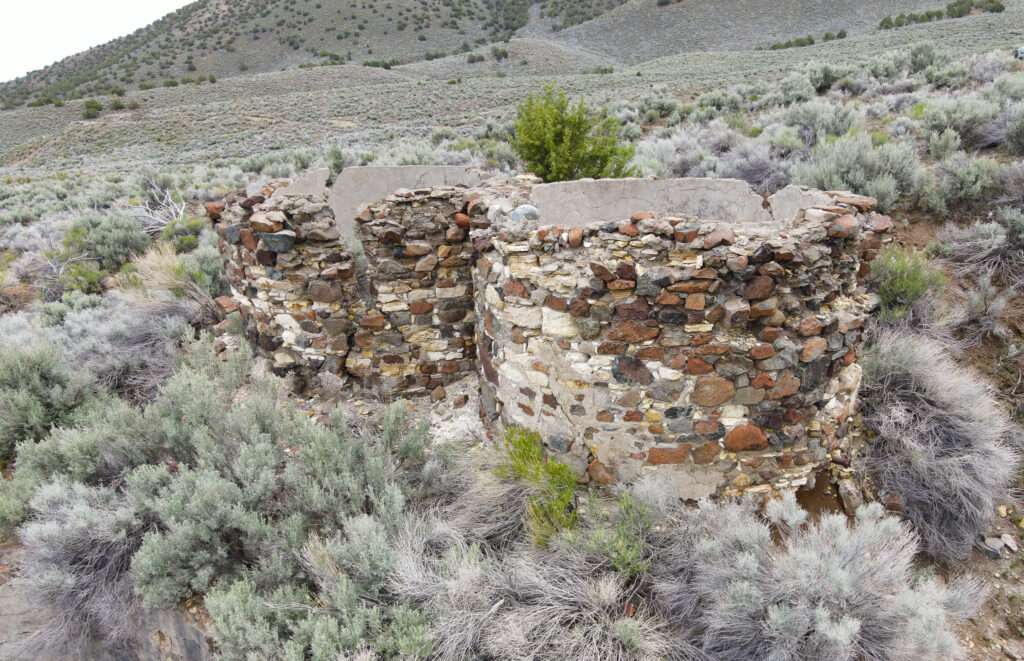
An investor paid Esmerelda County prospector Charles E. Kennedy to explore the area at the base of Granite Mountain. He departed from Winnemucca in 1891 with two horses and a wagon of supplies. The investor joined him in 1892. Kennedy discovered the Imperial and Cricket Mines, and soon word spread. A mining camp named in honor of Kennedy grew, and by 1894, included stores, saloons, a school and a population of five hundred. A post office opened on January 15, 1892.
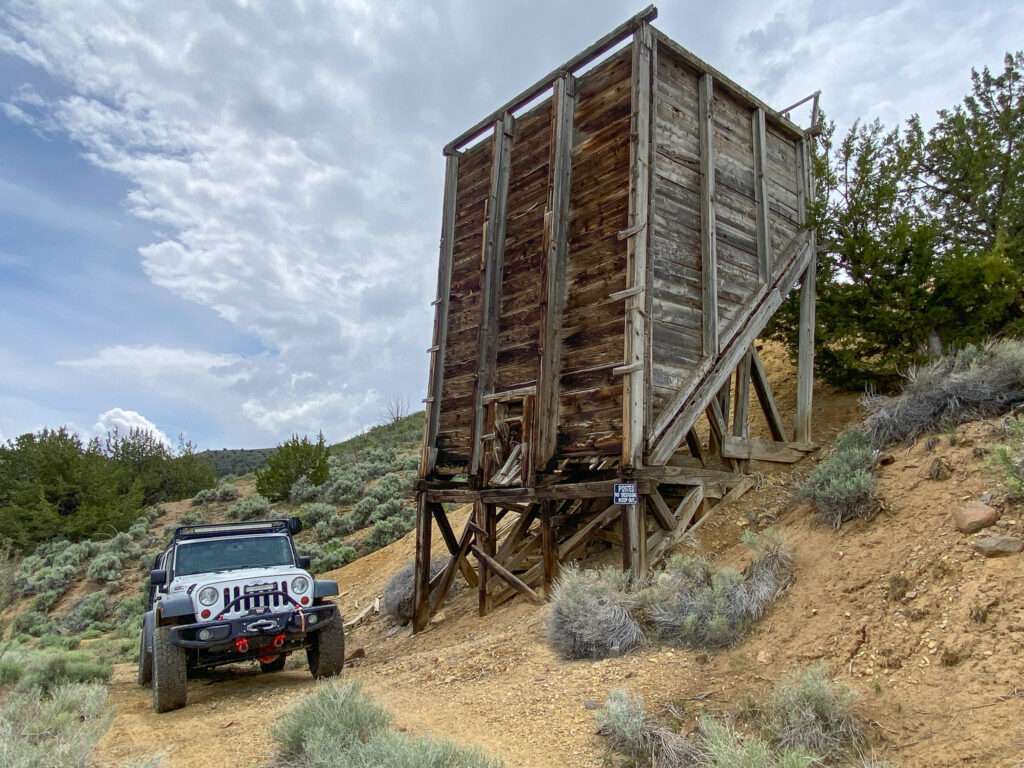
Frank Francis became publishing the Nevada New Era newspaper on June 23, 1894. He won a seat in the state assembly that year and relocated, publishing his last issue on December 30, 1894.
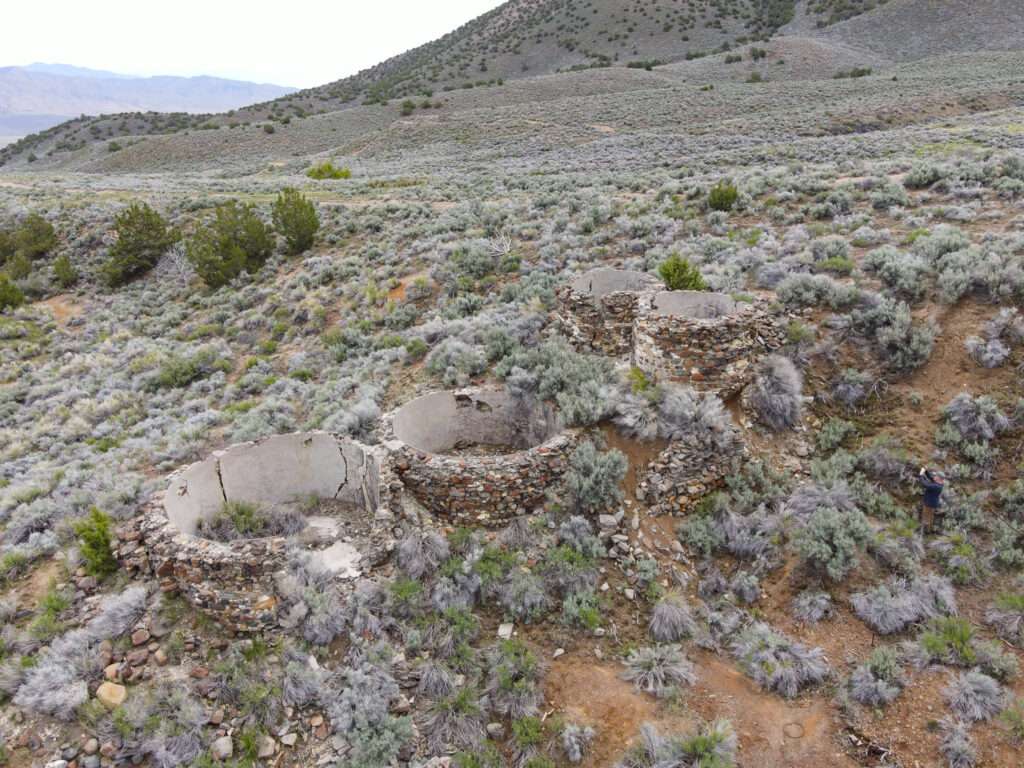
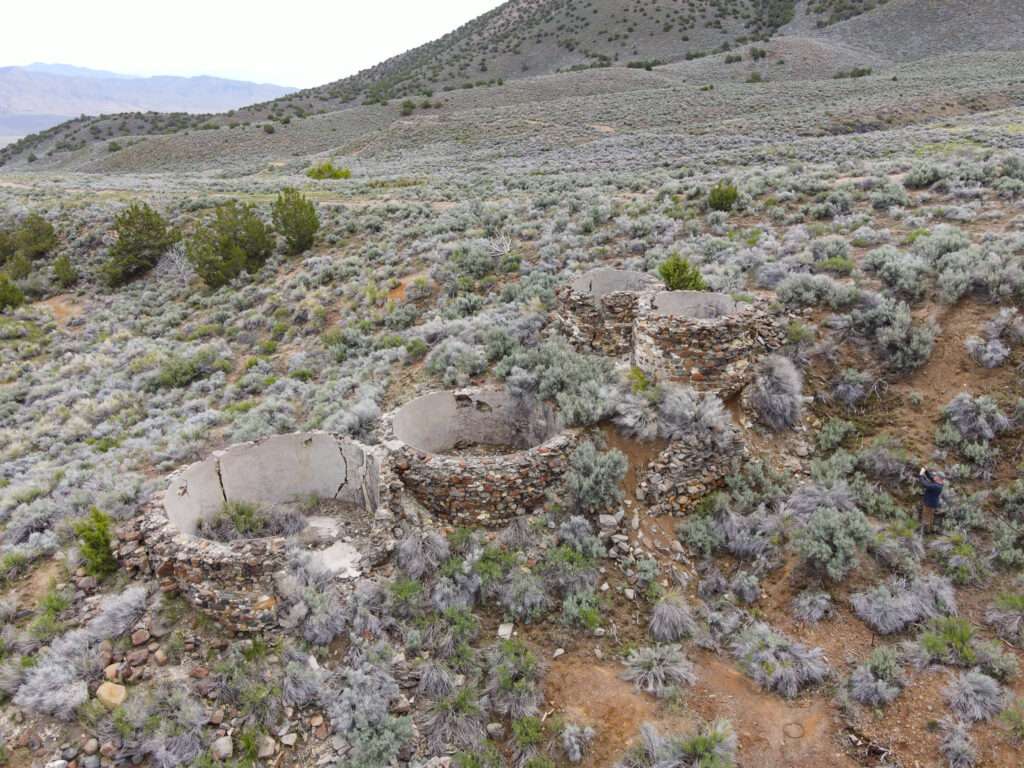
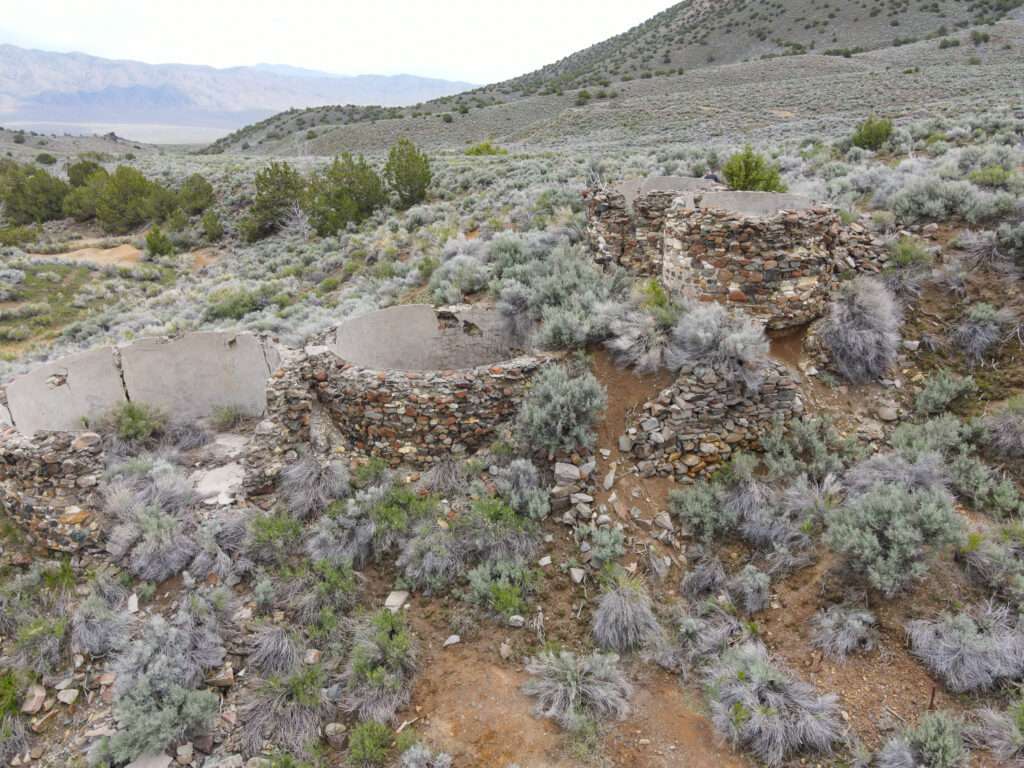
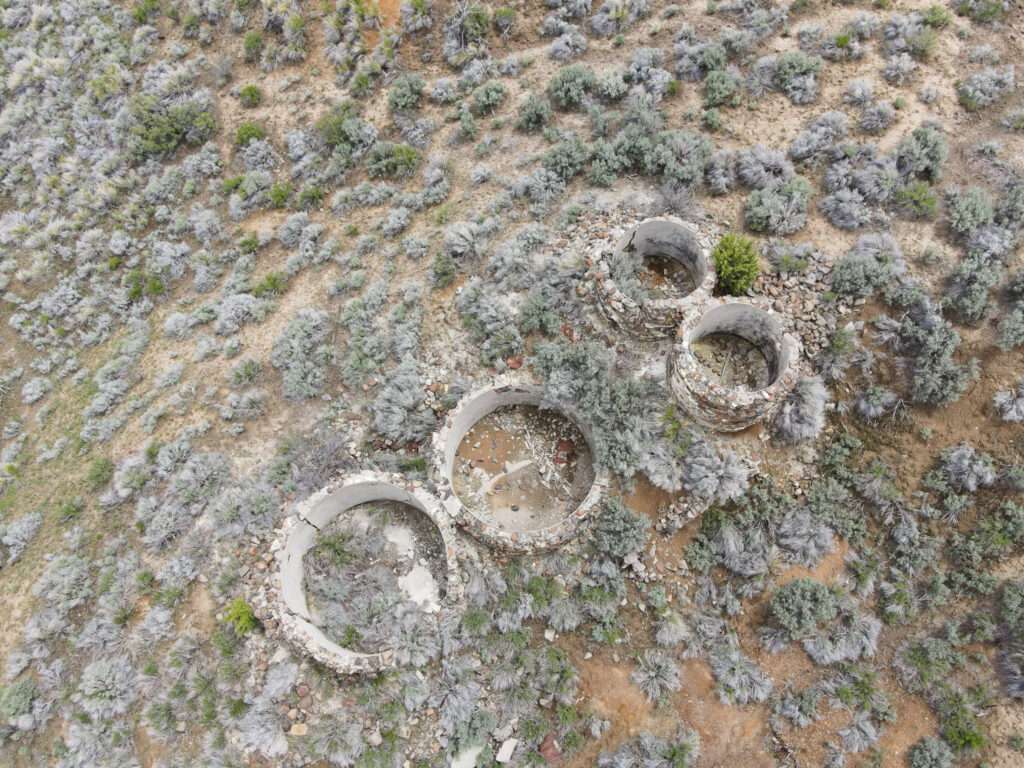
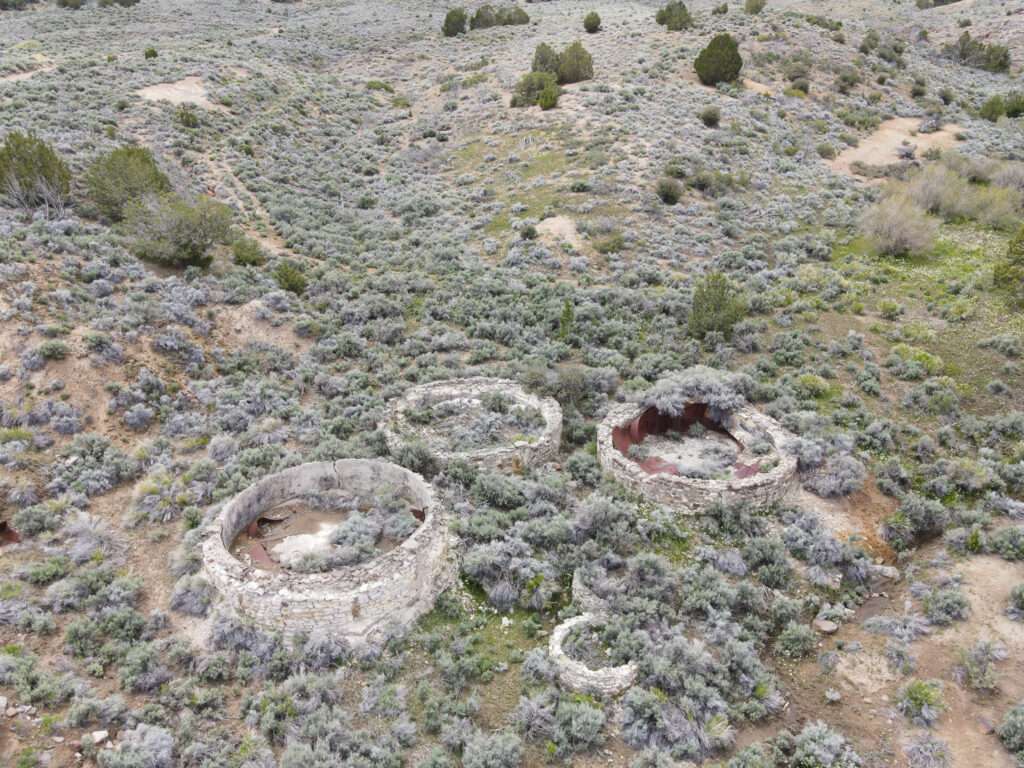
The Imperial Mine built a 20-stamp mill in 1895, and two smaller stamp mills operated in the area. They added a leaching plant in 1901 but only operated until 1905. Kennedy clung to life until the post office was closed on December 15, 1917.
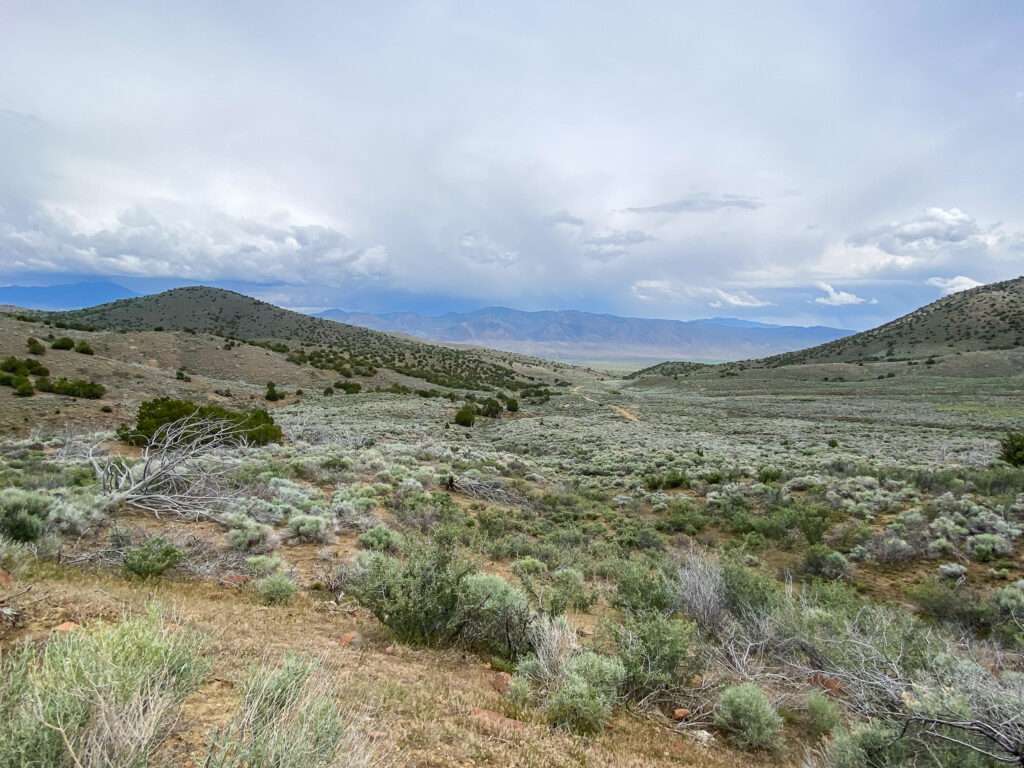
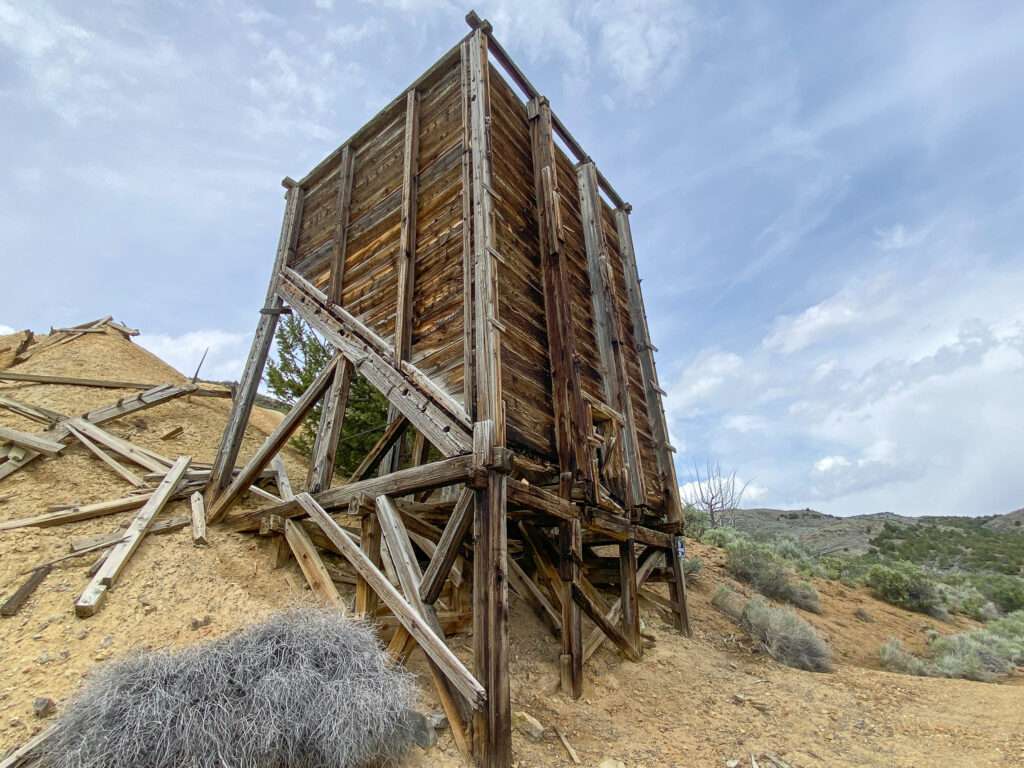
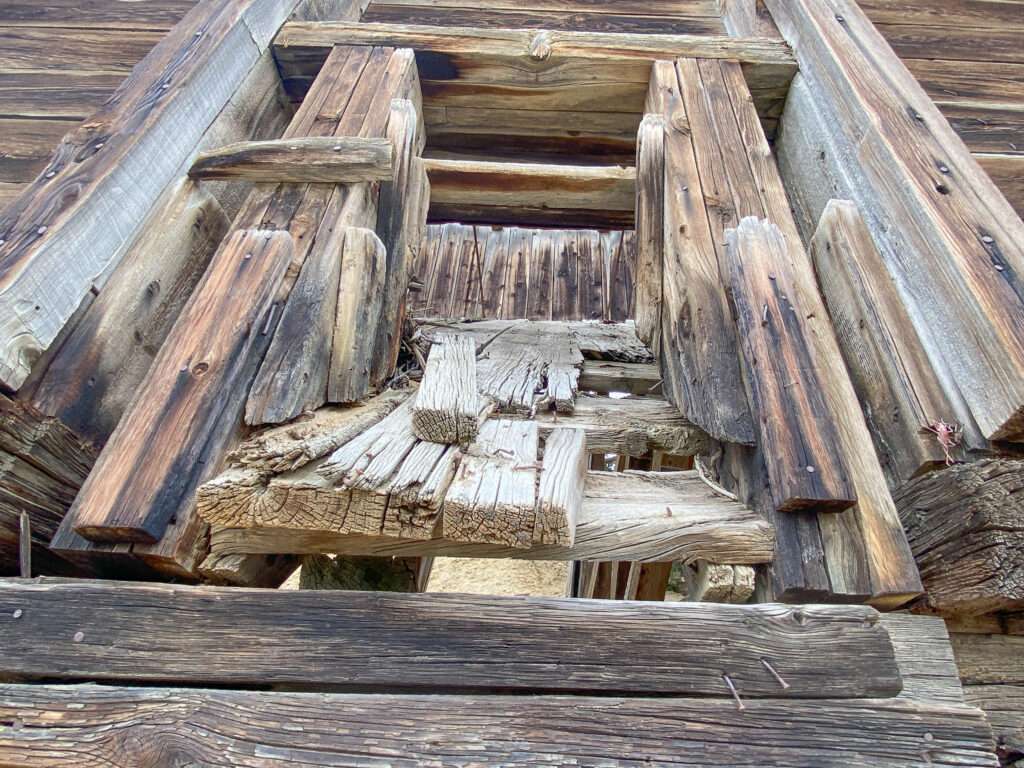
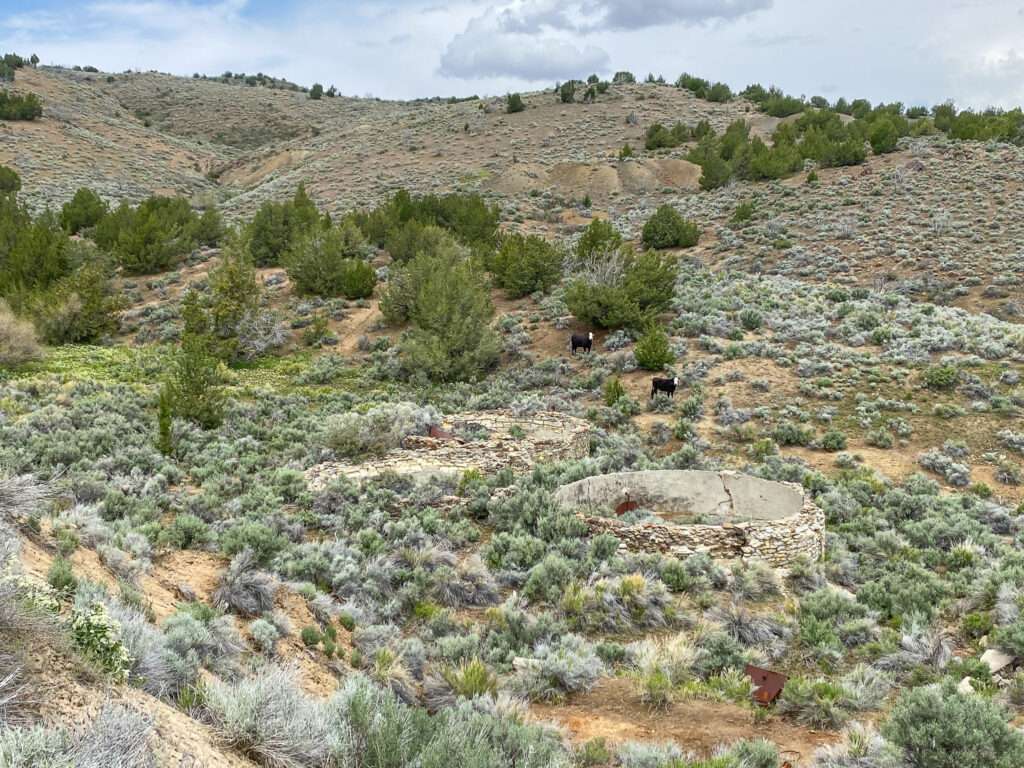

Tungsten
Miners discovered tungsten in 1916 or 1917 and erected a concentrator. By 1919, a small camp formed, although it was not awarded a post office until 1944. Production continued for thirty years and Tungsten became one of the nation’s largest producers.
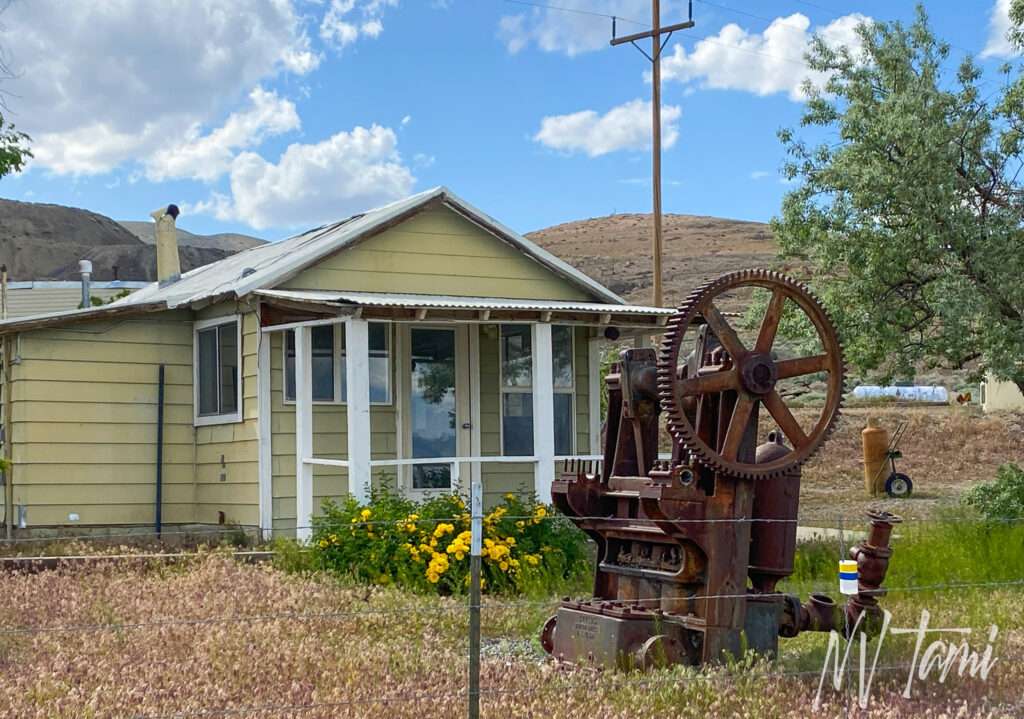
In 1958 the federal government stopped purchasing tungsten, marking the beginning of the end of the settlement. The post office operated until 1962, when the company sold the town’s buildings and the mine’s equipment. Today, the former town sits at the edge of modern mining.
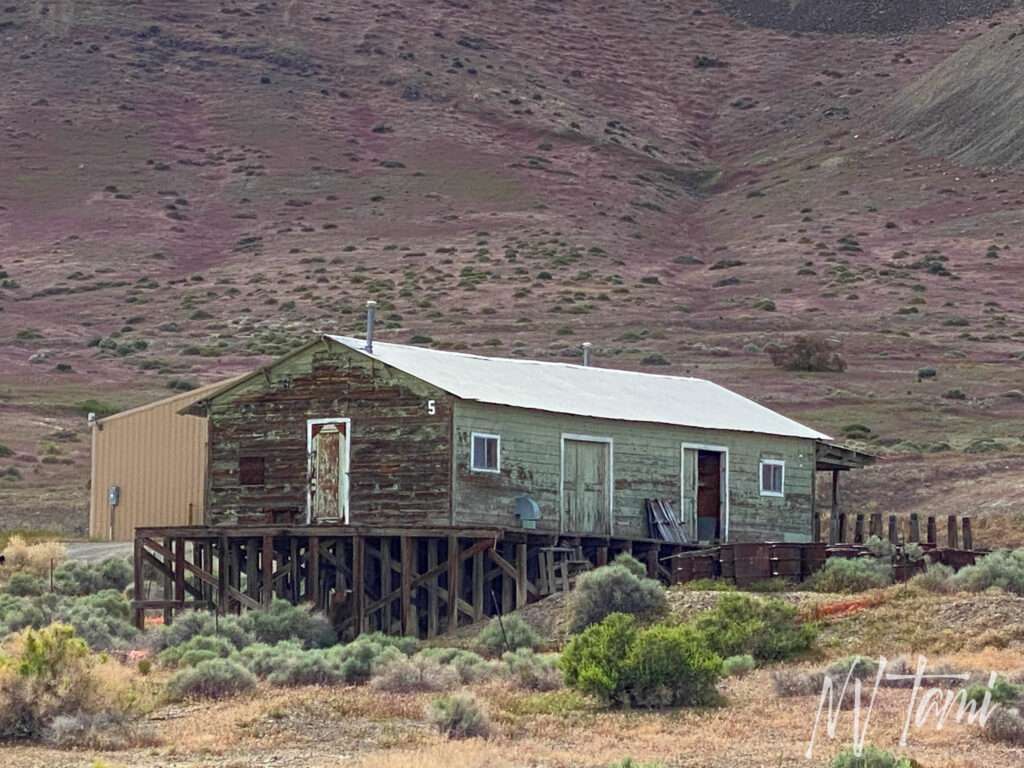

Thunder Mountain
Rising from the Nevada desert, like a mirage along I80, is Thunder Mountain. Creator Frank Van Zant, known as Chief Thunder, created the one-of-a-kind Nevada monument. He turned trash into a wonderland of art, a fusion of industrial art meets The Flintstones.
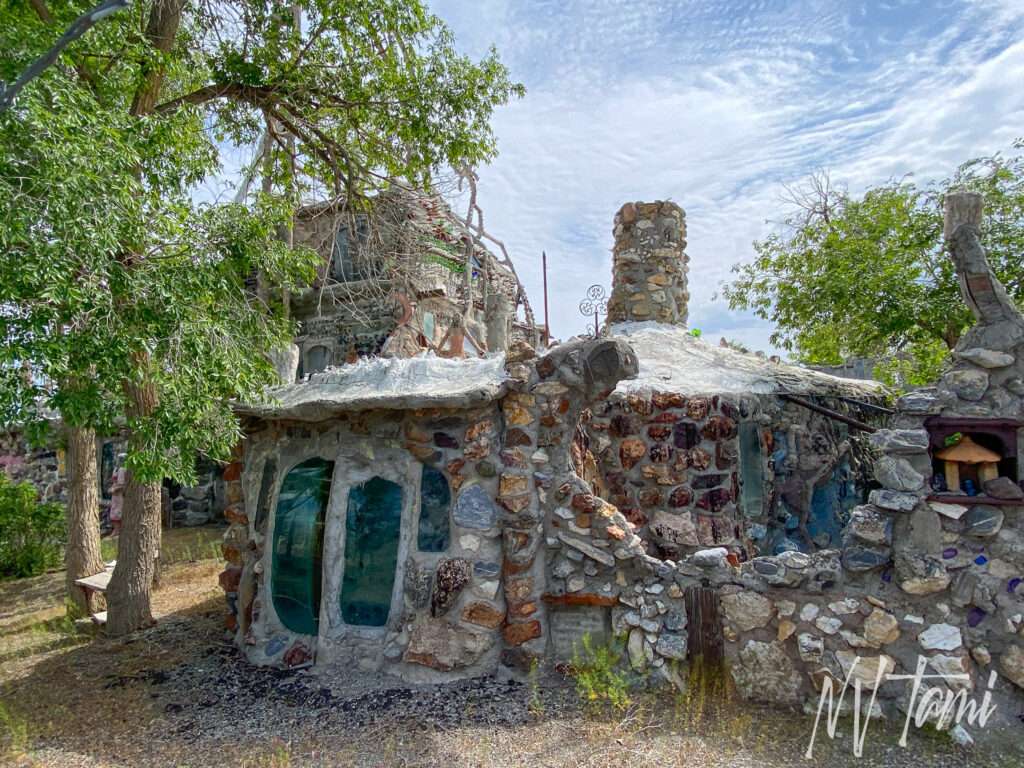
Ghost Towning
Growing up in Idaho, I spent many summers driving across Nevada to visit family in the Gold Country. We would stop for lunch in Winnemucca. By the time we reached Imlay, we were five hours into our drive, and the batteries in our Walkman were dead. My sister and I were perfect angels. Just kidding, we fought and accused each other of daring to look at the other. We created a DMZ across the backseat using audio tapes: Juice Newton, Huey Lewis and the News, and Madonna.

Then the strangest structure would appear, rising from the desert on the south side of I80. It was sci-fi in appearance, like giant bones creating a throne for a mythical god. I would watch for the structure on each trip. In the pre-Internet Dark Age, information was limited, and I would forget about the unique site until the next years trip.

Chief Thunder

(Photo credit: Thunder Mountain)
Frank Van Zant was born in Oklahoma on an Indian reservation and identified as a Creek Indian. After an epiphany, he adopted the name Rolling Mountain Thunder and later added Chief. He left home at age 14 and enlisted in the Civilian Ccnservation Corps.

(Photo credit: Thunder Mountain)
Frank served in WWII, where he was severely burned in a tank in Leipzig. After being discharged, he studied for a year and a half to become a Methodist Church minister but became a police officer in Sutter County, California for two decades. The US Forest Service offered Frank a position plotting maps. During his travels across Nevada, he was able to keep items he came across. He settled in Imlay, not with a great calling, but because his truck chose that place to break down.

Chief Thunder had several wives and eight children. He raised his children to live off the land, but when the schools found out, his last wife moved, taking the kids.

(Photo credit: Thunder Mountain)
Thunder Mountain
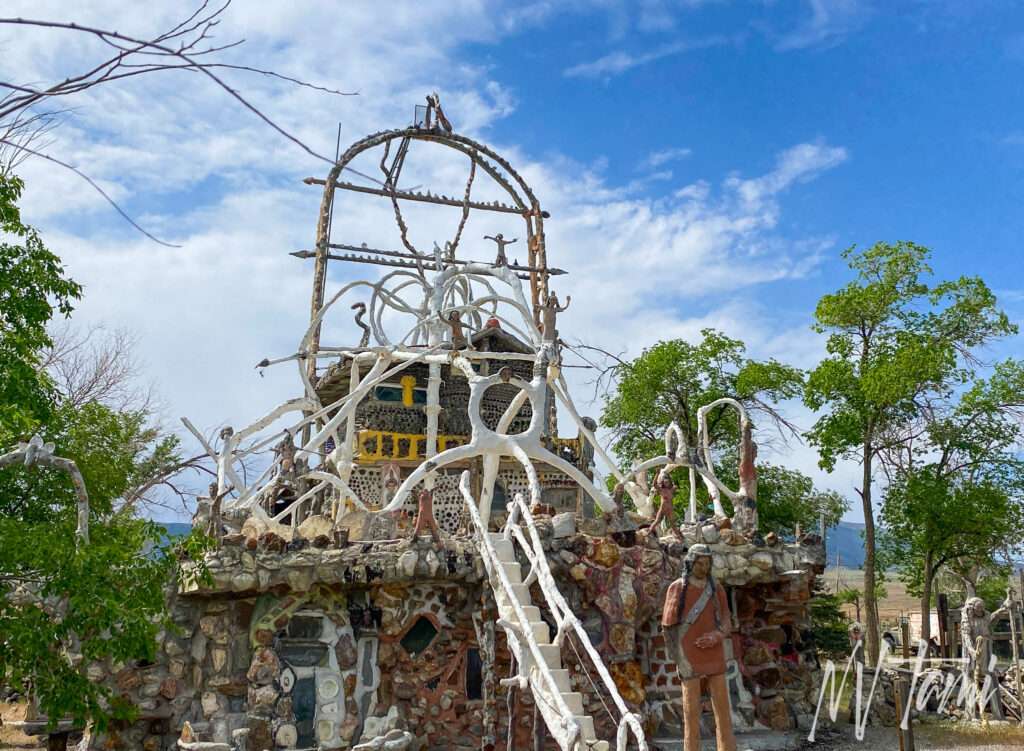
Chief Thunder built his unique memorial to the American Indian beginning in 1969 following a series of dreams and visions.

… a monument to the American Indian, a retreat for pilgrims aspiring to the “pure and radiant heart.”
Thunder Mountain Monument

Thunder Mountain comprised seven buildings, including a three-story hostel for hippies. He used building materials reclaimed from the desert: windshields for picture windows, walls made from bottles, scrap metal into rebar and chicken wire into a statuary.
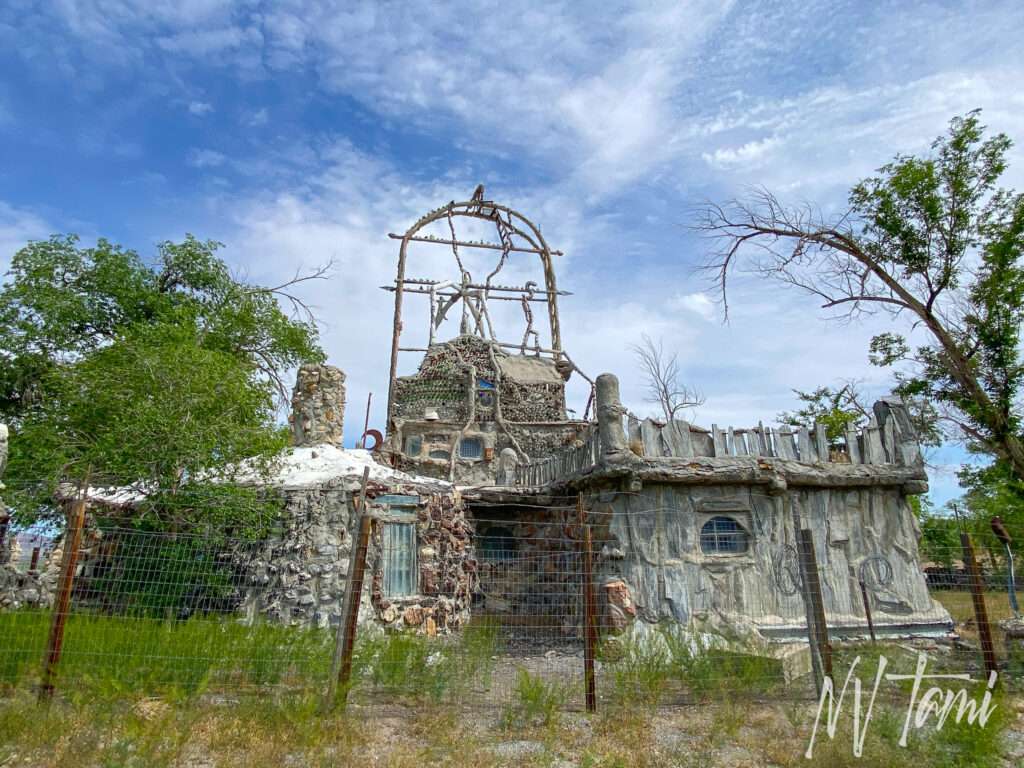


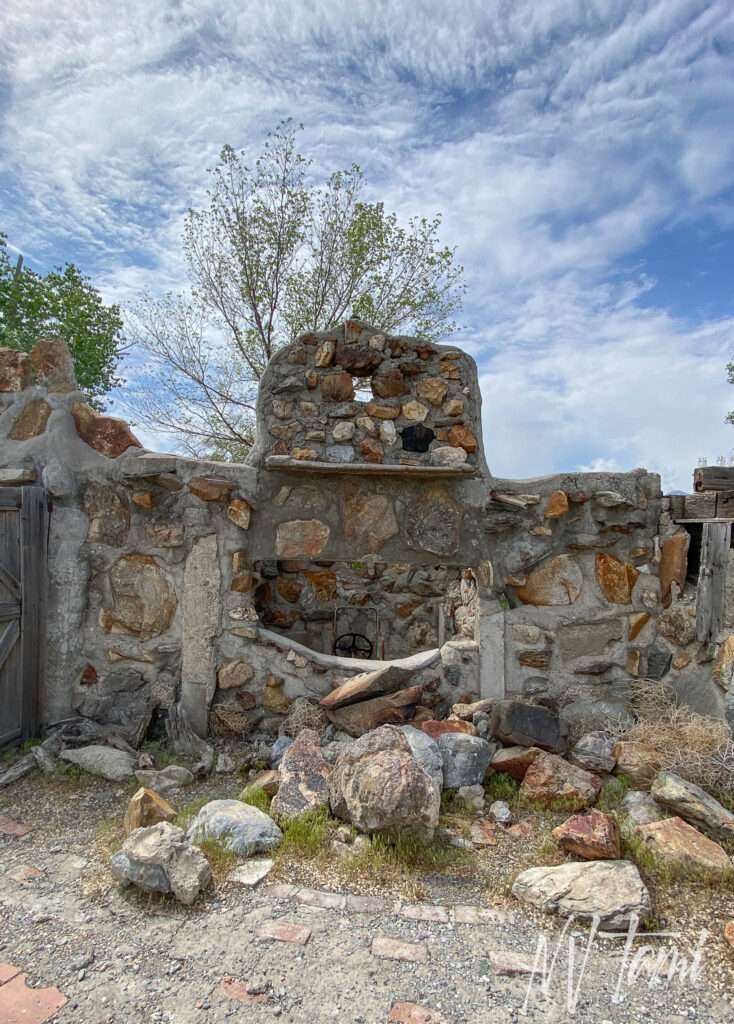
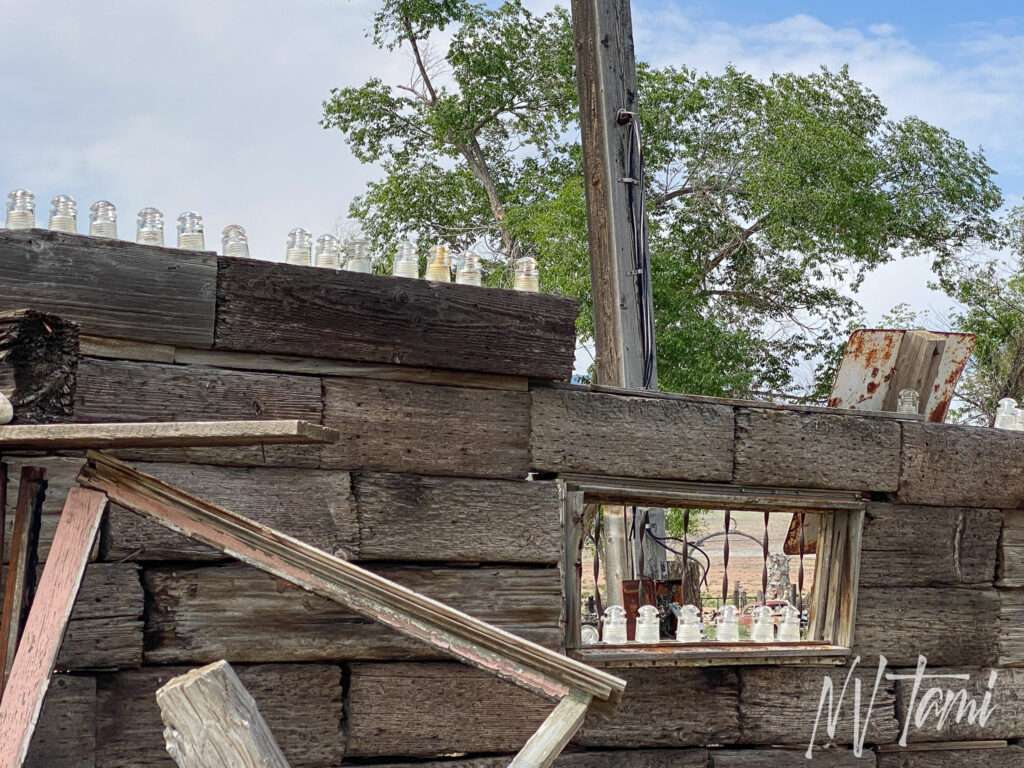
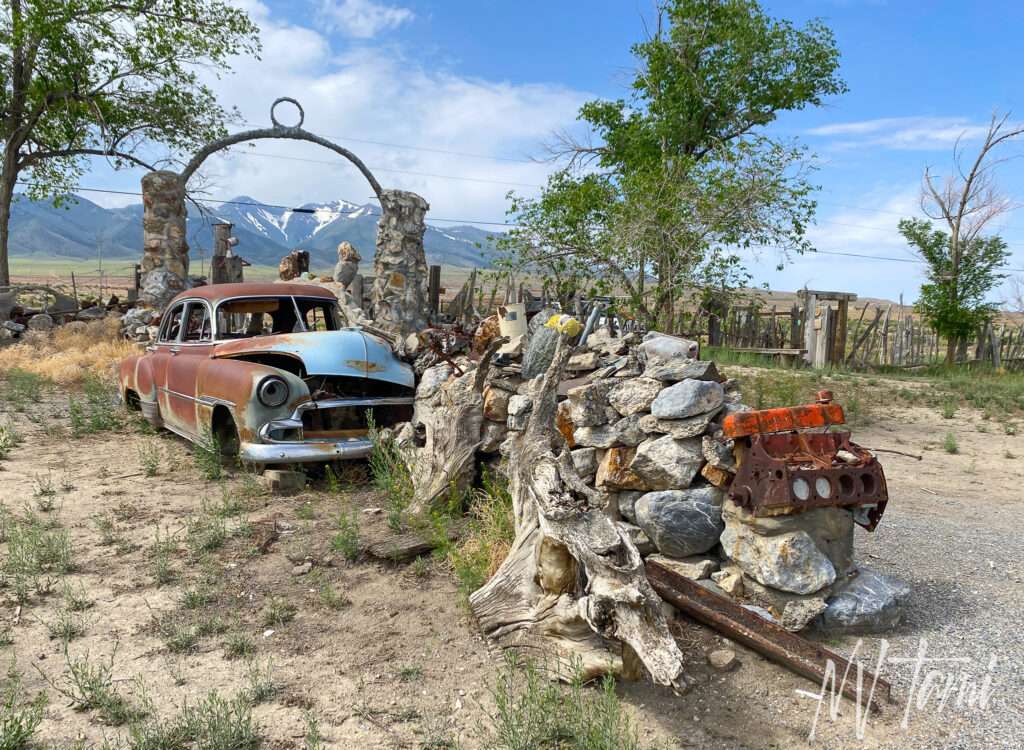
Chief Thunder was named Nevada’s Artist of the Year in 1983. He lived at his monument until his unfortunate death by suicide in 1989.
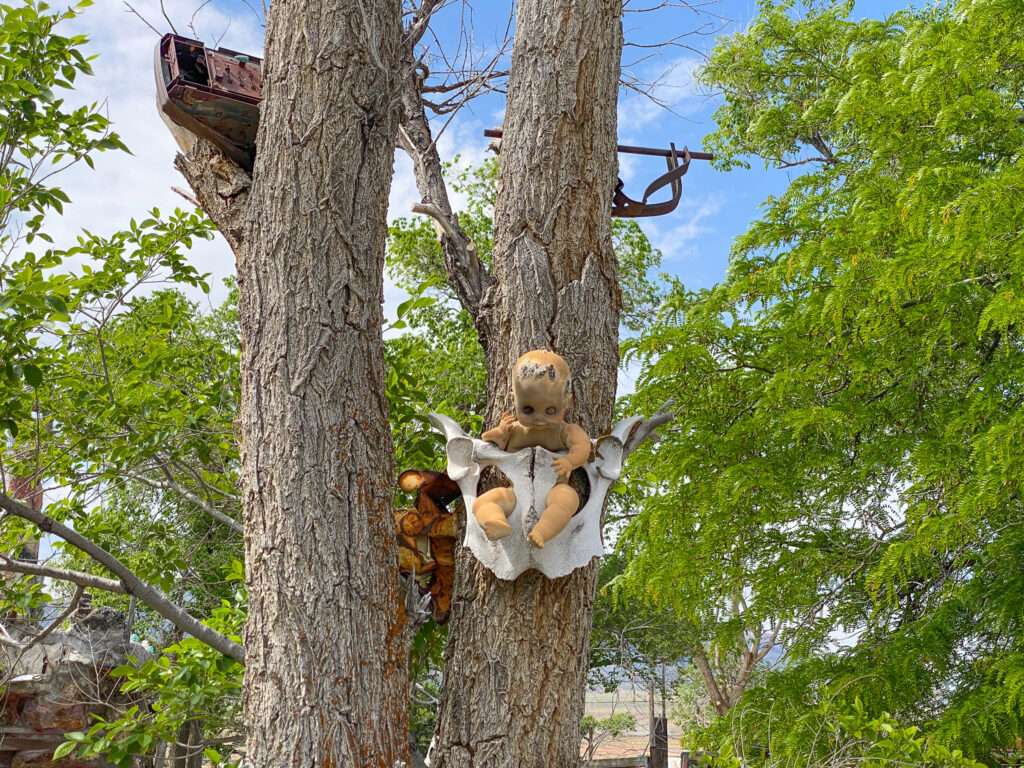
Visiting Thunder Mountain
Once a private home, Thunder Mountain is now open to visitors. The monument is open from sunrise to sunset. Admission is free, and donations are appreciated and help to preserve this piece of Nevada’s history.

WANT MORE GHOST TOWNS?
For information on more than five hundred ghost towns in Nevada & California, visit the Nevada Ghost Towns Map or a list of Nevada ghost towns.
Learn about how to visit ghost towns safely.

References
Follow me on social media:
Jon says
Hi, I’ve been looking at your Nevada Ghost Town content… i’d like to do a little tour based out of Winnemucca and go to some sites… I’ve got an all-wheel-drive Hyundai Santa Cruz, so I can’t get into anything too gnarly. could you suggest a good loop that would be doable? Your help is appreciated. Thank you.
Tami says
Have you seen this article? https://nvtami.com/index.php/2022/11/13/humboldt-pershing-county-ghost-towns/
There was nothing technical I did on either trip, aside from Discovery Mine. That being said, roads this year have been damaged so you never know what you will see.
I am leaving for Reno right now and can think of a specific loop. How many days are you looking and hours each day? What type of things do you like to see?
Anonymous says
Thanks for the reply and the link.. I’m looking for ghost towns, mines and hot springs for two days 4-5hrs a day.Would like to see Unionville. Thanks
Tami says
One day you could do a loop focused around Buena Vista Canyon. Start at Mill City, drive down the east side. You can stop at Star City and Unionvolle. Santa Clara is great but a fair hike.
I highly suggest Humboldt City when you are on I80, it isn’t too far from Winn. Rochester is in the area too, sadly much was most to fire.
The Antelope mining district would be a fun day, a bit of a drive to get there, but the mines are together.
I love Paradise Valley and Midas makes a great day.
You can do Jungo Road, but be warned, the road eats tires.
If it was me I would do the Unionville loop and Paradise.
Jon says
OK paradise in Unionville it is I think I’ll take your advice and skip jungle Road for now until I get some better tires. thanks for all your advice and happy trails. Hope to see you out there!
Tami says
Sounds like a great trip, have a great time!
Fly I-80 / Matt says
The plant picture you took in Humboldt City is undoubtedly Virginia Sweetspire, a plant native to the mid-Atlantic wetlands. It HAD to be planted here deliberately, and the time it tok to fill in up canyon means that it probably came with the people who settled the town. They say it’s drought tolerant (no kidding), and was often used to control erosion, but once it’s established it can be very invasive.
It’s really out of place at this site, and represents a direct, living connection to the people who lived here and tried to make a home in a strange place. It’s as historic as the buildings, or maybe like the apricot trees at Lehman.
(I went the other way, planting Great Basin plants where I live now.)
Matt / Fly I-80 says
The plant picture you took in Humboldt City is undoubtedly Virginia Sweetspire, a plant native to the mid-Atlantic wetlands. It HAD to be planted here deliberately, and the time it took to fill in up canyon means that it probably came with the people who settled the town. They say it’s drought tolerant (no kidding), and was often used to control erosion, but once it’s established it can be very invasive.
It’s really out of place at this site, and represents a direct, living connection to the people who lived here and tried to make a home in a strange place. It’s as historic as the buildings, or maybe like the apricot trees at Lehman.
(I went the other way, planting Great Basin plants where I live now.)
Tami says
Thank you, it was beautiful. My gardening group said it was a chokeberry.
I would love if it was a remanent of early settlers.
Scott Lyman says
Wow that was an impressive article! There is lots of gold silver mercury and lead mines in Idaho but not many with that level of preservation or that much history. Well done!
Tami says
Thank you Scott. I didn’t think of mercury in Idaho. There is a great one in Fish Lake, but mill was taken down as a superfund site.
Anonymous says
Thank you for all the great posts! If it wasn’t so hot right now I’d be heading to Nevada!!
Is the map of places you’ve visited up to date. I don’t think it has places like the East Star, Freckles and Senator mines. Would you ever consider leading a trip to visit a few of the locations that you have posted?
Tami says
Welcome, I am glad you enjoyed my posts. I wouldn’t go to southern Nevada right now. The north isn’t nearly as bad.
The map isn’t up to date. I fell behind and now it overwhelms me. The biggest issue is figuring where to drop the pins as it isn’t calibrated for GPS. That is intentional as I didn’t want to give list coordinates, but is cumbersome.
It is on my list to catch up it, I will probably start from this years trips which include Freckles.
I led a few trips with friends, but not organized. Most are on BLM or forest service land, and they have strict regulations and permitting process making it difficult to guide trips. There are some great off-road groups, Jeep specific or general off-road. One of my friends leads trips through Churchill County (they do all the BLM stuff). https://ccpr.nvexpeditions.com/?fbclid=IwAR3VZzX1Cx3kJCAFnEJXZCkWK4oTatZPMZf79sq4_0f6COwXC9wXClrObSI
Cliff Barnhouse says
I’m catching up on some of your articles and as usual, another great one. I’ve visited the Pershing, Montgomery and Freckles mines several times over the years. First time I visited the Pershing Mine, the rotary mill was still there. It went away during the scrapper craze. Somewhere in my stash I have some pictures.
I enjoy seeing places I visited in your articles and learning more about them. Thanks again for your great work.
Tami says
Wow, I wish I had seen the rotary mill.